Introduction
In today’s rapidly evolving technological landscape, the role of an RPA Developer has become increasingly pivotal for organizations striving to enhance operational efficiency through automation. These specialized IT professionals are at the forefront of crafting and deploying Robotic Process Automation (RPA) solutions that streamline repetitive tasks, thereby driving productivity and reducing costs. By collaborating closely with business analysts and stakeholders, RPA Developers identify key processes for automation, ensuring solutions are tailored to meet organizational needs and compliance standards.
This article delves into the multifaceted responsibilities of RPA Developers, from analyzing business processes and designing automation workflows to coding, testing, and integrating RPA solutions with existing systems. It also highlights the essential skills required for success in this dynamic field and explores the promising career paths available for those who excel in RPA development. Through real-world examples and expert insights, discover how RPA Developers play a crucial role in transforming routine tasks into seamless automated operations, ultimately empowering organizations to achieve their strategic goals.
What is an RPA Developer?
An RPA Developer is a specialized IT professional dedicated to crafting, developing, and deploying Robotic Process Automation (RPA) systems. They are pivotal in automating repetitive tasks within an organization, significantly boosting operational efficiency and productivity. By collaborating closely with business analysts and stakeholders, RPA Developers pinpoint processes suitable for mechanization, ensuring that the implementations align with organizational requirements and compliance standards. For instance, companies like St. James Winery have seen marked improvements in production efficiency and labor costs through RPA implementation. This success highlights the significance of ongoing observation and administration, as mechanization is not a set-it-and-forget-it solution. The partnership between RPA Developers and stakeholders is essential, as it promotes trust and ensures that the initiatives for mechanization are well-integrated and effective in achieving business goals. As highlighted by specialists, the collaboration between advanced technologies and strategic partnerships can enhance operational initiatives, making them more robust and aligned with business goals.
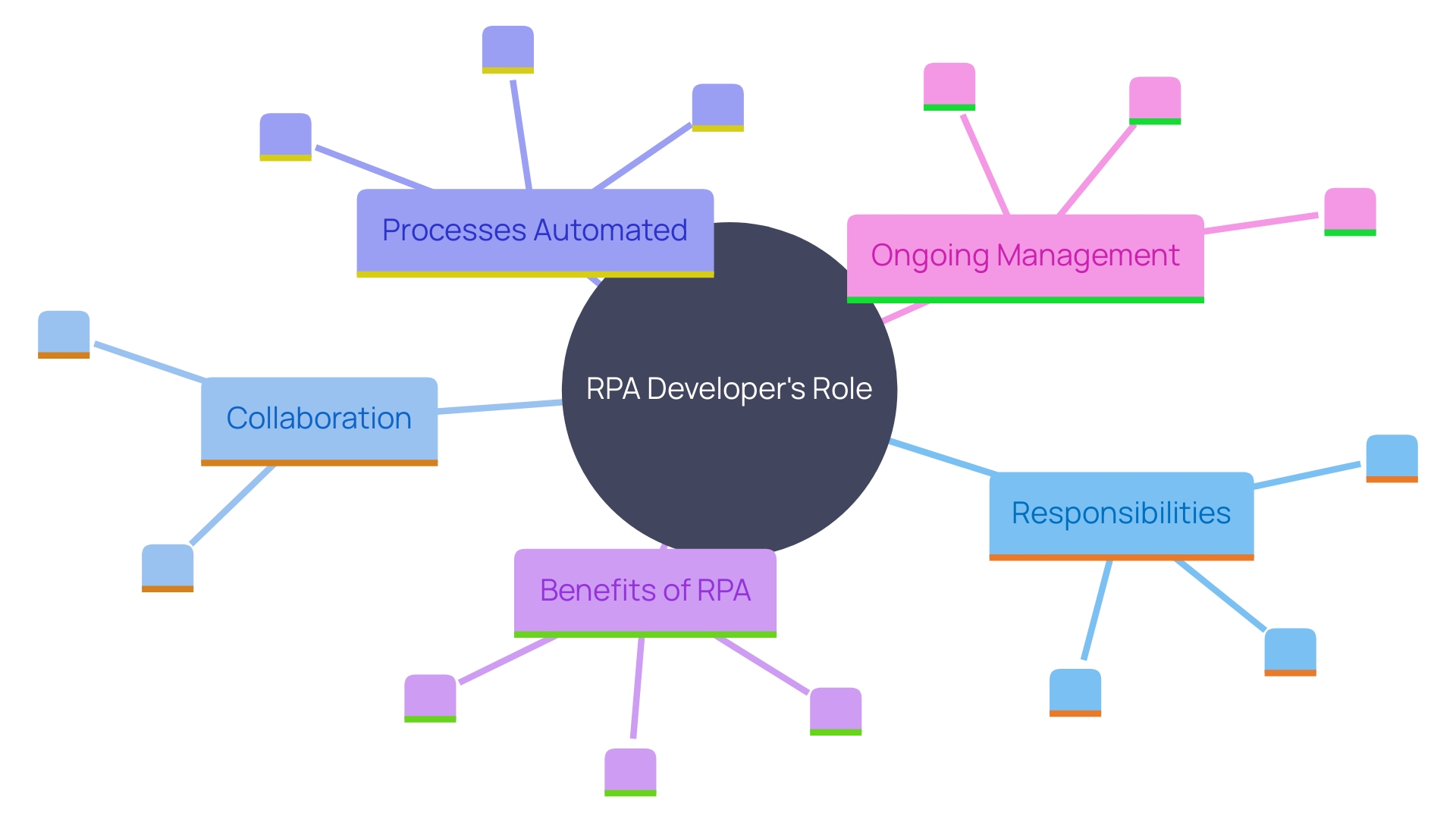
Key Roles and Responsibilities of an RPA Developer
RPA Developers play a crucial role in optimizing business processes and enhancing efficiency through mechanization. Their responsibilities encompass several critical tasks:
- Analyzing Business Processes: RPA developers begin by meticulously examining existing business processes to identify opportunities for automation, ensuring that only the most repetitive and time-consuming tasks are targeted for automation. This crucial step aids in maximizing the return on investment from RPA initiatives.
- Designing RPA Solutions: They design tailored RPA solutions that align perfectly with the unique requirements of the business. This involves selecting the appropriate tools and technologies to create strong automated processes.
- Creating Scripts for Automation: Utilizing top RPA tools, developers generate scripts and workflows. This phase includes writing code, configuring bots, and establishing the automation environment to ensure that tasks are executed flawlessly.
- Testing and Debugging: Rigorous testing and debugging are essential to guarantee the functionality and reliability of the automated processes. This step helps in identifying and rectifying any issues before deployment, ensuring smooth operation in a live environment.
- Integration with Existing Systems: RPA solutions must seamlessly integrate with the organization’s existing systems and applications. Developers ensure that the automation tools work harmoniously with other software, databases, and IT infrastructure.
- Maintaining and Monitoring Deployments: After deployment, RPA developers are responsible for maintaining and monitoring the automated systems to ensure they perform optimally. Continuous monitoring allows for quick identification of any performance issues or areas for improvement.
- Documenting Procedures: Thorough documentation of automated procedures and solutions is vital for future reference and compliance. This encompasses generating comprehensive documentation of the workflows, configurations, and any modifications implemented throughout the process lifecycle.
By fulfilling these roles, RPA developers play a pivotal part in helping organizations achieve their operational efficiency goals. They utilize their technical knowledge to convert routine tasks into automated systems, ultimately enhancing productivity and allowing employees to concentrate on more strategic activities.
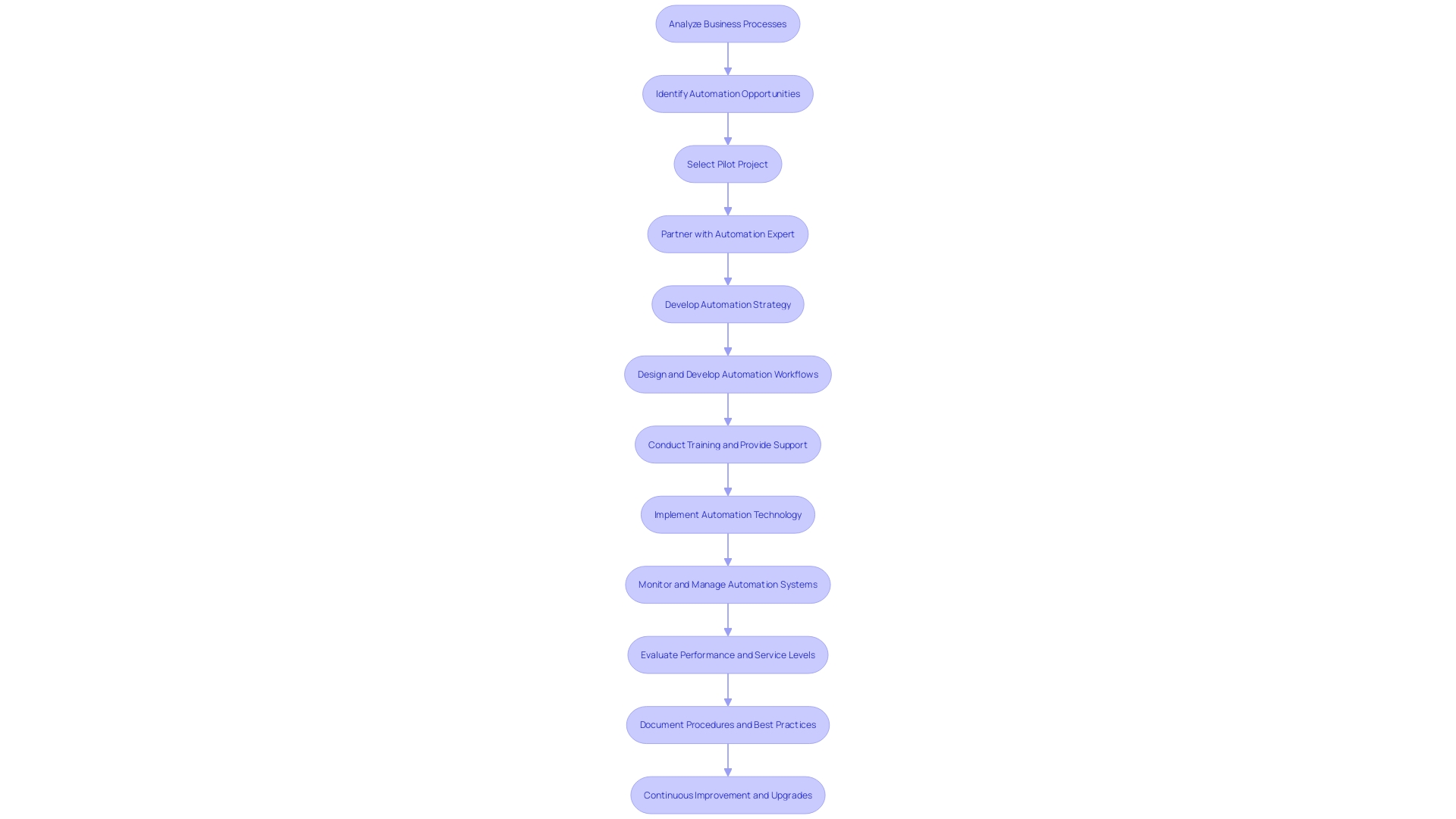
Process Analysis and Identification
The initial stage for an RPA Developer includes a comprehensive examination of business activities to determine which tasks are suitable for mechanization. This entails evaluating the volume, frequency, and complexity of tasks. Interacting with stakeholders and collecting information on existing operations aids in identifying bottlenecks and inefficiencies that can be addressed through RPA. Starting with smaller tasks before progressing to more complex workflows is a strategic approach. Continuous monitoring and documentation of results are crucial to ensure goals are met and to capture lessons learned for future projects. Smart technology, integrating RPA and AI, can greatly improve workflows, increase productivity, and support informed decision-making. This synergy is essential for realizing the complete potential of digital transformation, as demonstrated by companies effectively integrating intelligent workflows to manage supply chain operations.
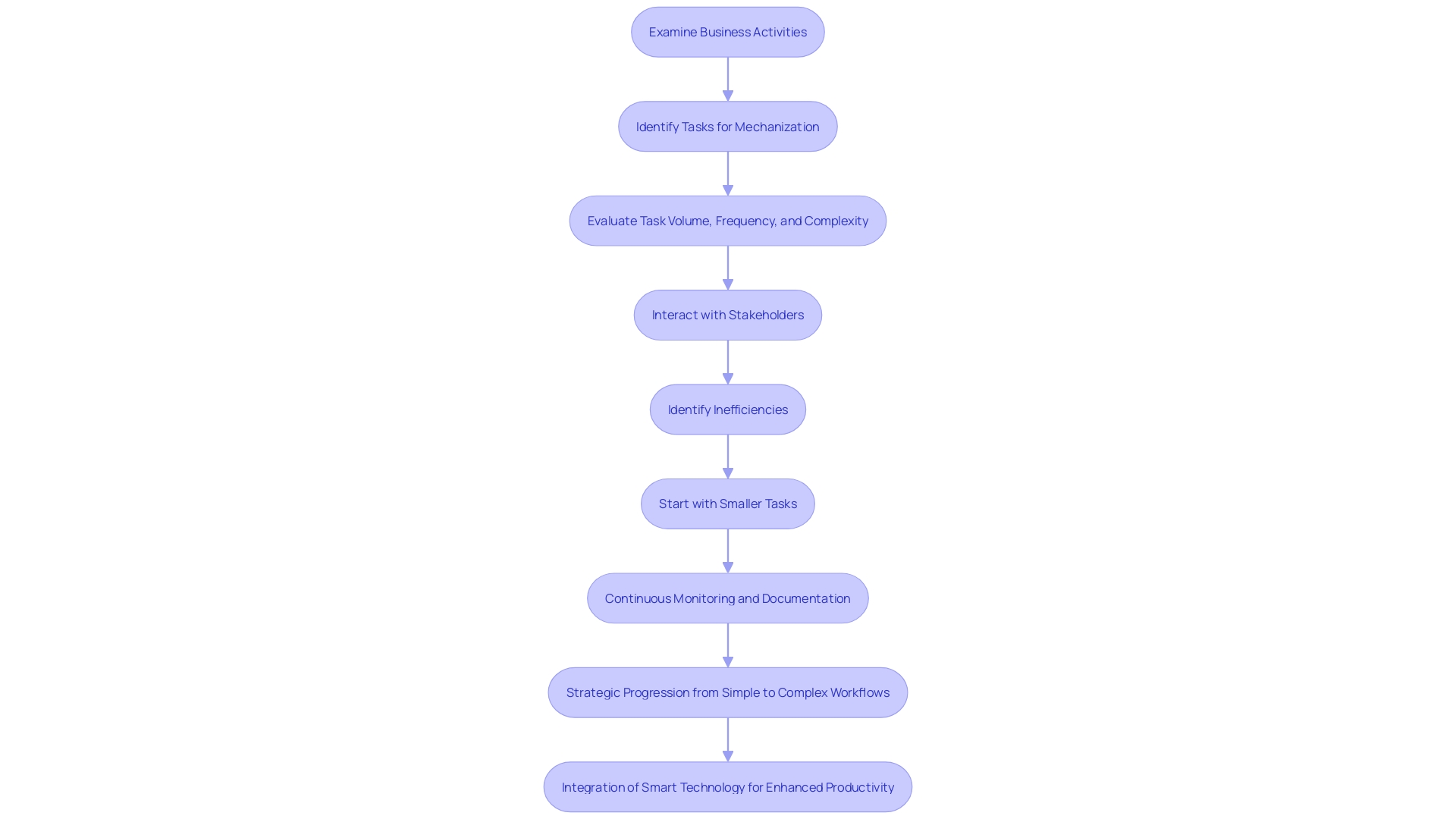
Designing and Developing RPA Solutions
Once processes designated for mechanization are identified, RPA developers move on to designing customized RPA solutions. This phase involves creating detailed specifications and workflows that meticulously outline the operational blueprint of the mechanization. For instance, developers may leverage advanced simulation models, like those from 1X Technologies, to predict real-world outcomes based on sensor data, ensuring accuracy and reducing the ‘sim2real gap’.
After the design phase, developers use RPA tools to build the automated process. This involves writing precise scripts capable of emulating human actions within the targeted processes. This step is similar to how KUKA, a global leader in automation, supports their offerings with comprehensive training, system engineering, and simulation, ensuring seamless implementation and operational efficiency.
By integrating these advanced tools and strategies, RPA developers not only replicate human actions but also enhance the scalability and flexibility of automated systems, allowing for rapid expansion and adaptation to new requirements with minimal effort.
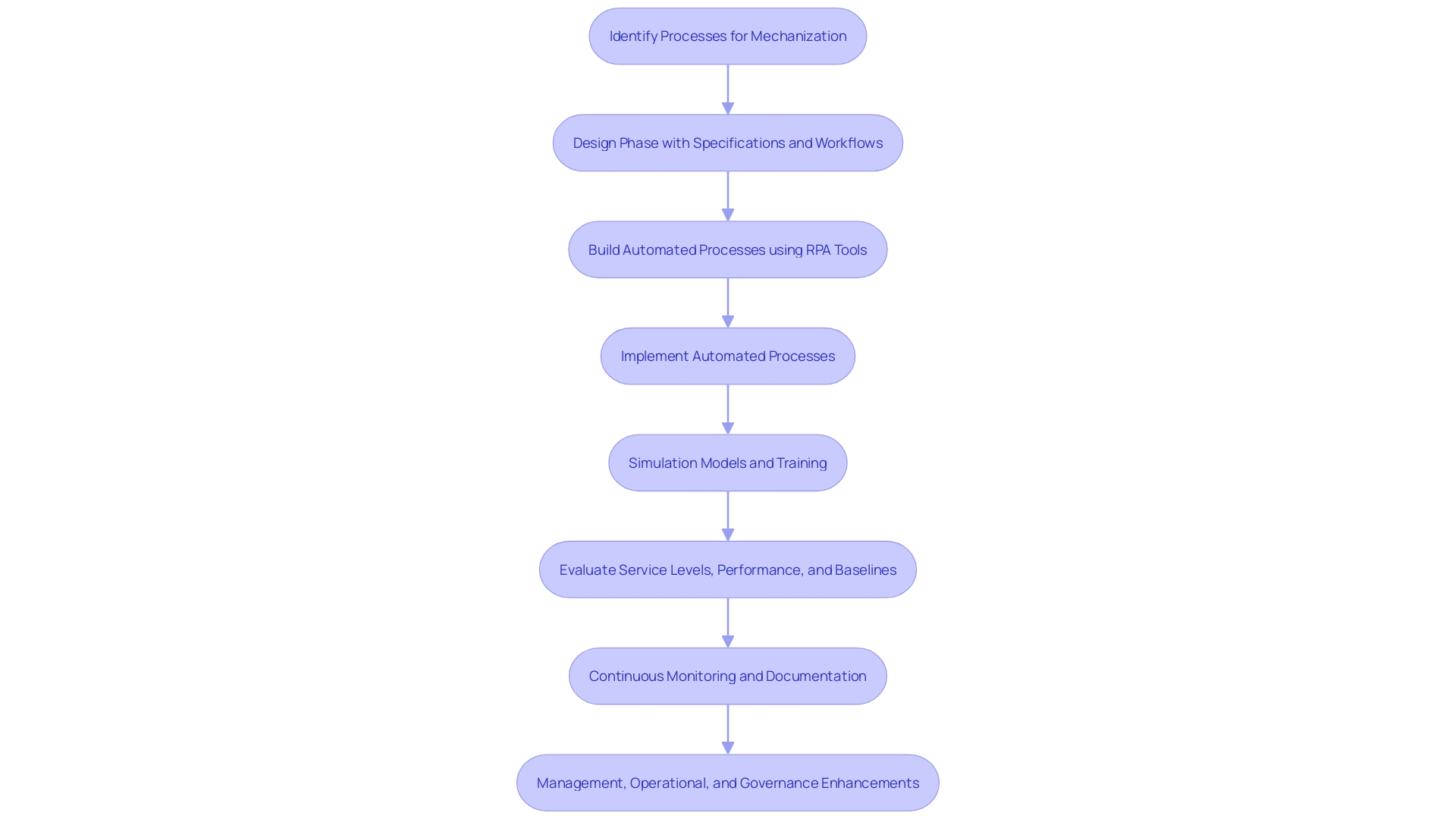
Coding and Scripting
RPA developers are frequently needed to create customized approaches by writing code or scripts, enhancing the functionality of RPA tools to meet specific business requirements. Mastery of programming languages such as Python, Java, or. NET is crucial for this customization. The ability to code allows developers to implement complex logic and create tailored solutions that go beyond the standard capabilities of RPA platforms. This guarantees that automated systems are not only efficient but also extremely flexible to the distinct challenges encountered by organizations. Cultivating these abilities strengthens the workforce and enhances operational procedures, utilizing the true potential of AI-driven technology.
Testing and Debugging
Once the automation is developed, thorough testing becomes indispensable. RPA developers participate in various testing stages to guarantee that the system operates exactly as planned. This process involves unit testing, which verifies individual components, integration testing to ensure different parts function together seamlessly, and user acceptance testing to confirm the result meets business requirements. Debugging plays a crucial role, as it involves identifying and resolving any issues or errors in the automation. This rigorous approach ensures consistency, accuracy, and comprehensive test coverage, significantly reducing the risk of human error and enhancing overall efficiency.
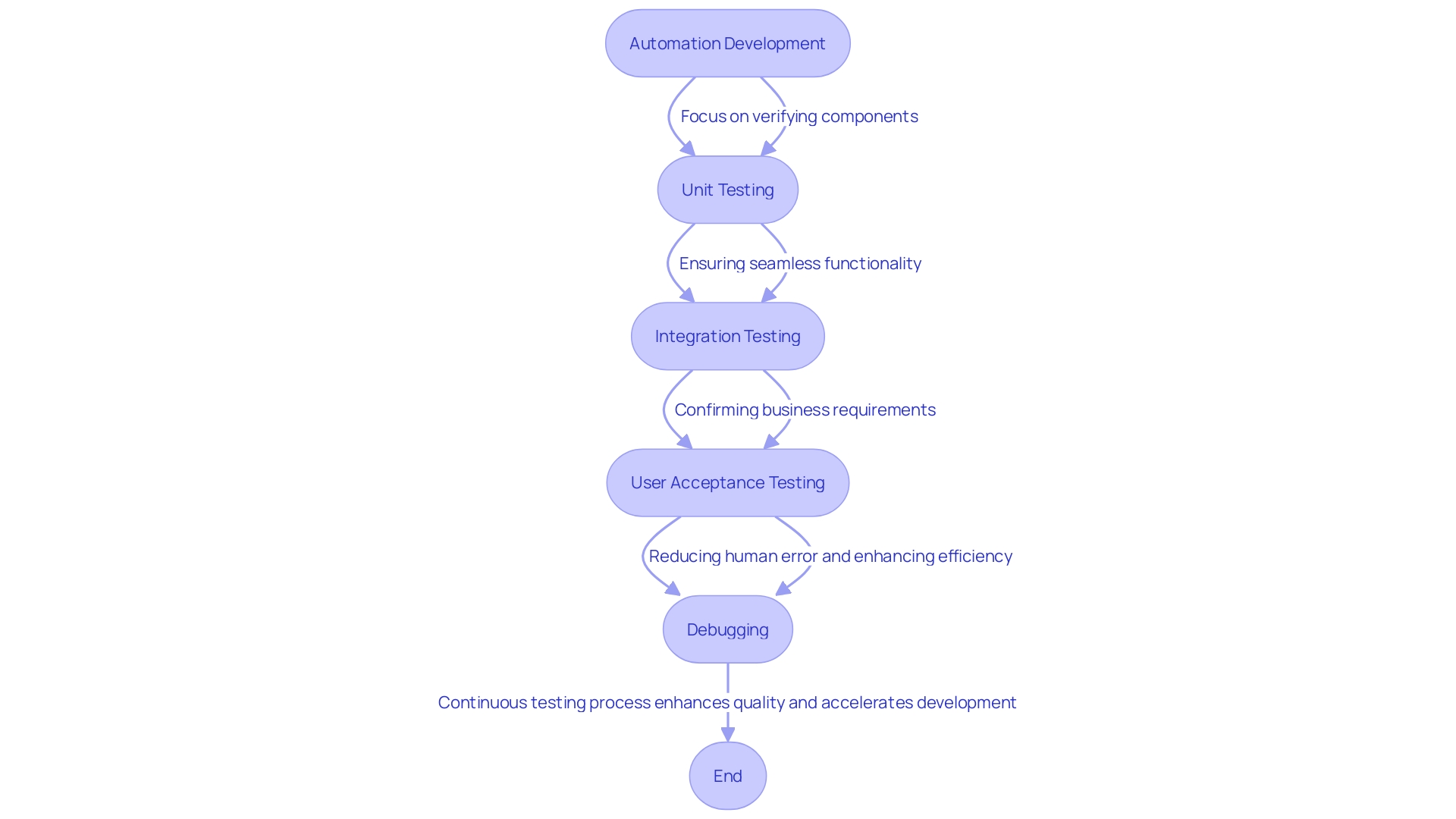
Integration with Existing Systems
For RPA solutions to be effective, they must seamlessly integrate with existing systems and applications. RPA developers are essential in linking automated workflows with other software, databases, and tools within the organization. This integration is vital for ensuring that data flows smoothly between systems and that automated tasks can interact with other business operations.
The importance of integration becomes evident in real-world applications. For example, the partnership between Redox and Ambience significantly improved the adoption of Ambience products by leveraging Redox’s expertise in healthcare interoperability standards. This allowed Ambience to focus on perfecting their products rather than managing integration challenges with each new customer. Similarly, the HUD’s innovative use of RPA to monitor housing contract expirations showcased how RPA could overcome constraints of outdated systems, achieving operational resilience and efficiency.
Moreover, a staggering 90% of mechanization projects fail due to technical issues, highlighting the importance of seamless integration. Successful integration not only streamlines workflows but also saves time and money. For instance, the healthcare sector, which excels in workflow optimization, observes 93% of hospitals adopting process streamlining to enhance operational efficiency.
Incorporating RPA into existing systems requires strategic partnerships and expert guidance. As the technological environment changes, the collaboration between mechanization and sophisticated methods becomes ever more crucial. Organizations that embrace this holistic approach position themselves for success in the ever-evolving automation landscape.

Maintenance and Monitoring
Post-deployment, RPA Developers are responsible for the ongoing maintenance and monitoring of RPA solutions. This involves tracking performance metrics such as robot utilization, throughput, cycle time, error rates, and cost savings. Ensuring compliance with business rules and adjusting as needed to accommodate changes in processes or technology is crucial.
Regular monitoring, as emphasized by Mark Twain’s approach to getting ahead by starting, helps establish a proactive foundation. By setting an accurate baseline, developers can confidently forecast and make effective maintenance plans. This proactive strategy aligns with the predictive maintenance approach, preventing operational issues before they escalate.
Organizations must close any management, operational, and governance gaps with additional software tools, clear roles, and responsibilities to ensure effective RPA function. As mechanization continues to evolve, maintaining a partnership between human oversight and RPA is essential for stability and efficiency.
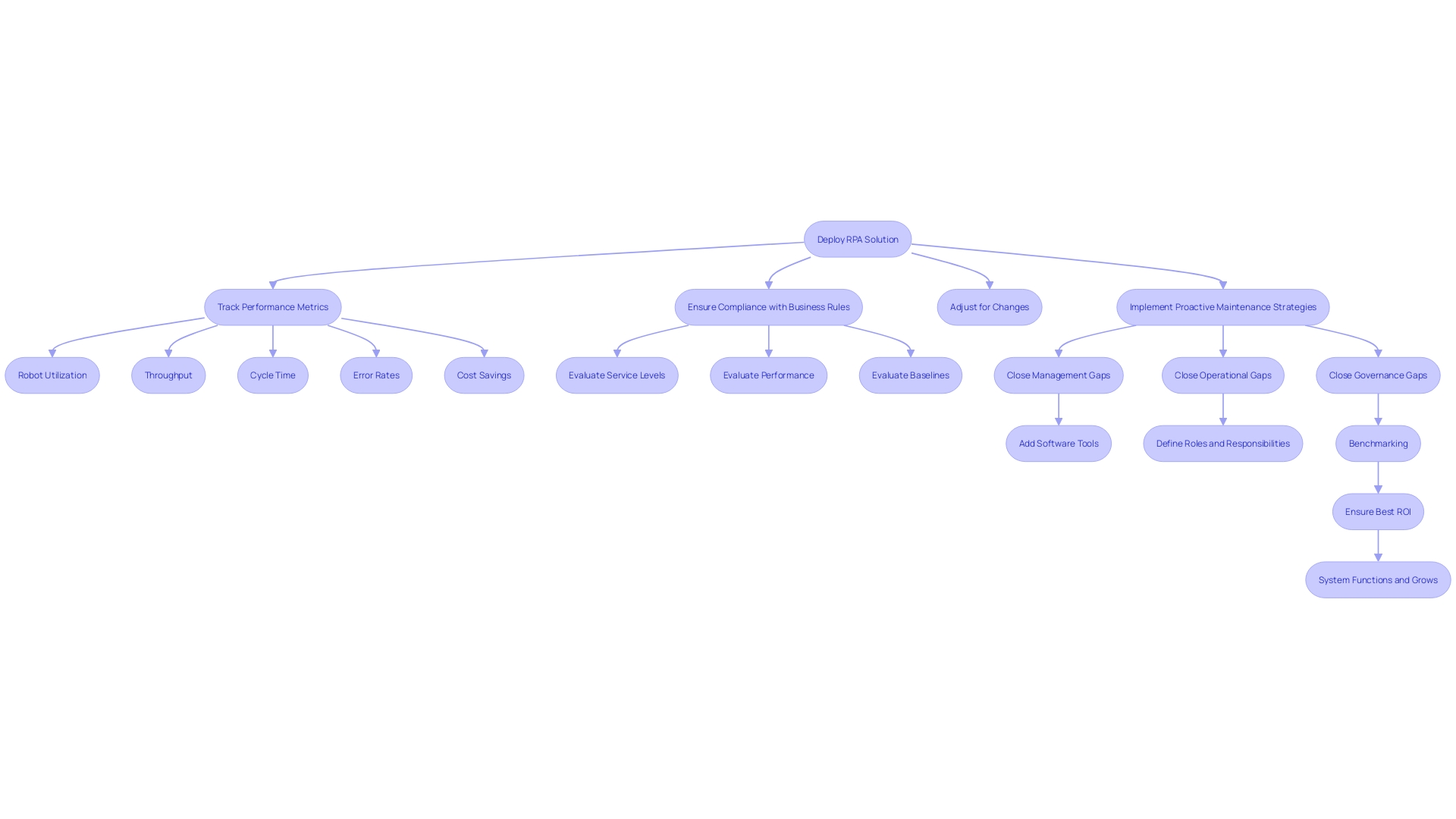
Documentation
Thorough documentation is a critical task for RPA Developers, as it forms the foundation for successful automation projects. This method entails outlining design specifications, code, testing protocols, and maintenance procedures. Comprehensive documentation ensures consistency and accuracy, which is vital for compliance and future updates. It also improves cooperation among team members, enabling more efficient and effective development activities.
Recording the complete procedure not only decreases mistakes and oversights but also acts as a helpful asset for integrating new team members, greatly shortening the time required for them to become efficient. By leveraging AI-driven tools, developers can maintain up-to-date documentation that accurately reflects the current state of the codebase. This method facilitates the smooth incorporation of automated systems into current workflows, aligning with the strategic objectives of the organization and ensuring the stability and efficiency of RPA initiatives.

Essential Skills for RPA Developers
Successful RPA Developers possess a unique set of skills that set them apart. They have:
- Strong Analytical Abilities: These are essential for assessing processes and determining their automation potential.
- Programming Proficiency: Knowledge of programming languages relevant to RPA tool development is crucial, including languages like Java within top-tier categories.
- Familiarity with RPA Tools: Proficiency in tools like UiPath, Blue Prism, or Automation Anywhere is necessary. These platforms are essential for implementing efficient mechanization approaches.
- Problem-Solving Skills: The capability to troubleshoot and enhance automated solutions is essential for guaranteeing smooth operation and addressing problems effectively.
- Effective Communication Skills: These are necessary to collaborate with stakeholders and convey technical information clearly. Knowledge-sharing meetings and workshops play a key role in fostering this communication.
Moreover, RPA developers are at the forefront of technological integration, often working with evolving platforms and participating in continuous learning. This dynamic environment not only challenges them intellectually but also allows them to make significant impacts by streamlining operations and improving efficiency. As the demand for skilled RPA developers grows, so do the opportunities for making a meaningful contribution to the field.
Career Path and Job Roles for RPA Developers
The career trajectory for RPA Developers is multifaceted, often commencing with positions such as Junior Developer or Business Analyst. As professionals acquire experience and knowledge, they progress to Senior Developer roles or managerial positions, supervising extensive project implementations. Notably, the field offers specialization opportunities in areas like RPA architecture or consultancy, where seasoned professionals can lead organizations in strategizing and implementing automation initiatives. Continuous learning and adaptation are pivotal in this dynamic career path, reflecting the ever-evolving nature of technology. According to recent statistics, the demand for AI and ML specialists has surged by 35% year-over-year, underscoring the critical need for skills in developing and managing AI/ML models. This trend is mirrored in the RPA domain, where technical skills are highly valued and essential for driving business efficiencies and innovation. Moreover, the global tech sector has expanded significantly, with the number of professional developers worldwide reaching approximately 13.4 million by 2023. This growth highlights the increasing opportunities for RPA Developers to make significant impacts within their organizations. As the industry continues to evolve, professionals equipped with the right blend of technical acumen and business insight will find rewarding and intellectually stimulating careers in RPA development.
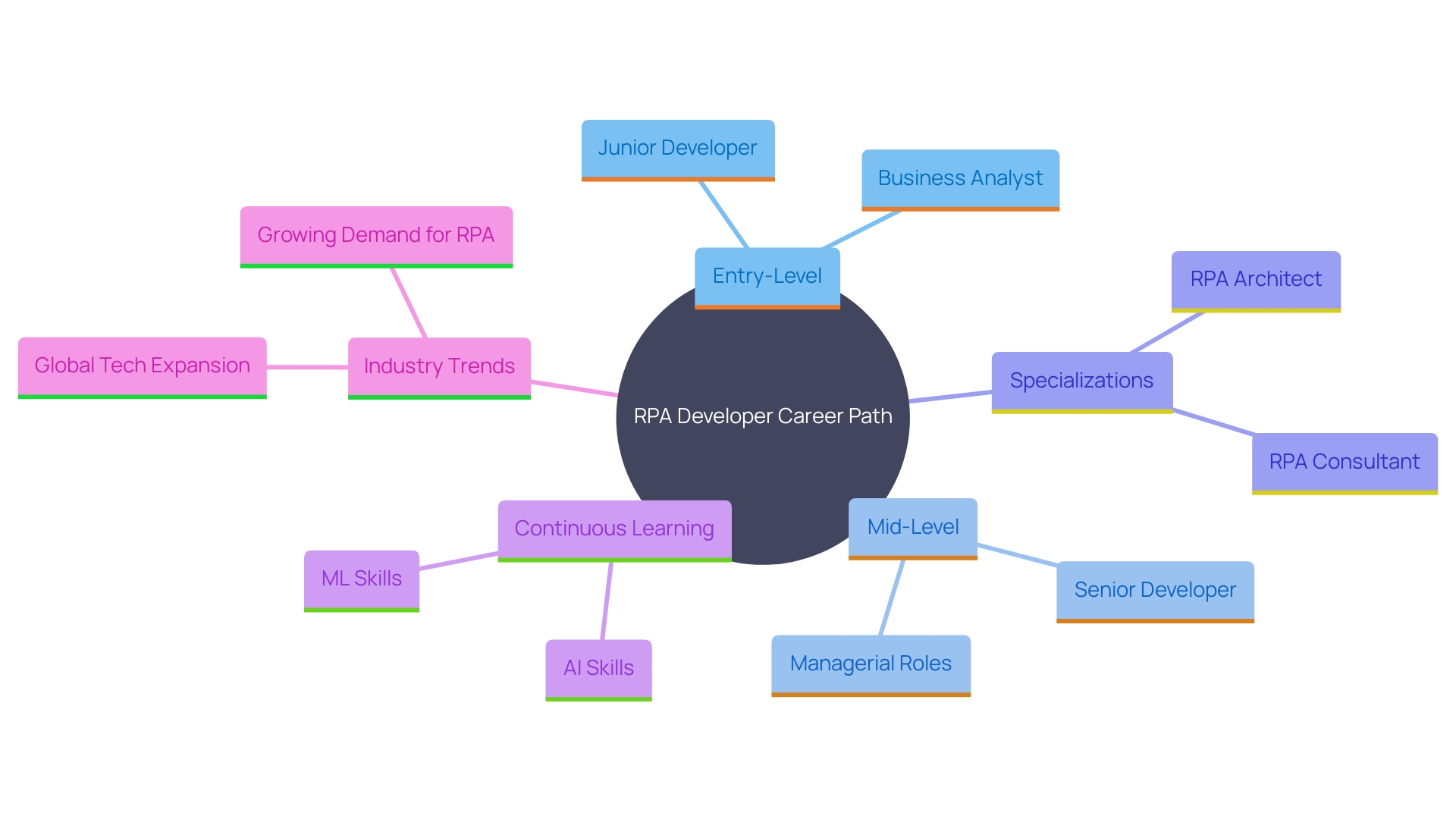
Conclusion
The role of an RPA Developer is integral to the advancement of automation within organizations, driving efficiency and enhancing productivity. By meticulously analyzing business processes, designing tailored solutions, and ensuring seamless integration with existing systems, RPA Developers empower organizations to optimize their operations. The collaboration between developers and stakeholders is essential, fostering an environment where automation initiatives can thrive and deliver measurable results.
Maintaining and monitoring RPA solutions post-deployment is equally important, as it ensures that automated processes continue to meet evolving business needs. Through rigorous testing, thorough documentation, and proactive maintenance, RPA Developers can safeguard the integrity and efficiency of automation efforts. Furthermore, the demand for skilled RPA Developers is on the rise, reflecting the broader trend in technology toward increased automation and intelligent workflows.
In conclusion, RPA Developers are not just technical experts but strategic partners in the journey toward operational excellence. By embracing the opportunities presented by automation, organizations position themselves to achieve their strategic goals and remain competitive in an ever-evolving landscape. The future of work is increasingly automated, and with the right talent in place, businesses can unlock new levels of efficiency and innovation.
Introduction
In an era where efficiency and accuracy are paramount, automation in financial services has emerged as a game-changer. By streamlining repetitive tasks, financial institutions can significantly enhance operational efficiency, resulting in faster processing times and reduced human error. This shift not only improves compliance with regulatory standards but also allows employees to focus on strategic decision-making and customer engagement.
From transforming mundane tasks into productive activities to fostering a culture of continuous innovation, automation is reshaping the landscape of financial services. Explore how leading institutions like Capital One and JPMorgan Chase are leveraging AI-powered technologies to revolutionize their operations, ensuring sustained growth and customer satisfaction. Discover key areas for automation, the challenges involved, and best practices to successfully implement these technologies, paving the way for a more agile and competitive financial sector.
Benefits of Automation in Financial Services
Automation in monetary services significantly enhances operational efficiency by streamlining repetitive tasks. This transformation leads to faster processing times, reduced human error, and improved compliance with regulatory standards. By incorporating mechanized tools, monetary organizations can distribute resources more efficiently, enabling personnel to concentrate on tactical decision-making and client interaction.
For instance, Capital One, one of the largest retail banks in the United States, has fully embraced digital transformation. In 2020, Capital One became the first U.S. bank to leave its information centers and shift completely to the cloud. This move has allowed over 50,000 employees to collaborate seamlessly and automate work across various departments, including finance, risk management, and legal. Such significant changes not only enhance operational efficiency but also foster a culture of continuous innovation.
Furthermore, automation tools like QuickBooks AI, which includes features such as Intuit Assist, help identify trends and recommend solutions, enabling financial professionals to streamline processes and provide better customer experiences. AI applications have already demonstrated a beneficial influence on business, with 91% of firms observing that AI and large information integration has assisted their operations, according to recent CFA Institute research.
Additionally, AI-powered technologies are transforming mundane tasks into more productive activities. For example, SeatGeek has reduced its expense management workload from 20 hours per week to just one hour by leveraging AI tools, allowing finance teams to focus on more strategic tasks rather than routine data entry.
Overall, by utilizing AI and automated processes, banking organizations can improve customer experiences by delivering prompt and precise services, resulting in greater satisfaction and loyalty. With ongoing advancements and a comprehensive approach to risk management, the financial sector is well-positioned to harness these technologies for sustained growth and innovation.
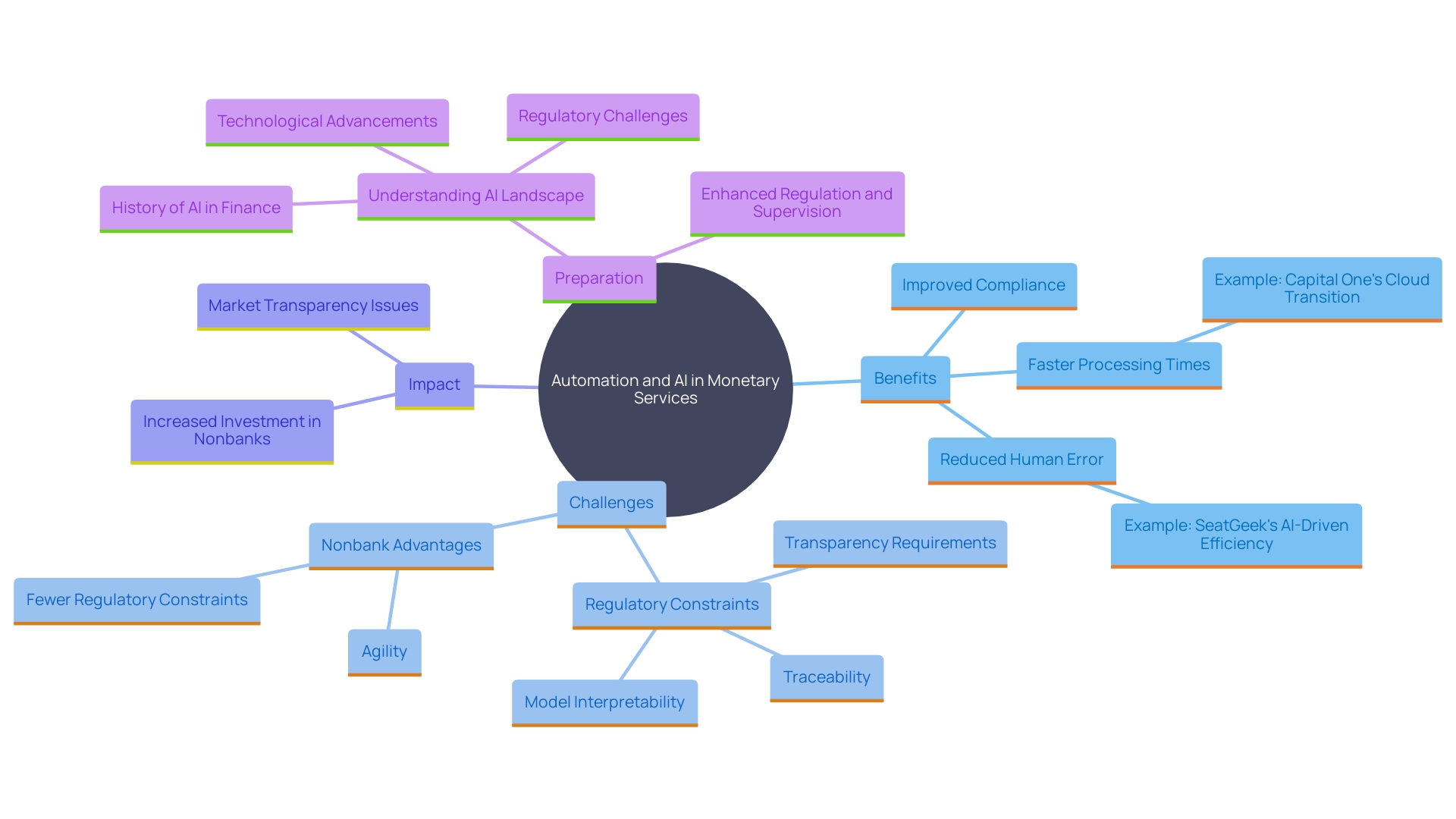
Key Areas for Automation
Recognizing important sectors for mechanization is essential for enhancing advantages. Commonly automated processes include transaction processing, fraud detection, compliance checks, and customer service operations. Implementing robotic process automation (RPA) in these areas can yield substantial improvements in speed and accuracy. For instance, M&T Bank, a long-established banking organization, has acknowledged the necessity for digital transformation to comply with strict regulatory obligations and safeguard confidential information. By establishing organization-wide Clean Code standards, they have minimized application maintenance time and reduced costs, ensuring their software remains efficient, reliable, and secure.
Furthermore, automating information management and reporting processes guarantees that institutions can swiftly adjust to evolving regulations and market situations. The incorporation of AI can enhance financial processes by automatically summarizing documents, extracting information, and categorizing content from email attachments. This not only accelerates processes and reduces costs but also improves accuracy and boosts efficiency. JPMorgan Chase, a leader in technological investments, expects that its investments in data analytics and AI will deliver significant business impact, driving cost savings and efficiencies across their infrastructure and data initiatives.
The implementation of AI and machine learning in monetary sectors is changing customer experience and retention, credit approval, and fraud detection. As AI continues to mature, its applications in these areas are expanding, promising further improvements in operational efficiency and customer satisfaction. By utilizing AI to examine extensive datasets and forecast customer actions, banks can enhance personalization of offerings and make more educated business choices.

Challenges and Considerations in Implementing AI Automation
While the advantages of AI automation in monetary sectors are compelling, several challenges must be addressed. Organizations may encounter resistance to change from employees who are accustomed to traditional workflows. ‘According to research by EXL, around 89 percent of insurance and banking firms in the UK have introduced AI solutions over the past year, yet information issues continue to hinder progress.’. Integrating new technologies with existing systems can pose technical challenges, especially given the heavy reliance on legacy tools in financial services. This dependency has created regulatory risks and a failure to keep pace with new developments.
Developing a clear strategy for change management is vital, ensuring that staff are supported through training and resources. As the CFA Institute noted, AI has already improved laborious tasks such as data processing, allowing staff to use their time more productively. Indeed, 45% of firms reported that AI enables employees to focus on more value-added activities. Compliance with regulatory requirements must also be considered throughout the implementation process to avoid potential legal pitfalls. A comprehensive approach to risk management, as outlined by banking agencies, can help organizations implement AI in a safe, sound, and fair manner.
Accenture’s study indicates that 73% of the time utilized by US bank personnel could be influenced by generative AI—39% by mechanization and 34% by enhancement. Occupations representing 41% of banking employees, such as tellers, could benefit significantly, with up to 60% of their routine tasks supported by AI. However, the impact will not be uniform, and roles requiring a high measure of judgment or personalized customer interactions, like credit analysts and relationship managers, will primarily see augmentation. As monetary institutions persist in maneuvering through these changes, AI will probably be the motivating factor behind a more flexible, competitive, and customer-oriented environment.
Best Practices for Successful Finance Automation
Achieving successful mechanization in financial services requires a strategic approach. Organizations should start with a comprehensive process evaluation to identify opportunities for mechanization, ensuring that the most significant areas are focused on. Setting clear objectives and performance indicators is crucial for assessing the success of automated projects and ensuring they align with business goals. Working together with cross-functional teams is essential, as it provides varied perspectives and encourages support across departments, which is important considering the notable opposition to change observed in 25% of automated projects.
Continuous monitoring and optimization of automated processes ensure they remain effective and aligned with evolving business goals. This is supported by insights from the latest State of the Automation Professional survey, which highlights the importance of integration and usage in 2024, following a year of discovery and preparation in 2023. Furthermore, successful mechanization projects in larger companies frequently have leaders who comprehend the total cost of ownership for these initiatives, as demonstrated by 46% of respondents in successful implementations.
Automation in financial services is also driven by its potential to enhance customer experience, improve accuracy, and boost productivity. AI and robotic tools can transform customer interactions, credit approval processes, and fraud detection, providing a competitive advantage in the industry. As mentioned by specialists, robotic technology, including Robotic Process Automation (RPA), can save time, lower expenses, and enhance overall operational effectiveness by mechanizing tasks such as information entry and transaction processing.
The incorporation of AI in monetary systems also tackles security issues, with automated solutions safeguarding essential processes and protecting sensitive economic information. This is particularly relevant given the high expectations of today’s consumers for secure and hassle-free online transactions. By decreasing manual data input and lowering the chances of human mistakes, mechanization not only enhances production quality but also improves the overall customer experience and economic stability.
In summary, the successful execution of automated processes in financial services depends on strategic planning, cross-functional collaboration, continuous optimization, and a focus on enhancing customer experience and security. By adhering to these best practices, organizations can leverage automation to drive productivity, reduce costs, and stay competitive in an increasingly digital landscape.
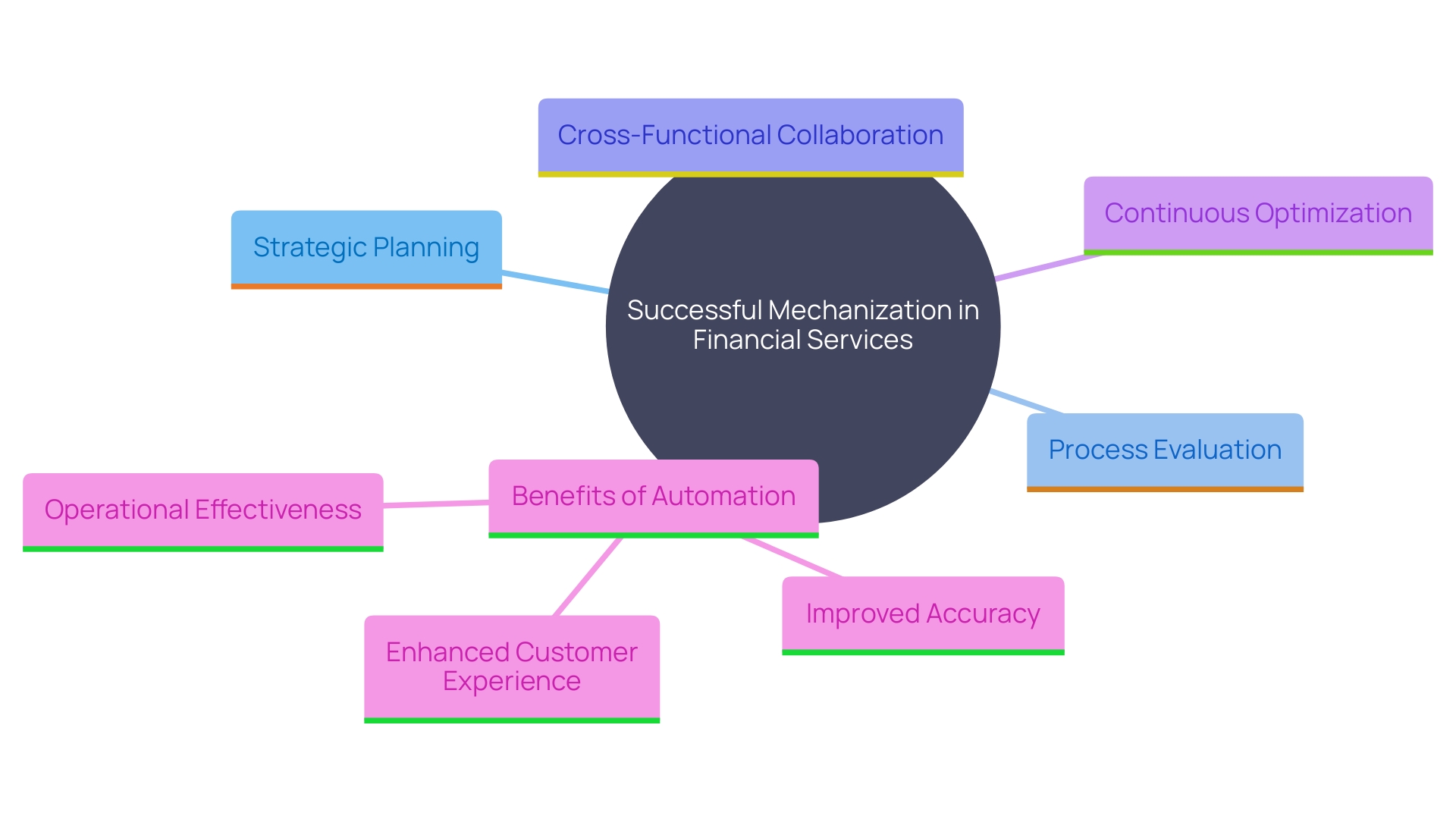
Conclusion
The integration of automation in financial services has proven to be a transformative force, enhancing operational efficiency and effectiveness across the industry. By streamlining repetitive tasks, financial institutions can achieve faster processing times, reduce human error, and ensure compliance with regulatory standards. Notable examples, such as Capital One’s transition to a cloud-based infrastructure and M&T Bank’s adoption of robotic process automation, illustrate how leading firms are leveraging technology to foster innovation and improve resource allocation.
Identifying key areas for automation, including transaction processing, fraud detection, and customer service, is crucial for maximizing the benefits of these technologies. The implementation of AI and machine learning not only optimizes workflows but also personalizes customer interactions, enhancing satisfaction and loyalty. However, organizations must navigate challenges, such as employee resistance and the integration of new technologies with legacy systems, to fully realize the potential of automation.
Best practices for successful automation in financial services emphasize the importance of strategic planning, cross-functional collaboration, and continuous monitoring. By focusing on measurable objectives and ensuring alignment with business goals, organizations can drive productivity and reduce costs while enhancing customer experiences. As the financial sector continues to evolve, embracing automation will be essential for maintaining a competitive edge and meeting the growing expectations of consumers in a digital landscape.
Introduction
In today’s fast-paced business environment, staying competitive requires more than just keeping up with industry trends; it demands a proactive approach to enhancing operational efficiencies. One powerful tool for achieving this is the implementation of taskbots in workflow automation. Taskbots offer transformative benefits, enabling organizations to automate repetitive tasks, thereby boosting productivity and reducing the time spent on manual processes.
This article delves into the advantages of taskbots, identifies key areas for automation, and provides practical steps for setting up and implementing these tools. Real-world examples and best practices will be explored, illustrating how taskbots can drive innovation, improve accuracy, and ultimately, propel businesses towards a future-ready state.
Benefits of Taskbots in Workflow Automation
Taskbots bring transformative benefits to workflow automation, significantly enhancing efficiency and reducing the time spent on manual processes. By automating repetitive activities, organizations can achieve faster project turnaround times and enhanced overall productivity. The integration of taskbots ensures that tasks are completed accurately and consistently, minimizing the risk of human error. Moreover, automation allows employees to focus on higher-value activities that drive innovation and growth within the organization.
For example, the research team led by Chang-hyun Kim at the Korea Institute of Machinery and Materials (KIMM) developed AI technology for robots that can be applied to manufacturing processes, improving efficiency and accuracy. This technology, based on the Large Language Model (LLM) and virtual environments, allows sequences and movements to be automatically generated via voice or text, optimizing the workflow and reducing errors.
Strategic Focus: Automating mundane tasks liberates the workforce to concentrate on strategic, value-adding activities. This shift not only boosts morale but also propels businesses toward innovation and growth. The path towards workflow optimization is not merely a trend; it is a strategic shift towards smarter, more efficient business practices. As organizations continue to navigate the complexities of the modern business landscape, the adoption of automated processes is becoming less of an option and more of a necessity. In this changing work setting, the question is no longer if companies should embrace workflow optimization, but how swiftly they can incorporate it to stay competitive and prepared for the future.
However, the journey to successful mechanization isn’t without its challenges. For instance, a team at Ryanair discovered that while they had many small-scale processes in operation, the lack of a comprehensive orchestration framework made it challenging to enhance and expand their efforts. “Our main challenge was that we had a lot of small-scale processes running everywhere, but we didn’t have anything wrapping it all together,” says Diego Infiesta, Infrastructure Manager at Ryanair.
Despite these challenges, the advantages are clear. By intelligently implementing these tools and technologies, companies can transform their operations, enabling a future where human creativity and strategic planning lead the way. ‘Embrace the digital transformation and unlock the full potential of workflow streamlining to drive your organization’s success.’.
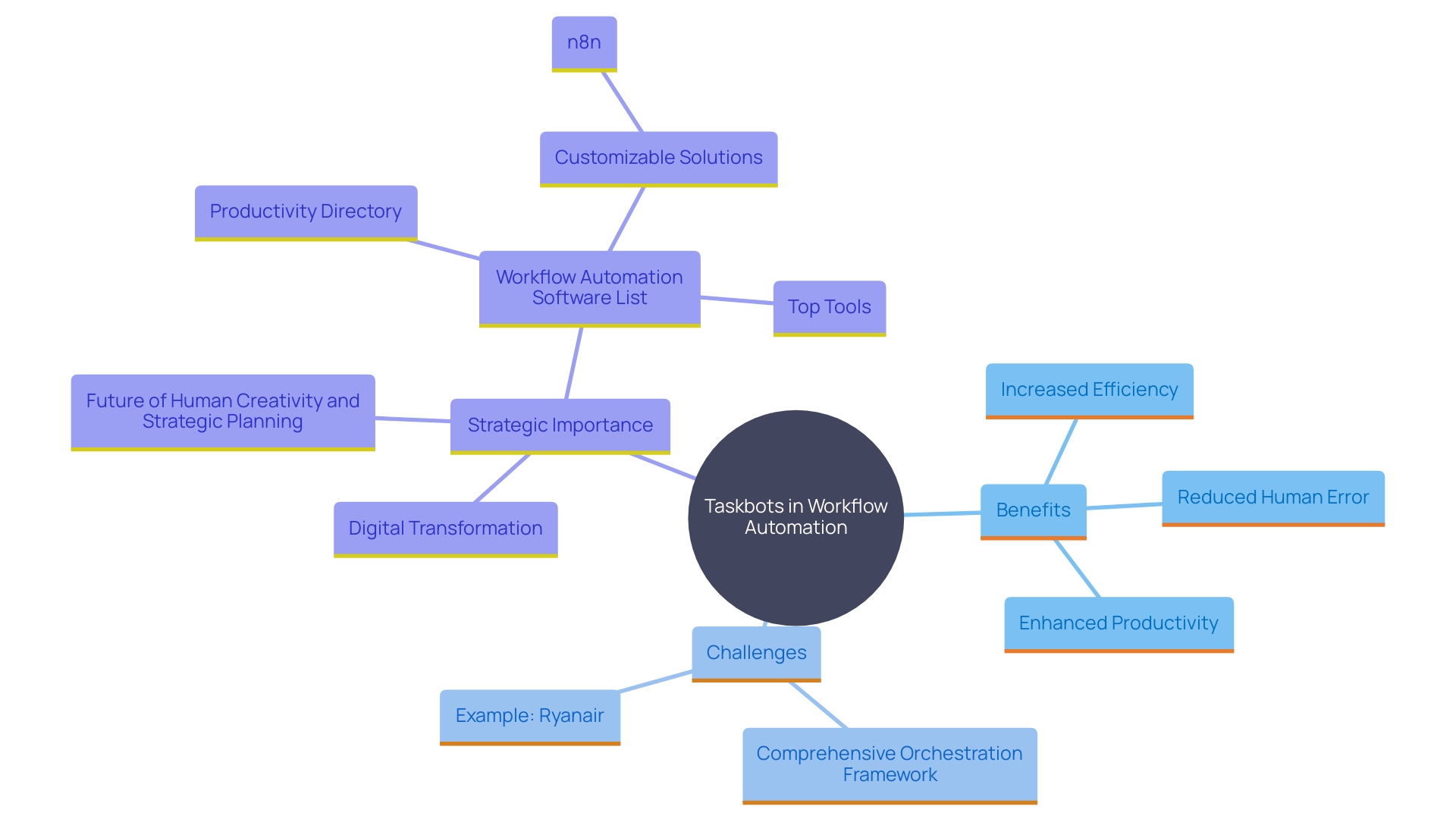
Identifying Areas for Automation
To successfully implement task bots, it is crucial to identify the right areas for automation. Start by mapping current workflows to pinpoint bottlenecks and repetitive tasks that consume valuable resources. Key processes to consider include data entry, report generation, and customer support inquiries, as these are often time-consuming and prone to errors. Collaborating with teams to collect insights on their challenges can uncover further possibilities for streamlining processes.
Prioritizing areas that will yield the highest return on investment and align with organizational goals is essential. Data management back-office activities, such as data entry and validation, database management, data analysis, and reporting, are particularly well-suited for automation. These activities guarantee the precision, safety, and availability of information, which are essential in today’s data-driven business environment.
Furthermore, back-end customer support operations play a critical role in maintaining customer satisfaction and loyalty. Automating tasks like managing tickets, resolving issues, and handling complaints can significantly enhance the efficiency and effectiveness of customer support teams.
By implementing advanced AI tools for data analysis and predictive modeling, organizations can gain valuable insights and make data-driven decisions with greater accuracy. This approach not only provides a snapshot of current operations but also equips organizations with the foresight needed to navigate strategic decisions.
Investing in the right tools, such as RPA and AI solutions that align with specific needs and infrastructure, is crucial. Additionally, upskilling the workforce to complement new automation systems and focusing on continuous improvement will maximize the benefits of automation. Embracing hyperautomation as a strategic imperative empowers the workforce, optimizes processes, and unlocks the true potential of AI, ensuring that organizations stay ahead in the competitive landscape.
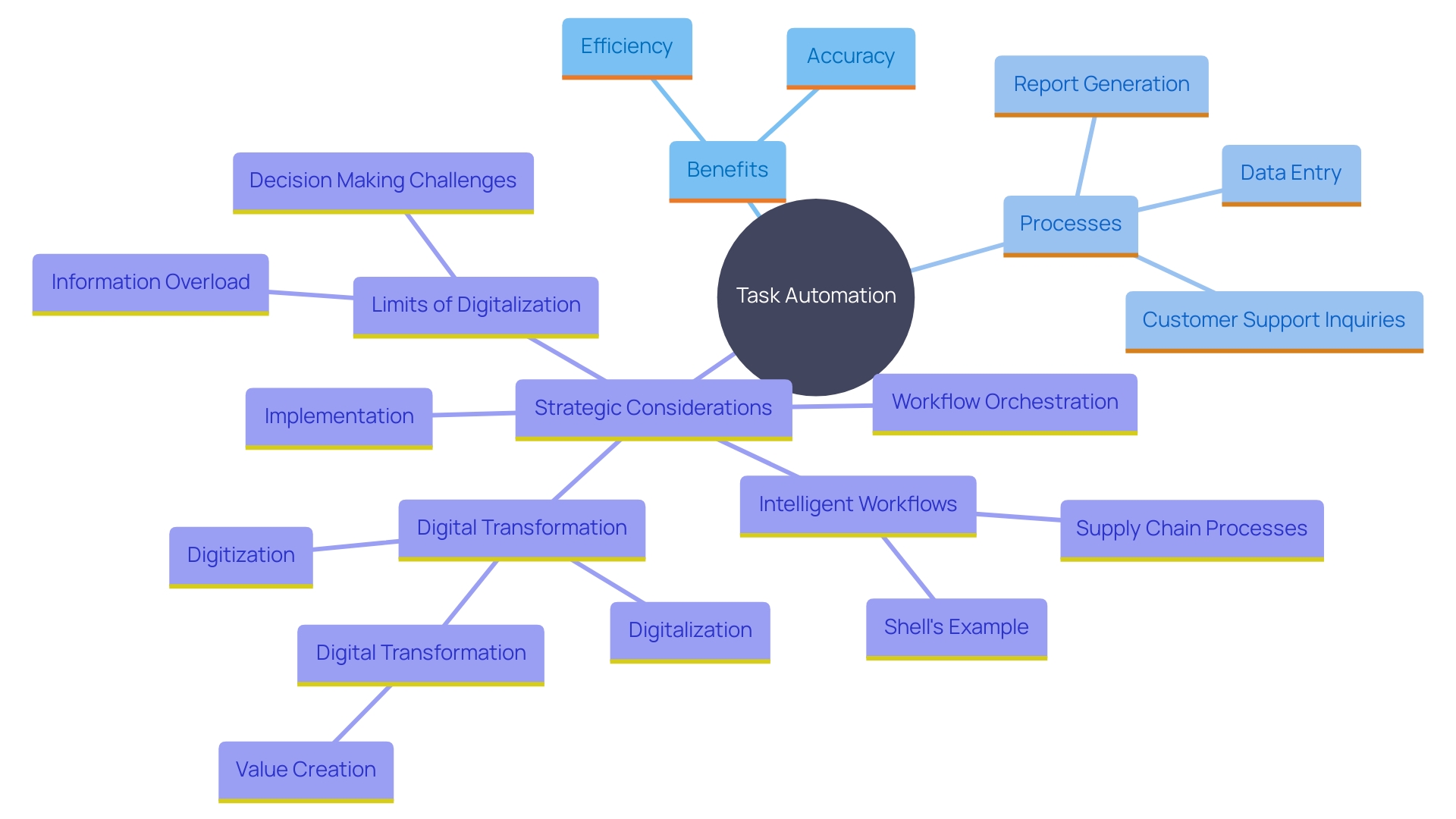
Setting Up Taskbots for Workflow Automation
Implementing automated tasks requires a methodical approach to ensure success. Start by selecting tools and platforms that align with existing systems, such as Salesforce (SFDC) for customer relationship management. Defining clear objectives and metrics for success is crucial. Outline specific outcomes expected from the taskbots to ensure they meet business needs.
Involve stakeholders early on to collect feedback and encourage support, as opposition to change is a major difficulty. The success rate of mechanization projects can be hindered by a lack of overall vision or strategy, with 25% of failures attributed to this issue. Additionally, 37% fail due to implementation costs, and 90% face technical issues.
Involving technical and procedural knowledge from different parts of the organization is essential. Based on a recent study, the most effective technology deployments reorganize workflows as new innovations are introduced. Merging technical understanding from IT divisions with process proficiency from front-line groups guarantees that the most significant processes are recognized for mechanization.
Create a thorough training program to acquaint employees with the new mechanization tools. A recent survey found that 77% of workers trust AI to manage nearly half of their tasks, indicating a growing acceptance of mechanization in the workplace. Training programs should focus on building this trust and ensuring employees are comfortable working alongside AI.
By following these steps, companies can streamline workflows, make better use of their data, and save time and money, ultimately boosting productivity and minimizing losses.
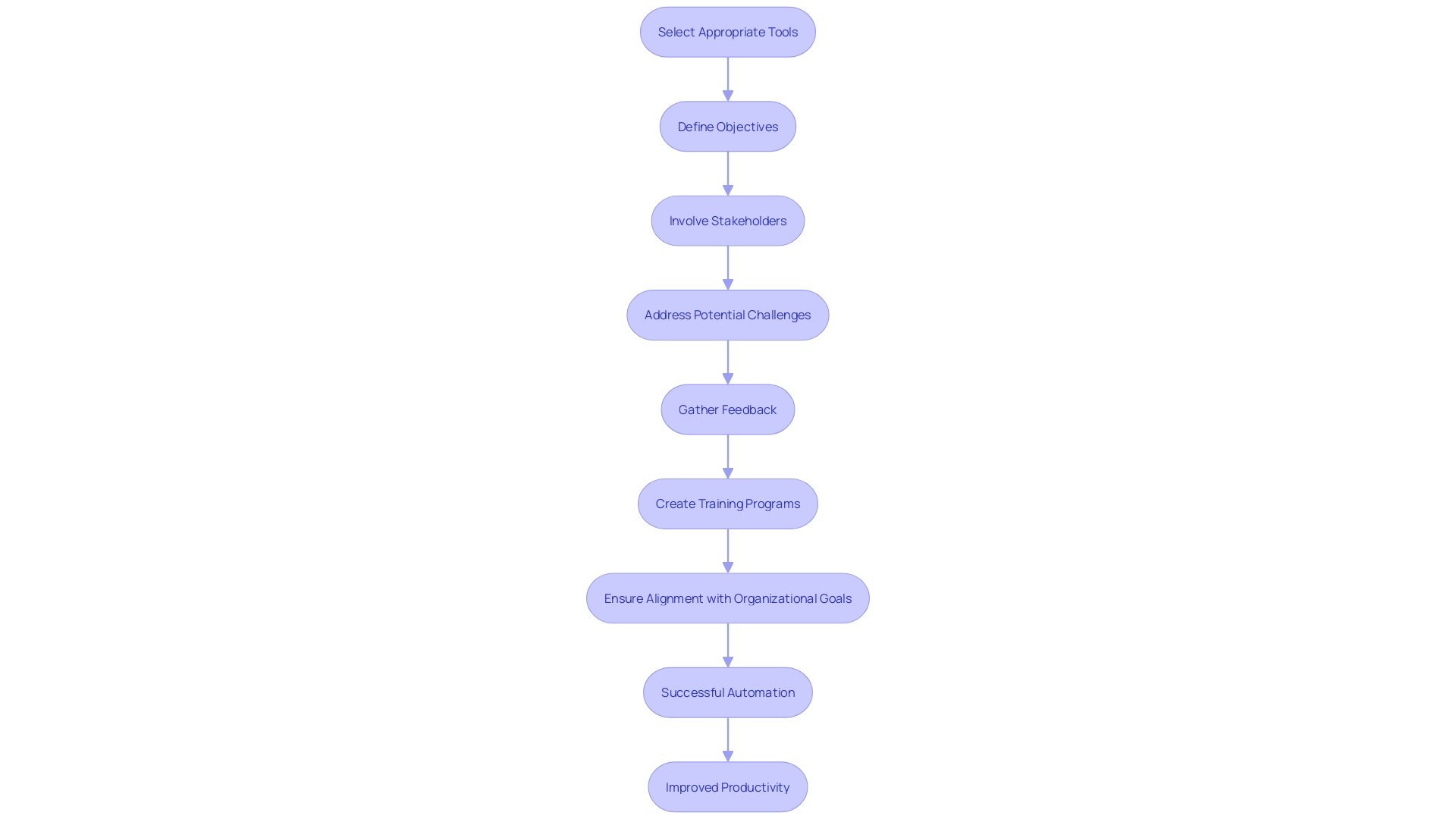
Best Practices for Implementing Taskbots
Effectively implementing taskbots involves a strategic approach that ensures organizational success and employee buy-in. One vital practice is securing strong leadership support for technological initiatives, which fosters a culture of innovation and promotes employee engagement. For example, Capital One’s effective digital change, supported by Slack, highlights the significance of leadership in promoting a culture of teamwork and efficiency across different divisions.
Consistent dialogue regarding the advantages of automated systems is crucial to reduce opposition to change. As per Salesforce research, 77% of employees have faith in AI to manage almost half of their responsibilities, emphasizing the increasing approval of automated processes when its benefits are clearly communicated. Embedding technical knowledge within front-line business teams can further enhance this acceptance. By merging technical skills with process understanding, companies can efficiently recognize high-impact processes for mechanization, ensuring a seamless integration of task bots into daily operations.
Continuous monitoring and adjustment of taskbot performance based on feedback and data are crucial. ‘This approach aligns with 1X Technologies’ development of a generative model for training robotics systems, emphasizing the importance of adapting tools based on real-world data to bridge the gap between simulations and actual deployment.’.
Establishing a clear governance framework to manage taskbot operations and ensure compliance with organizational policies is another best practice. Autonomous agents, when properly configured, can automate entire workflows and communicate directly with enterprise systems, significantly reducing labor costs. This comprehensive method of implementing technology can change how organizations function, making them more efficient and agile.
By adhering to these best practices, organizations can utilize automated tools to enhance productivity, drive innovation, and maintain a competitive edge in the ever-evolving business landscape.
Case Studies and Examples of Successful Taskbot Integration
Real-world examples of taskbot integration demonstrate the powerful impact of automation on various industries. For instance, a leading retail company implemented automated systems to handle inventory management, which led to a 30% reduction in stock discrepancies and enhanced order fulfillment accuracy. This aligns with Jordi’s observation about the significant value robotics projects bring to retail operations, highlighting how advanced mobile robots (AMRs) and mobile manipulator robots collaborate to streamline stock refilling processes.
In another case, a financial services firm incorporated automated systems for customer service inquiries, achieving a 40% decrease in response times and significantly boosting customer satisfaction. Similarly, Locus Robotics’ impressive trajectory showcases how their autonomous mobile robots (AMRs) have revolutionized warehouse efficiency. In 2023 alone, Locus picked 1.2 billion units, an 82% increase over the previous year, illustrating the scalability and effectiveness of robotics in meeting growing demand.
Among the key takeaways from these examples is the transformative potential of task bots in enhancing operational efficiencies. The integration of AI in various applications, from customer service chatbots to predictive analytics, underscores the widespread benefits of automation. By leveraging these technologies, businesses can streamline workflows, reduce costs, and remain competitive in an evolving landscape.
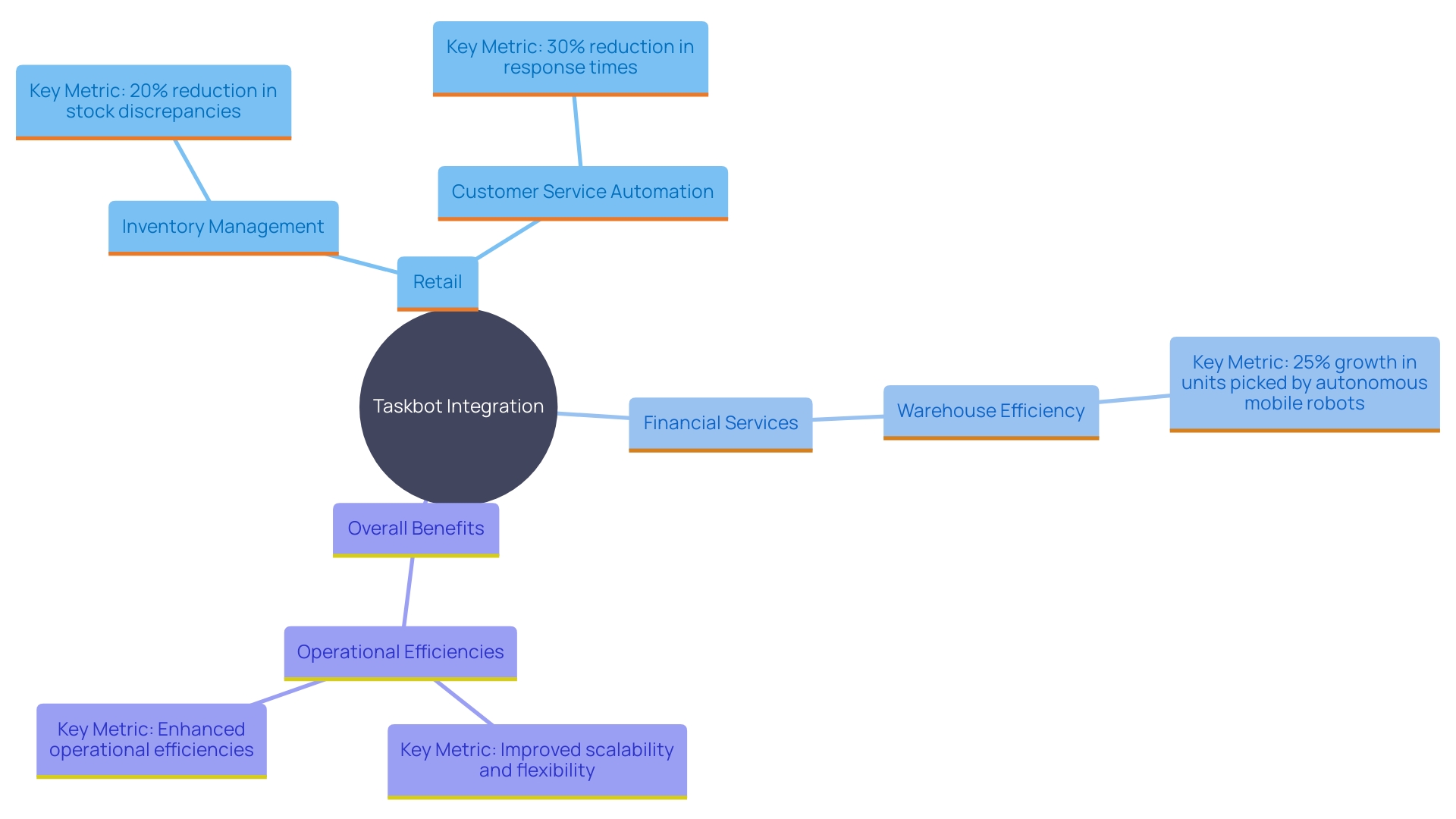
Conclusion
The implementation of taskbots in workflow automation presents a significant opportunity for organizations to enhance operational efficiencies and drive innovation. By automating repetitive tasks, businesses can not only increase productivity but also minimize human error, allowing employees to focus on higher-value activities that contribute to strategic growth. The transformative benefits of taskbots have been illustrated through real-world examples, demonstrating their efficacy in various sectors, from retail to financial services.
Identifying the right areas for automation is crucial to maximizing the return on investment. By mapping current workflows and engaging teams to uncover pain points, organizations can prioritize tasks that are both time-consuming and prone to errors. Emphasizing the importance of data management and customer support operations, the strategic deployment of taskbots can lead to significant improvements in efficiency and accuracy, ultimately enhancing customer satisfaction.
A methodical approach to setting up taskbots ensures successful implementation. Engaging stakeholders, defining clear objectives, and providing comprehensive training are essential steps that foster buy-in and encourage acceptance of automation technologies. Best practices, such as securing leadership support and establishing a governance framework, further enhance the effectiveness of taskbot integration.
Continuous monitoring and adjustment based on performance data will help organizations adapt to changing needs and maintain a competitive edge.
In summary, embracing taskbots as part of a digital transformation strategy equips organizations to navigate the complexities of the modern business landscape. By leveraging these powerful tools, companies can streamline operations, reduce costs, and position themselves for sustained success in an increasingly automated world. The path to enhanced operational efficiency is clear—adopting taskbots is not just an option; it is a strategic imperative for future readiness.
Introduction
In the ever-evolving landscape of business operations, leveraging automation to enhance efficiency and accuracy is paramount. ReadAction stands as a cornerstone in robotic process automation (RPA), focusing on the extraction and processing of vital information from various sources such as databases, documents, and web pages. By automating these data-intensive tasks, businesses can reduce manual intervention, minimize errors, and make informed decisions more quickly.
This article explores the transformative power of ReadAction, its key differences from other automation actions, common use cases, and best practices for implementation. Discover how integrating ReadAction into operations can revolutionize data handling, drive operational excellence, and free up valuable human resources for strategic initiatives.
What is ReadAction?
‘ReadAction signifies a crucial automation task within the field of robotic process automation (RPA) intended for extracting and managing information from various sources such as databases, documents, and web pages. This systematic extraction of pertinent information empowers businesses to leverage this knowledge for critical decision-making, reporting, and enhancing operational efficiency. By automating the information collection procedure, Reduction reduces the requirement for manual involvement, greatly decreasing time and mistakes.
A compelling example of automation’s impact is seen in Ryanair’s disaster recovery system, which is now standardized using RPA. This standardization ensures a seamless execution of steps without human error, highlighting the reliability and accuracy that RPA brings to complex tasks. Moreover, the incorporation of AI into RPA enhances its functionalities, enabling the management of unstructured information which frequently represents the most critical aspect of business operations. As one expert noted, the combination of organized and unorganized information in processes typically presents a challenge that can be effectively managed by AI-powered RPA.
Furthermore, the function of technology in enhancing precision cannot be exaggerated. Human errors, particularly in data entry and report generation, can lead to significant financial losses and customer dissatisfaction. RPA’s precision in these areas not only saves costs but also enhances the overall quality of work. This increased accuracy, coupled with the ability to automate tasks previously dependent on human intervention, makes RPA an invaluable tool for modern enterprises.
Organizations aiming to enhance their workflows and minimize operational delays should take into account the findings from research highlighting the significance of assessing and incorporating suitable technological solutions. The seamless integration of these technologies with existing IT infrastructure can lead to substantial efficiency gains and cost reductions. For example, Warehow’s recent investment to increase its technology and storage capacity highlights the strategic shift towards improved mechanization capabilities, fostering growth and operational efficiency.
In conclusion, ReadAction and similar RPA tasks signify a transformative shift in how organizations manage data-intensive processes. By leveraging automation, companies can not only achieve higher accuracy and efficiency but also free up human resources to focus on more strategic activities, ultimately driving innovation and competitive advantage in a fast-paced business landscape.
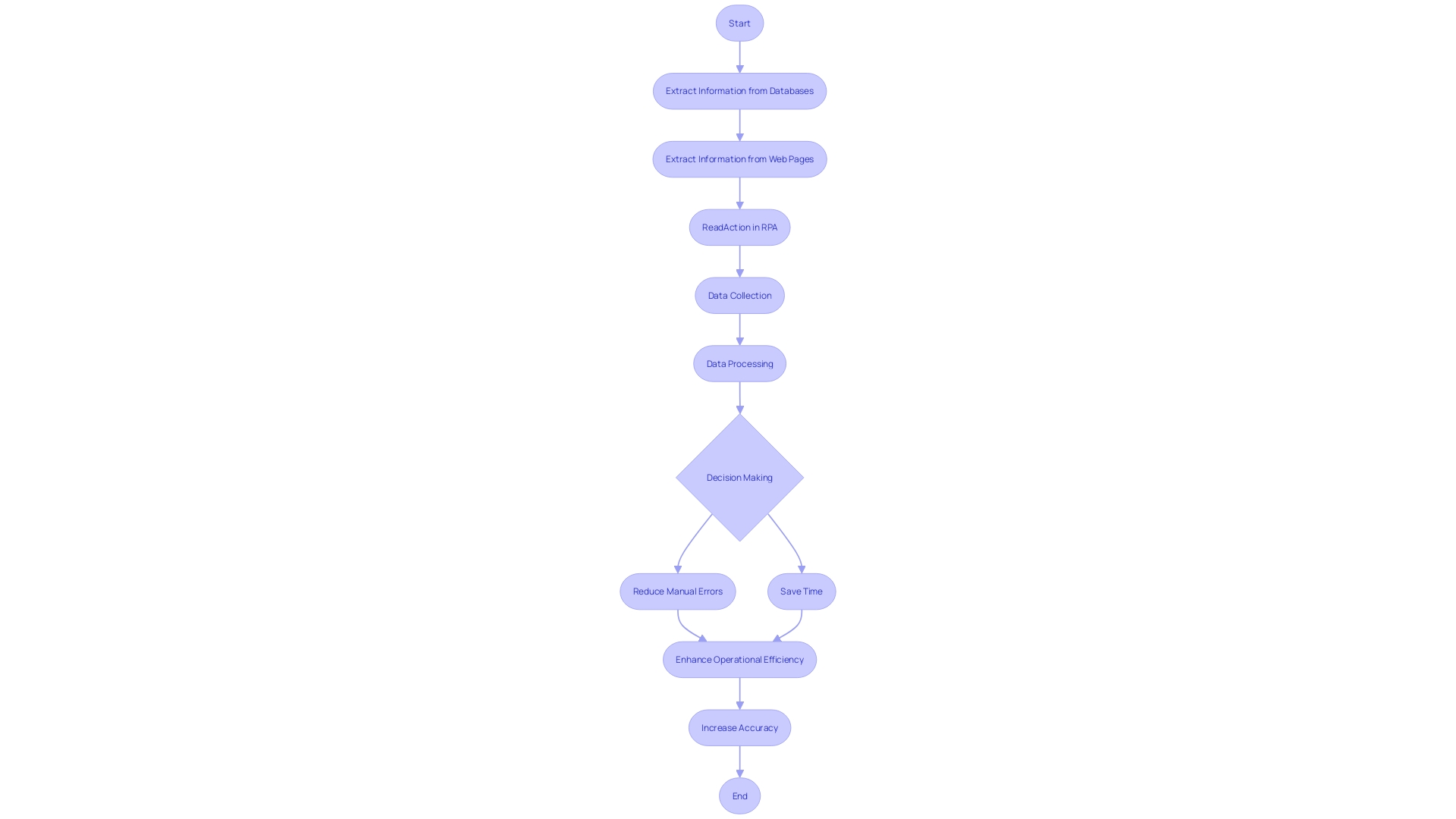
Key Differences Between ReadAction and Other Automation Actions
Automation actions are diverse and cater to various operational needs. For example, RedAction concentrates on information retrieval, efficiently pulling insights from various sources. ‘WriteAction, in contrast, manages the entry of this information into systems, guaranteeing that the details reach their destination without manual effort.’. ProcessAction is essential as it applies business rules to the obtained information, automating decision-making processes. Comprehending these unique actions is crucial for customizing the appropriate process strategy to particular operational needs.
A notable example is the finance department of Mass General Brigham hospital system, which faced significant inefficiencies in tracking healthcare providers. They introduced a mechanized tool that not only gathered data automatically but also arranged it to emphasize necessary actions, significantly enhancing their workflow. In the same way, Ryanair’s application of process mechanization for disaster recovery and auto-remediation demonstrates how standardized procedures can reduce human error and guarantee effective response times. These examples highlight the importance of choosing the right automation actions to enhance operational efficiency and productivity.

Common Use Cases for ReadAction
RedAction finds applications across various industries and departments. Typical applications involve obtaining information from invoices for accounts payable, collecting customer details from forms for CRM updates, and acquiring market statistics for analysis in finance. For instance, Gusto has integrated automated information extraction to simplify access to IRS compliance documentation for SMBs, extracting crucial details from tax returns, W-2 forms, and gross receipts. This automation significantly reduces manual labor, with a time-saving example showing that processing 84 documents manually can take up to 60 minutes. By implementing RedAction, organizations can streamline their workflows, enhance information accuracy, and free resources for more strategic tasks. The advantages reach further than short-term profits, enabling companies to utilize their information for fresh customer insights, enhanced customer support, and a competitive advantage in the marketplace. Furthermore, the economic multiplier effect indicates that the same information can be repurposed across various use cases at minimal extra expense, generating additional value.
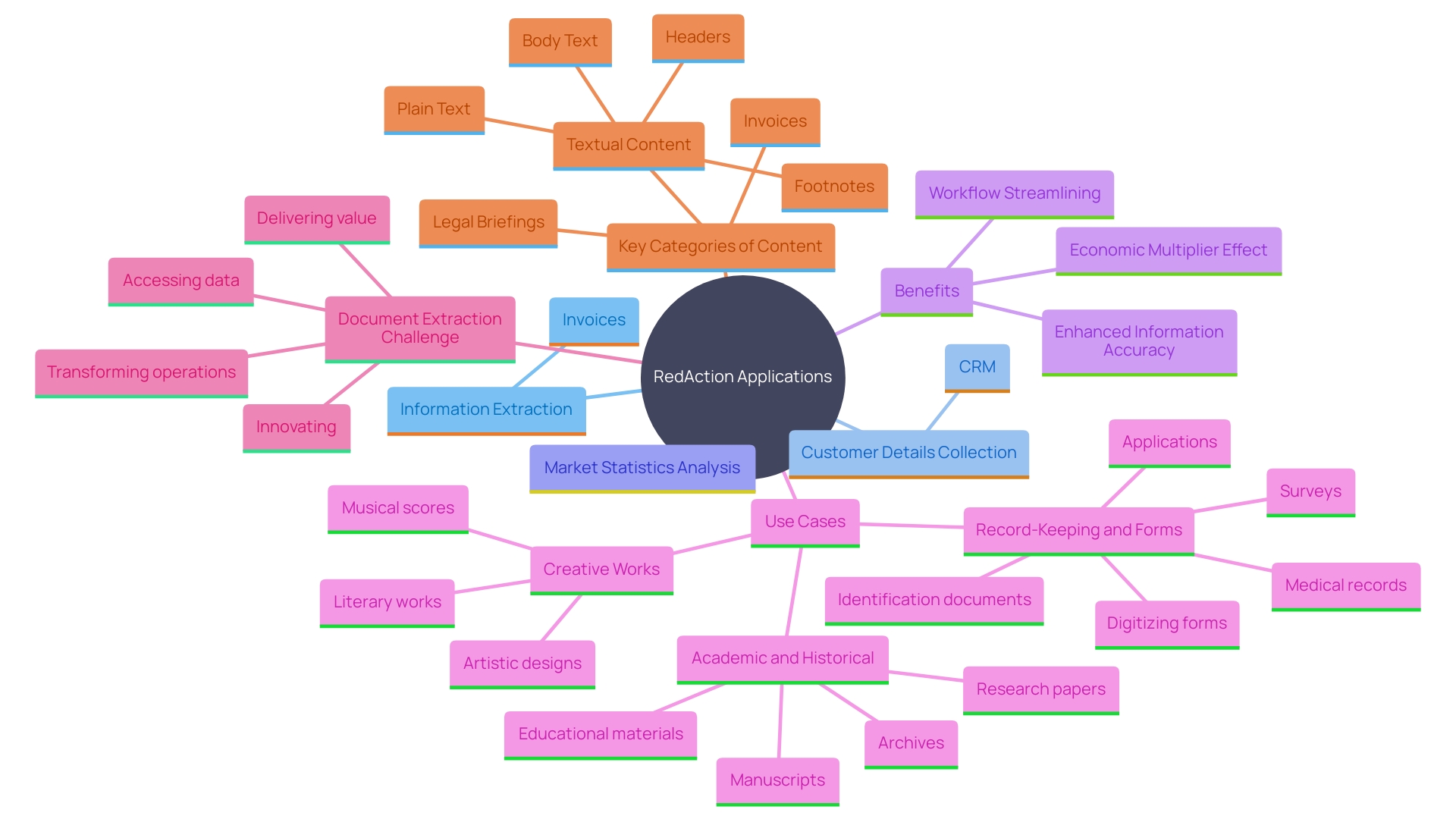
Best Practices for Implementing ReadAction
To maximize the effectiveness of RedAction, organizations should consider several best practices. First, clearly define the information sources and the types of details that need to be extracted. This ensures that the information gathered aligns with the specific needs and objectives of the organization. For example, identifying whether a camera is used for image collection or shape recognition is crucial, as it may not measure dimensional attributes accurately.
Second, ensure information quality by validating the details retrieved. This can be accomplished through sensor integration in machinery and workflows, enabling real-time information gathering of various parameters such as temperature, pressure, and speed. Advanced analytics can then be used to identify patterns, trends, and anomalies, ensuring high-quality data that is crucial for decision-making.
Third, incorporate error handling mechanisms to address potential issues during the extraction procedure. This includes establishing an accurate baseline with advanced robotic technologies to understand the condition of assets and ensure they meet acceptance criteria before going into service. Such proactive measures help transition from reactive to predictive maintenance approaches, saving time and resources.
Lastly, regularly review and optimize the ReadAction scripts to adapt to changing business requirements and enhance efficiency. This continuous improvement can be facilitated by utilizing digital twins for detailed simulations, evaluating system behavior under specific conditions, and enabling ongoing optimization without disrupting actual operations. By implementing these best practices, organizations can significantly improve their data extraction processes, leading to better efficiency and productivity.

Conclusion
The integration of ReadAction within robotic process automation (RPA) represents a significant advancement in how businesses manage and process data. By automating the extraction and handling of information from various sources, organizations can enhance operational efficiency, reduce manual errors, and make informed decisions more swiftly. The ability to handle both structured and unstructured data through AI-powered RPA solutions further underscores the transformative potential of this technology.
Understanding the distinct roles of ReadAction compared to other automation actions, such as WriteAction and ProcessAction, is crucial for developing a tailored automation strategy. Each action plays a vital role in streamlining workflows and improving productivity, as seen in successful implementations across various sectors. Notable examples, like those from Ryanair and Mass General Brigham, highlight the practical benefits of adopting the right automation tools to address specific operational challenges.
Implementing ReadAction effectively requires adherence to best practices, including defining data sources, ensuring data quality, incorporating error handling, and optimizing extraction processes. These strategies not only enhance the accuracy of data handling but also enable organizations to leverage their information for strategic advantage. As companies continue to embrace automation, the ability to harness data efficiently will be a key driver of innovation and competitive success in today’s dynamic business environment.
Introduction
In the ever-evolving landscape of business operations, automation stands out as a pivotal force driving efficiency and productivity. The power to streamline processes, minimize errors, and free up valuable human resources for strategic initiatives is transforming industries across the globe. This article delves into the essentials of automation, offering a comprehensive guide to implementing and optimizing Automate 360 within your organization.
From understanding the basics and preparing your environment to creating your first automation and troubleshooting common issues, each step is designed to help you harness the full potential of this powerful technology. Real-world examples and industry insights underscore the transformative impact of automation, setting the stage for a future where businesses operate with unparalleled efficiency and agility.
Understanding the Basics of Automation
Automation involves leveraging technology to execute tasks with minimal human input, thereby streamlining business processes, boosting efficiency, and minimizing errors. A prime example of this is St. James Winery, which adopted mechanization to cope with increased growth and the lack of available labor. As a result, the company has seen higher profit margins.
Robotic Process Automation (RPA) exemplifies the latest wave in technology for process enhancement. By employing software robots, RPA can manage different activities such as data entry, transaction processing, and customer service interactions, liberating human resources for more strategic endeavors. The power of RPA lies in its ability to connect and operate across multiple applications and platforms seamlessly.
Introducing automated processes necessitates a strategic approach. Begin by assessing your business needs to identify the most time-consuming and error-prone tasks. Think about beginning with a pilot project to assess effectiveness and collaborate with a specialist to prioritize initiatives for the highest return on investment. Training and support are critical—ensure your team is well-versed in the new technology and understands how to design and maintain the workflows. Continuous assistance from a design specialist in technology can greatly simplify the transition.
Adopting technology for mechanization can be transformative. It not only saves time and reduces costs but also minimizes errors and enhances job satisfaction. These benefits contribute to long-term business growth and competitiveness. As highlighted in industry conversations, the incorporation of AI and mechanization is transforming the workforce, changing job roles, and requiring new skills and frameworks to support this technological advancement. The future of work in manufacturing, for instance, is being redefined by smart technology, requiring a workforce trained to harness these advancements effectively.
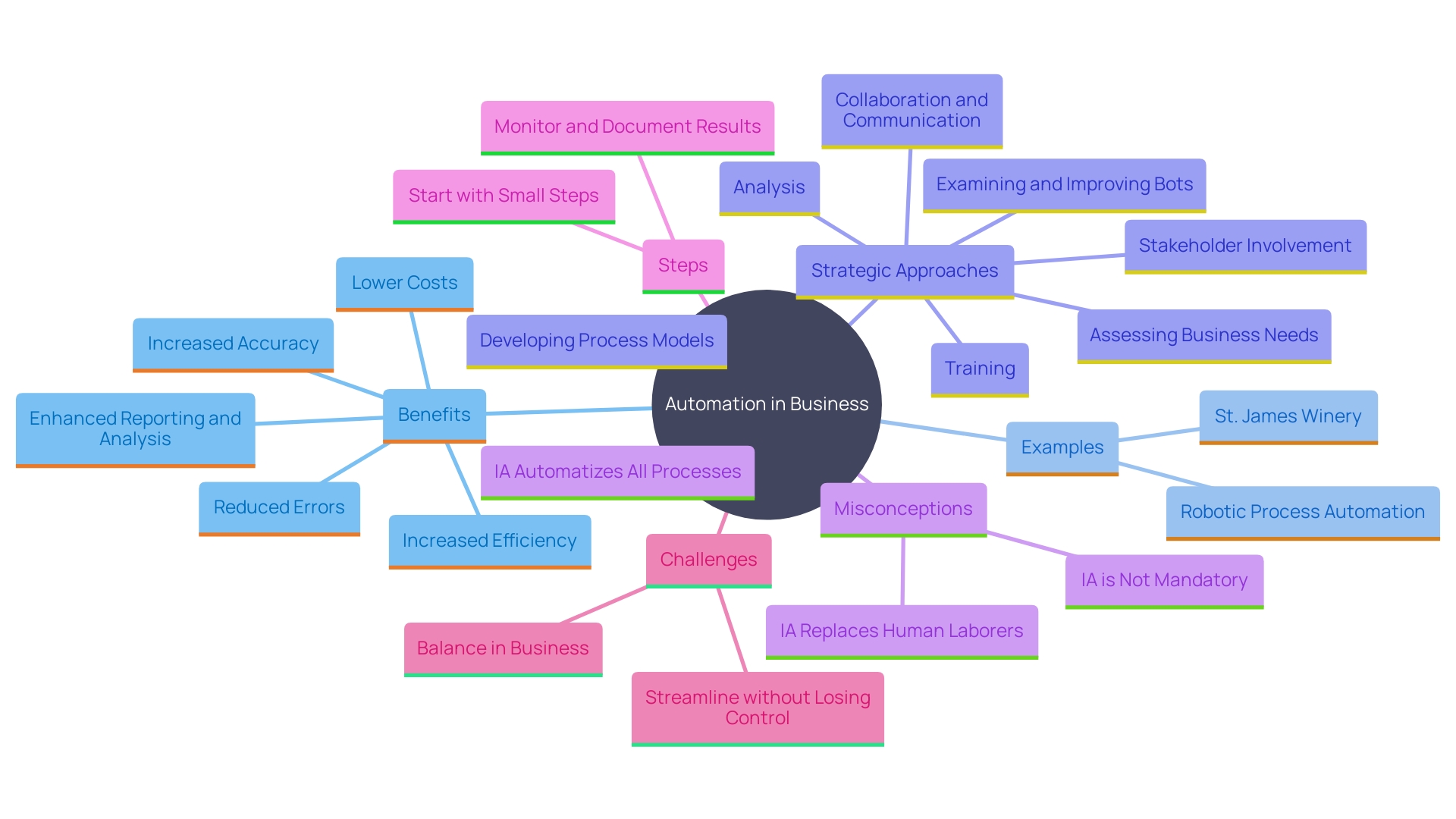
Step 1: Preparing Your Environment
Before diving into Automate 360, ensure your environment is thoroughly prepared. Start by assessing your current workflows to identify repetitive tasks that could benefit from automation. This involves comprehending the complex context in which these operations occur, frequently incorporating human interactions and integration with other systems. For instance, Shell has successfully reengineered its supply chain, manufacturing, and maintenance methods by using AI-enabled technologies such as robots and drones to monitor their facilities.
Next, ensure you have the necessary access to the software and relevant data sources. It’s essential to consider the organizational challenges, such as siloed teams and resistance to change. Leveraging tools like dashboards, inventory trackers, and alerting systems can improve efficiency, but human managers remain central to executing these processes.
An effective mechanization strategy must bridge organizational silos and integrate seamlessly across various domains. As stated in a report, 90% of mechanization projects fail due to technical issues, implementation costs, and lack of a clear vision or strategy. Therefore, understanding and navigating these challenges is crucial for successful automation implementation.
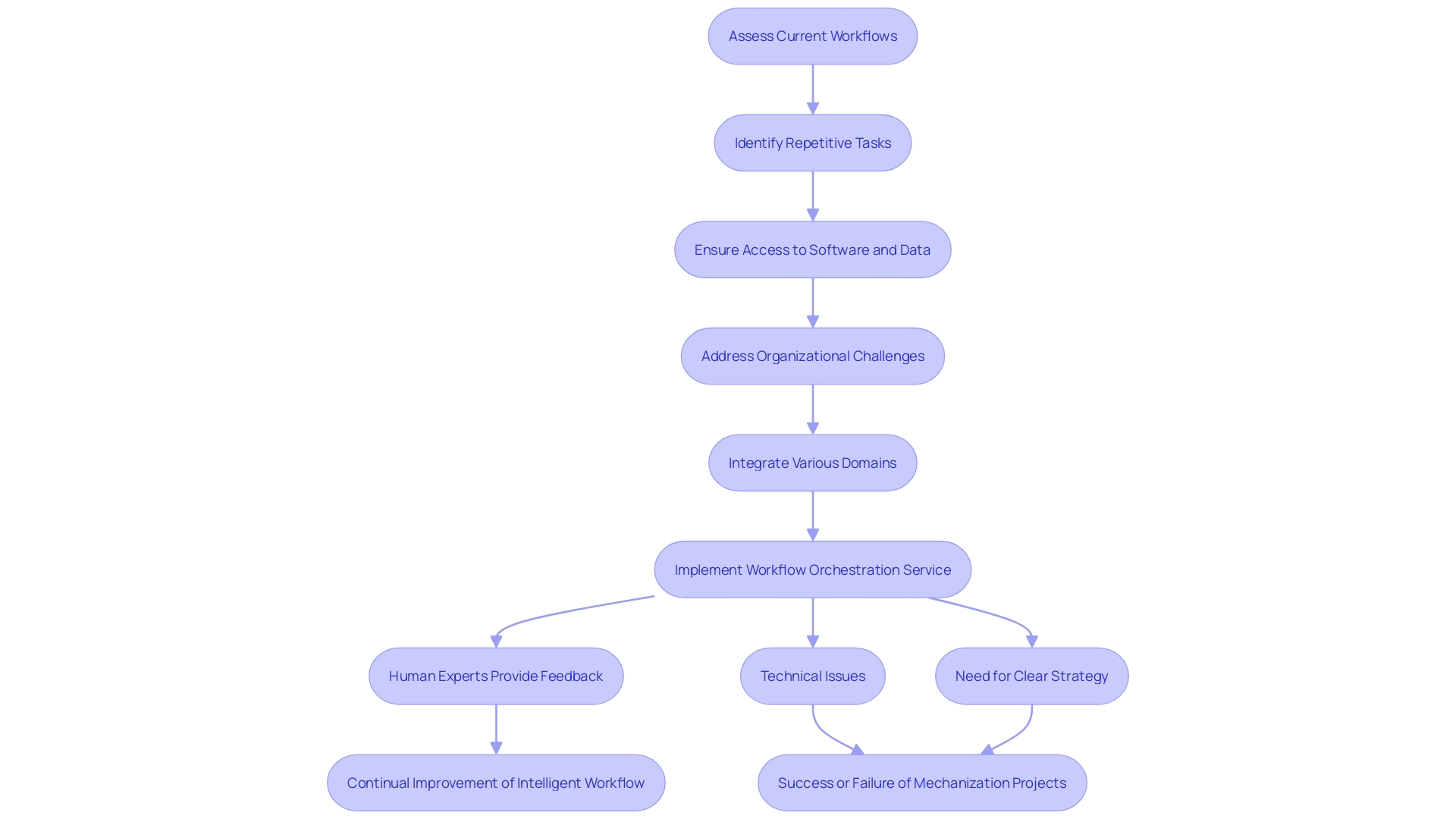
Step 2: Setting Up Your Automate 360 Account
To embark on your journey with Automate 360, begin by visiting their website and creating an account. ‘The setup procedure is straightforward: input your business details and select the features that best suit your operational requirements.’. Remember to verify your email address to activate your account and unlock the full potential of the platform. As seen in the case of Delivery Hero, streamlining processes can significantly reduce downtime and enhance productivity. ‘Their execution of mechanization instruments resulted in a decrease of 800 monthly account recovery inquiries, preserving considerable time and allowing employees to concentrate on their primary responsibilities.’.
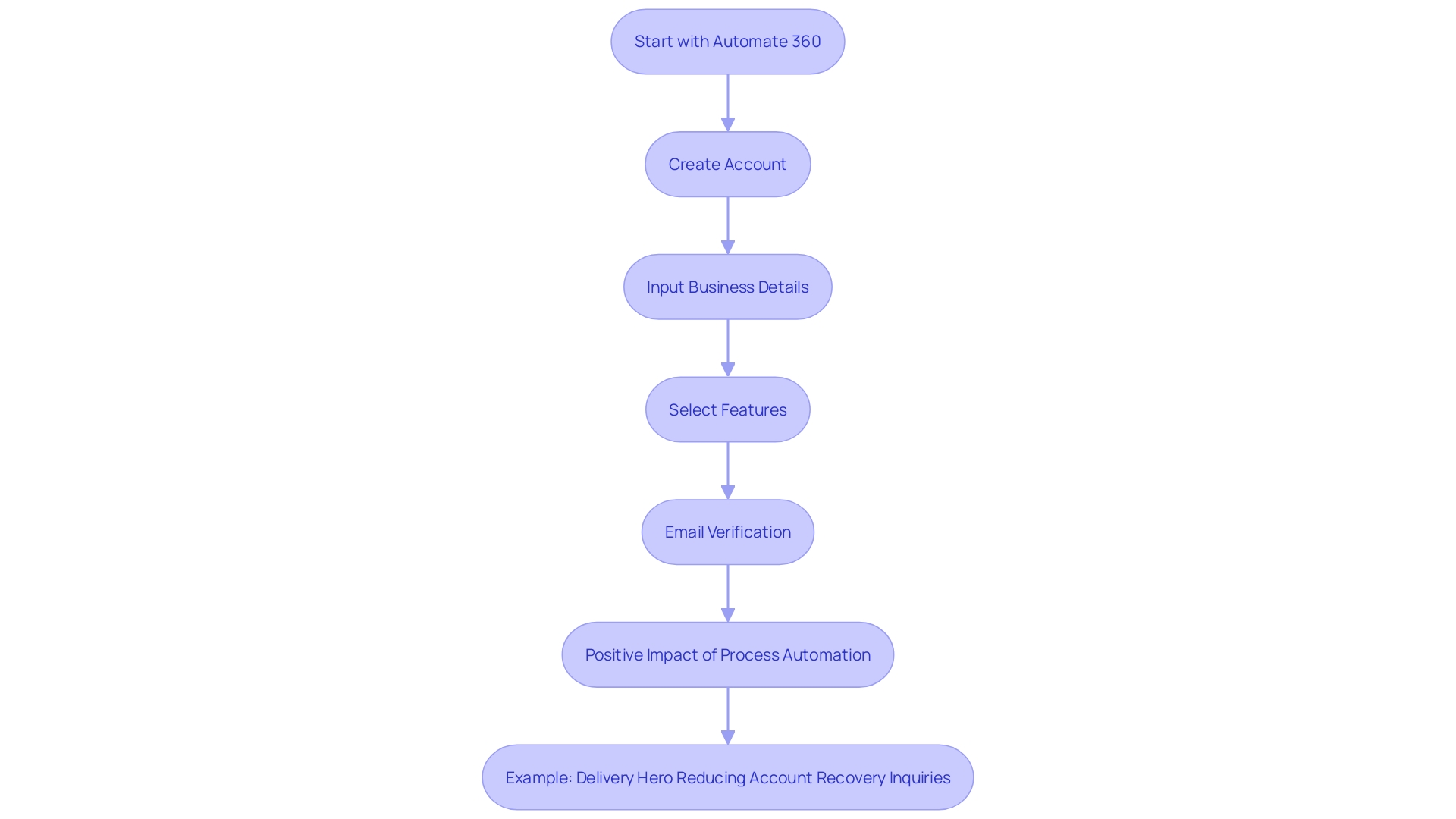
Step 3: Navigating the Automate 360 Interface
Once your account is set up, take the time to explore the Automate 360 interface thoroughly. The dashboard is your central hub, providing access to a range of powerful tools and features designed to streamline your operations. Familiarizing yourself with the layout and available options is essential for optimizing your workflow and taking full advantage of the system’s capabilities. For example, Bosch Rexroth’s sales team uses a virtual showroom to interact dynamically with customers, showcasing internal components swiftly and effectively. This level of engagement is facilitated by understanding and utilizing the interface efficiently. Likewise, incorporating automated tools can greatly improve your operational efficiency, just as MVTec emphasized the benefits of machine vision in mechanization during trade fairs. Embracing these technologies and understanding their interfaces can set the stage for improved productivity and innovation within your organization.
Step 4: Creating Your First Automation
Start your process improvement journey by identifying tasks that are most time-consuming and prone to mistakes. This strategic approach ensures you prioritize processes that will yield the most significant return on investment. Consider starting with a pilot project to test the effectiveness of mechanization within your organization. Utilizing the guided templates offered by Automate 360, you can construct your automated process by detailing the inputs, outputs, and steps necessary to finish the task. This initial project will serve as a practical introduction to the mechanization process. To ensure successful implementation, proper training and ongoing support are crucial. Collaborate with an Automation Expert to design and maintain workflows, and continuously monitor and document results to track progress and learn from each project. This method not only enhances efficiency but also aids in dispelling misunderstandings and emphasizes the transformative potential of intelligent technology in achieving digital transformation.
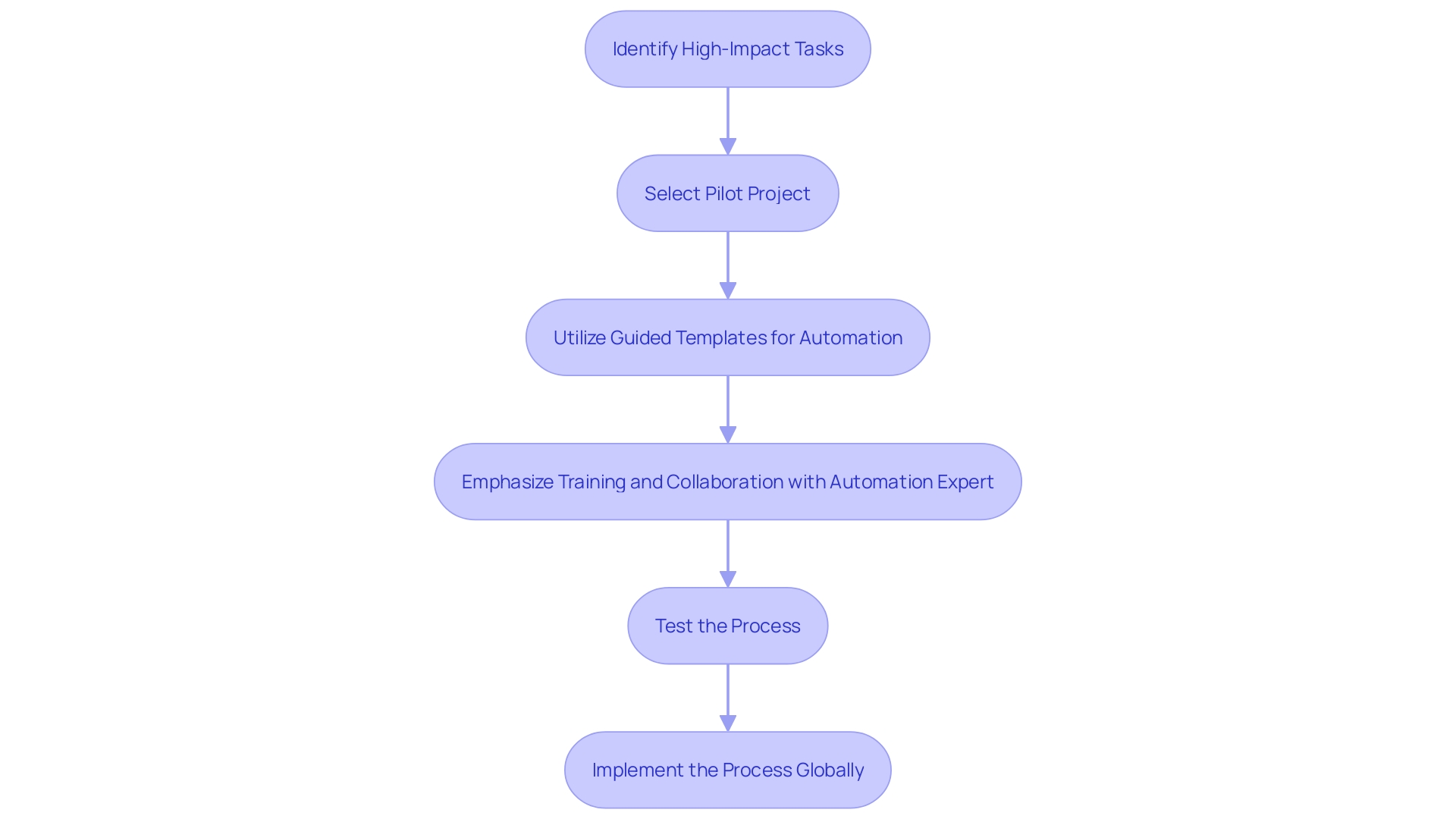
Step 5: Configuring Triggers and Actions
Triggers are events that start automated processes, while actions are the tasks performed as a result. Setting up these components properly is crucial for smooth operation. For instance, a trigger might be an alert generated when a specific digital metric is reached, prompting an action such as notifying a manager who then takes appropriate steps. In more advanced settings, intelligent workflows can automate these sequences, further optimizing efficiency.
In practice, consider the case of Delivery Hero, where mechanization was implemented to manage account recovery for employees. Before mechanization, the procedure required several stages and significant time, resulting in productivity declines. By establishing automated triggers and actions, the company significantly minimized downtime for employees, showcasing the impact of well-configured processes.
Furthermore, the increasing use of Robot Operating Systems (ROS) signifies a shift towards more advanced mechanization solutions. According to Allied Market Research, the ROS market is projected to reach $1.8 billion by 2032, driven by a CAGR of 12.9% from 2023 to 2032. This growth emphasizes the significance of incorporating advanced mechanization tools to remain competitive.
As mechanization progresses, it’s important to balance technology with human oversight. Even with advanced AI and automated systems, human expertise remains crucial for interpreting data and making strategic decisions. By leveraging both, businesses can achieve greater operational efficiency and productivity.
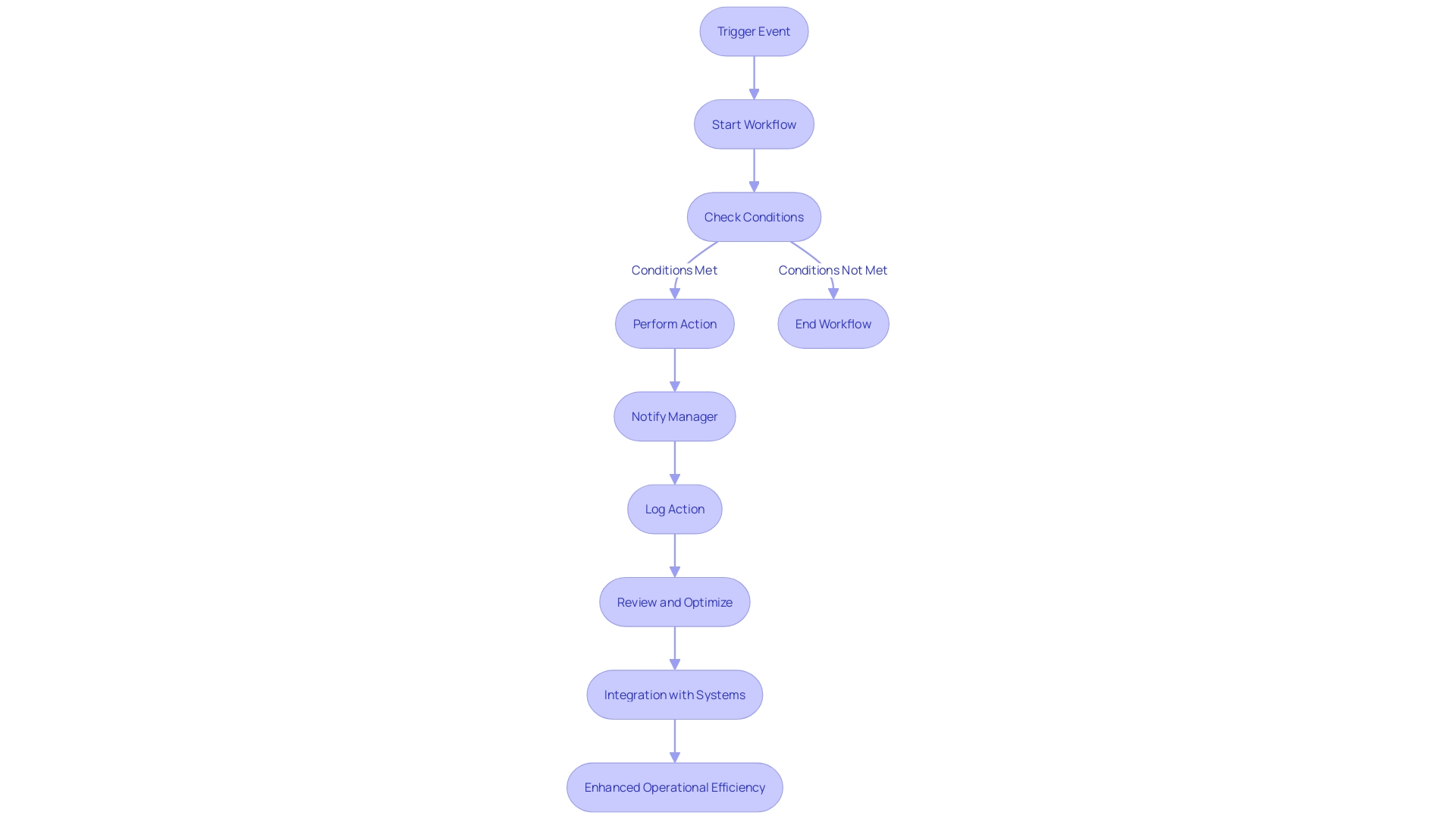
Step 6: Testing and Deploying Your Automation
To ensure seamless implementation of your tools, it is crucial to conduct thorough testing and simulations beforehand. Initiate with smaller, less complex tasks to identify and resolve any potential issues early. This approach not only boosts confidence in the system’s performance but also minimizes risks.
As you advance, continuously monitor the system to ensure it meets the set goals. Document the results meticulously to capture valuable insights and lessons that enhance future projects. According to industry experts, system simulation before final design can effectively pinpoint issues, reducing the risk of costly mistakes and project delays.
Investing in the right RPA and AI tools that align with your specific needs is essential. Additionally, providing your workforce with the essential skills and knowledge to enhance the new mechanization systems promotes smoother transitions. Treat mechanization as an ongoing journey, continually refining and optimizing processes to fully leverage the benefits. ‘The synergy of RPA and AI can significantly transform your operations, enhancing productivity and informed decision-making.’.
Statistics from Allied Market Research emphasize the increasing significance of mechanization, with the Robot Operating Systems market anticipated to attain $1.8 billion by 2032, indicating a CAGR of 12.9%. Embrace this transformative wave to stay ahead in the competitive landscape.
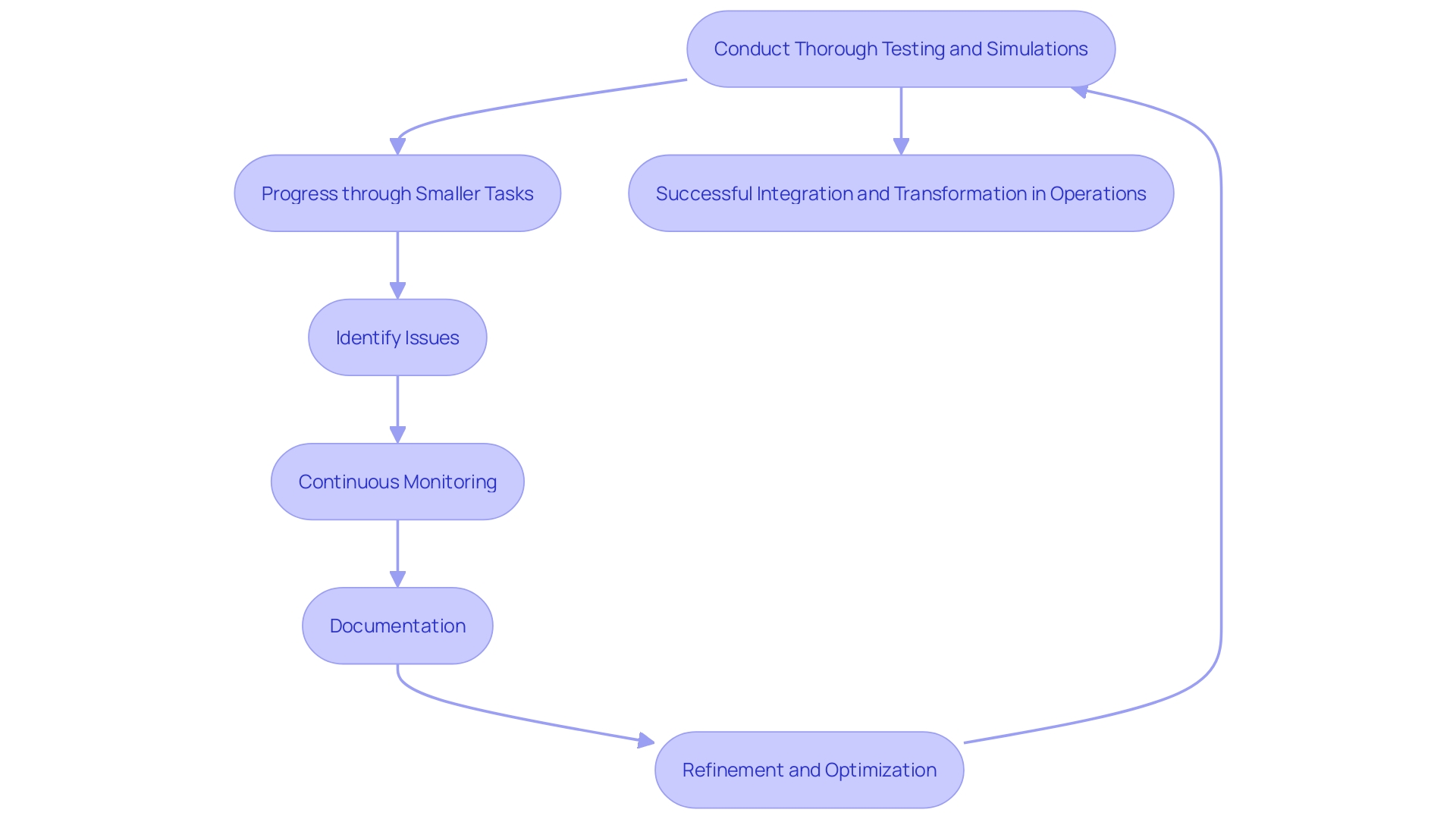
Troubleshooting Common Issues
Even with meticulous planning, challenges are inevitable. Familiarize yourself with essential troubleshooting strategies such as reviewing error logs, checking configuration settings, and consulting the comprehensive help resources provided by Automate 360. Integrating observability at every stage of development can play a critical role. This approach allows for understanding how automated systems sense, think, and act at scale, which is crucial for both identifying and addressing issues.
Integrating Industry 4.0 concepts into your troubleshooting activities can also improve productivity. While cybersecurity concerns may limit the use of external devices on factory floors, leveraging advanced maintenance strategies can mitigate such restrictions. For instance, running compatible versions of software and hardware components and ensuring backward compatibility with post-processing code can prevent many operational issues.
As mechanization technologies develop, remaining informed about the newest advancements and emerging applications is essential. Industry events and conferences like Automate offer valuable insights and training sessions that can help you stay ahead of the curve. Additionally, keeping abreast of the latest industry news and trends can provide practical solutions to contemporary challenges. By proactively addressing potential issues and continuously improving your methods, you can significantly enhance the efficiency and reliability of your automated operations.
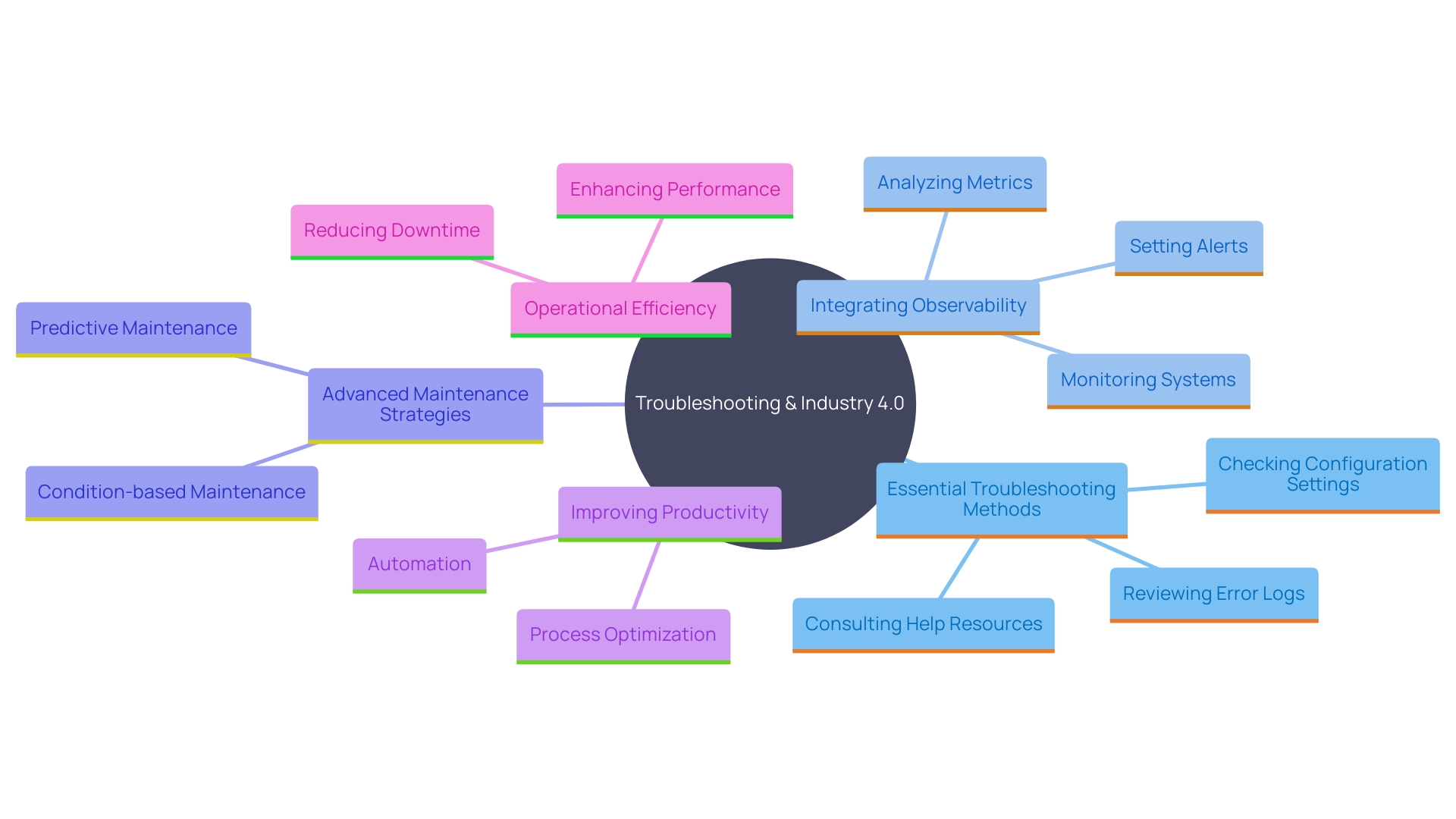
Advanced Features and Integrations
Delve into the advanced features of Automate 360, such as its seamless integration capabilities with other software tools and platforms. ‘This integration potential is crucial for businesses aiming to enhance their efficiency efforts and achieve a holistic approach to process optimization.’. In today’s rapidly changing environment of AI and digital technology, keeping informed about the latest advancements is crucial.
Case studies, such as that of St. James Winery, emphasize how mechanization has resulted in higher margins by tackling labor shortages and enhancing operational efficiency. This real-world example highlights the significant effect that thorough mechanization solutions can have on productivity and growth.
Furthermore, industry trends indicate that small and medium-sized enterprises are increasingly embracing Manufacturing Platforms (MAP) and DIY technologies, as these choices provide accessibility and reduced barriers to entry. As highlighted in recent automation news, industrial and chemical companies are collaborating with process automation vendors to drive changes in automation architectures, emphasizing the importance of integrating advanced features like those offered by Automate 360.
Automation technology, including Robotic Process Automation (RPA), allows companies to save time and lower expenses by automating repetitive activities across different applications and platforms. This not only improves accuracy but also boosts employee job satisfaction by freeing them from mundane tasks.
Ultimately, the advanced features of Automate 360 provide businesses with the tools needed to stay competitive in an increasingly automated world, driving efficiency and productivity to new heights. Utilizing these integrations can revolutionize operational workflows, making them more dynamic and responsive to changing market demands.
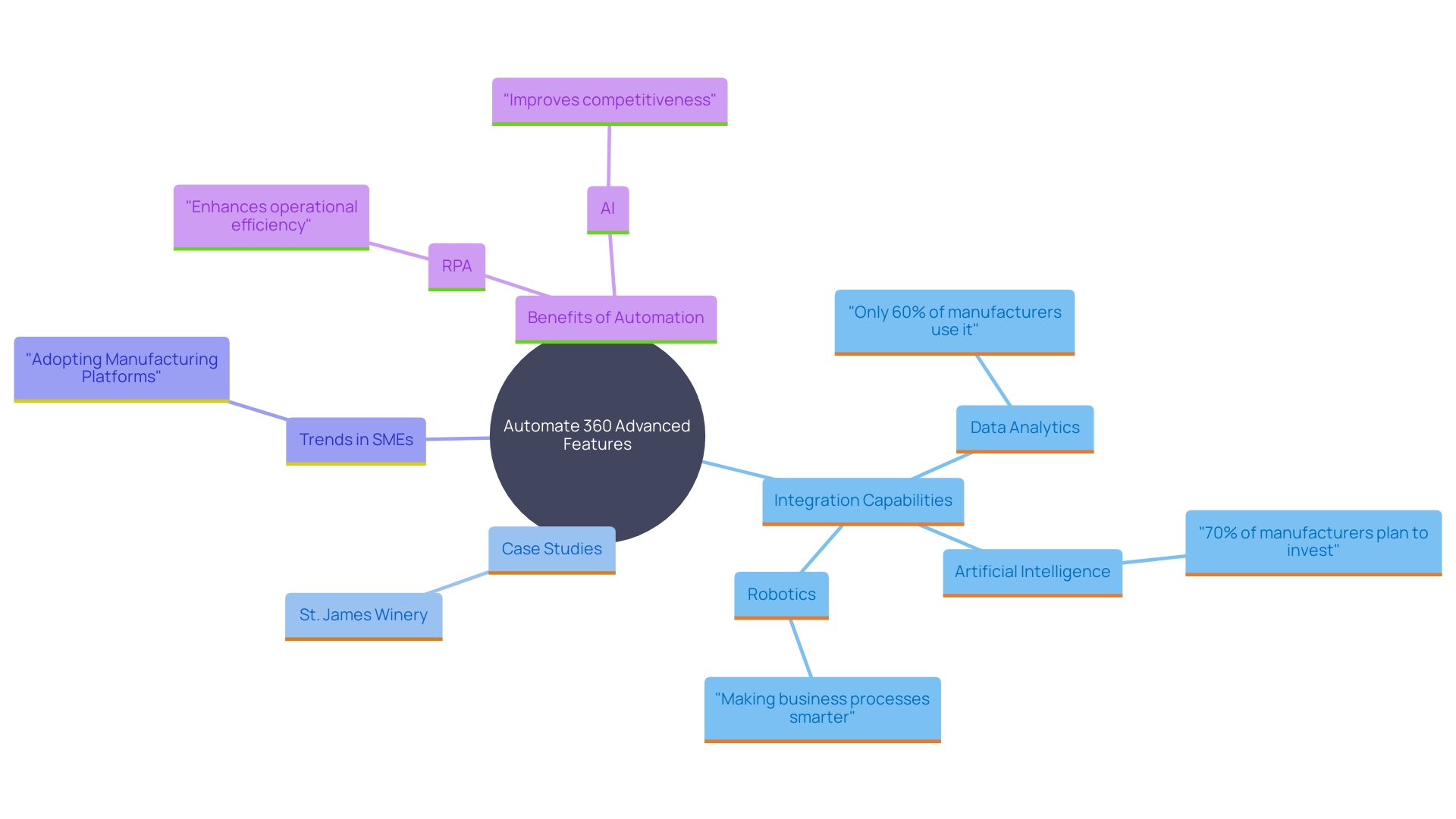
Best Practices for Using Automate 360
To enhance the efficiency of Automate 360, adopt best practices such as regularly reviewing and updating your processes. This continuous improvement approach was successfully implemented by Delivery Hero, where automating account recovery processes saved 200 hours per month, highlighting the impact of frequent updates.
Gathering feedback from users is equally essential. Bosch’s development of the SOFC system demonstrates the power of user insights in creating highly efficient solutions, reducing time and resource consumption.
Additionally, continuously monitor performance metrics to identify areas for improvement. The State of the Automation Professional report emphasizes the significance of monitoring metrics, indicating that 2024 is set for the incorporation and application of AI solutions, fueled by insights from 1,909 industry experts.
By staying proactive, you ensure your automation remains aligned with business objectives, much like how ConnectWise RPA has enabled teams to automate repetitive tasks, thus increasing efficiency and competitiveness.
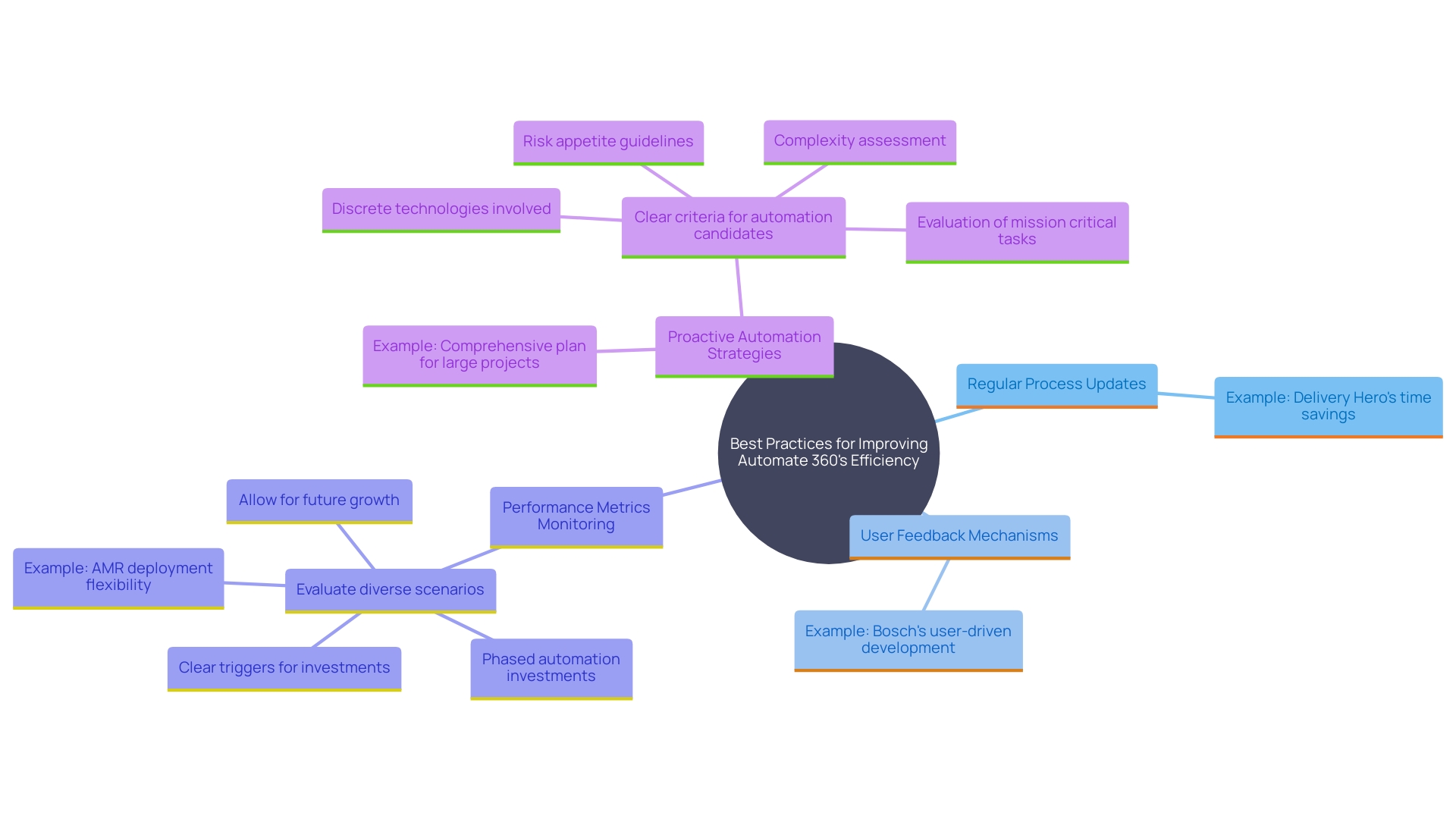
Conclusion
The exploration of automation through Automate 360 reveals its potential to revolutionize business operations by driving efficiency, reducing errors, and enhancing overall productivity. By understanding the fundamentals of automation, organizations can strategically implement tools like Robotic Process Automation (RPA) to streamline labor-intensive tasks. The case studies of companies such as St. James Winery and Delivery Hero exemplify how automation can lead to significant cost savings and improved operational performance.
Preparation is critical for a successful automation journey. Assessing existing workflows and ensuring a collaborative environment are essential first steps. The setup of the Automate 360 account, navigation of its interface, and the creation of initial automations lay the groundwork for a smoother transition into automated processes.
Furthermore, configuring triggers and actions effectively can optimize efficiency and minimize downtime, as demonstrated by the success stories of various organizations.
Testing and troubleshooting are vital components of the automation process. Regular evaluations and adjustments based on user feedback and performance metrics can significantly enhance the effectiveness of automation initiatives. By embracing advanced features and integrations, businesses can remain competitive in an evolving landscape, ensuring that automation continues to align with their strategic goals.
In conclusion, leveraging automation through Automate 360 presents a transformative opportunity for organizations to enhance their operational efficiency and adaptability. By following best practices and staying informed about industry trends, businesses can harness the full potential of automation, driving sustained growth and innovation in their respective fields.
Introduction
In a rapidly evolving business landscape, the quest for operational efficiency and productivity is more critical than ever. Robotic Process Automation (RPA) emerges as a transformative solution, enabling organizations to overcome labor shortages, reduce costs, and enhance accuracy. By automating repetitive and mundane tasks, RPA liberates human talent for more strategic and value-added activities.
This article delves into the multifaceted benefits of RPA, illustrating how businesses can leverage this technology to drive growth, optimize resources, and improve decision-making. Real-world examples underscore the practical applications of RPA, showcasing its potential to revolutionize workflows and create a more dynamic and competitive business environment.
Enhanced Productivity
Robotic Process Automation (RPA) has the ability to enhance productivity by managing repetitive duties, allowing employees to concentrate on strategic activities that contribute more value. For instance, RPA can automate data entry, extraction, and document processing, which are traditionally time-consuming and prone to human error. This shift not only enhances accuracy but also reduces the need for overtime or temporary staff during peak periods, as RPA systems can operate 24/7.
The advantages of RPA reach further than simple task execution. By investing in the right tools and upskilling the workforce to complement these systems, companies can create a more harmonious and efficient work environment. Case in point: St. James Winery in Missouri adopted mechanization to address labor shortages and has since experienced higher margins and enhanced operational outcomes.
Furthermore, incorporating RPA within an organization is part of a larger strategy referred to as Hyperautomation, which views the implementation of technological advancements as an ongoing process of enhancement. This approach is crucial for maintaining competitiveness and optimizing processes.
Statistics indicate that mechanization can significantly enhance employee health and safety. For example, each standard deviation increase in the use of robots reduces workplace injuries by about 16% in the U.S. and decreases physical work intensity by 4% in Germany. This results in healthier work environments and higher job satisfaction.
Ultimately, RPA and broader mechanization strategies are not just about technology; they represent a strategic imperative for modern enterprises aiming to unlock their full potential and drive sustainable growth.

Increased Efficiency and Reduced Costs
By streamlining operational processes through Robotic Process Automation (RPA), businesses can significantly reduce the time required to complete tasks. This enhanced efficiency not only lowers operational costs but also allows companies to reallocate resources to more strategic activities. For instance, St. James Winery, a prominent wine manufacturer in the U.S., adopted technology to manage growth and labor shortages, leading to higher margins and more efficient operations. Similarly, Europris, Norway’s leading discount chain, consolidated six warehouses into one automated logistics center, drastically improving their operational efficiency. According to Allied Market Research, the Robot Operating Systems Market is expected to grow at a CAGR of 12.9% from 2023 to 2032, reaching $1.8 billion, underscoring the increasing adoption of automation technologies. Moreover, RPA works 24/7, eliminating the need for overtime pay or temporary staff during peak seasons, which further contributes to cost savings. As one specialist observes, ‘RPA software can carry out repetitive activities at a significantly quicker speed than humans, without the requirement for pauses or rest,’ enabling employees to concentrate on more value-added responsibilities.
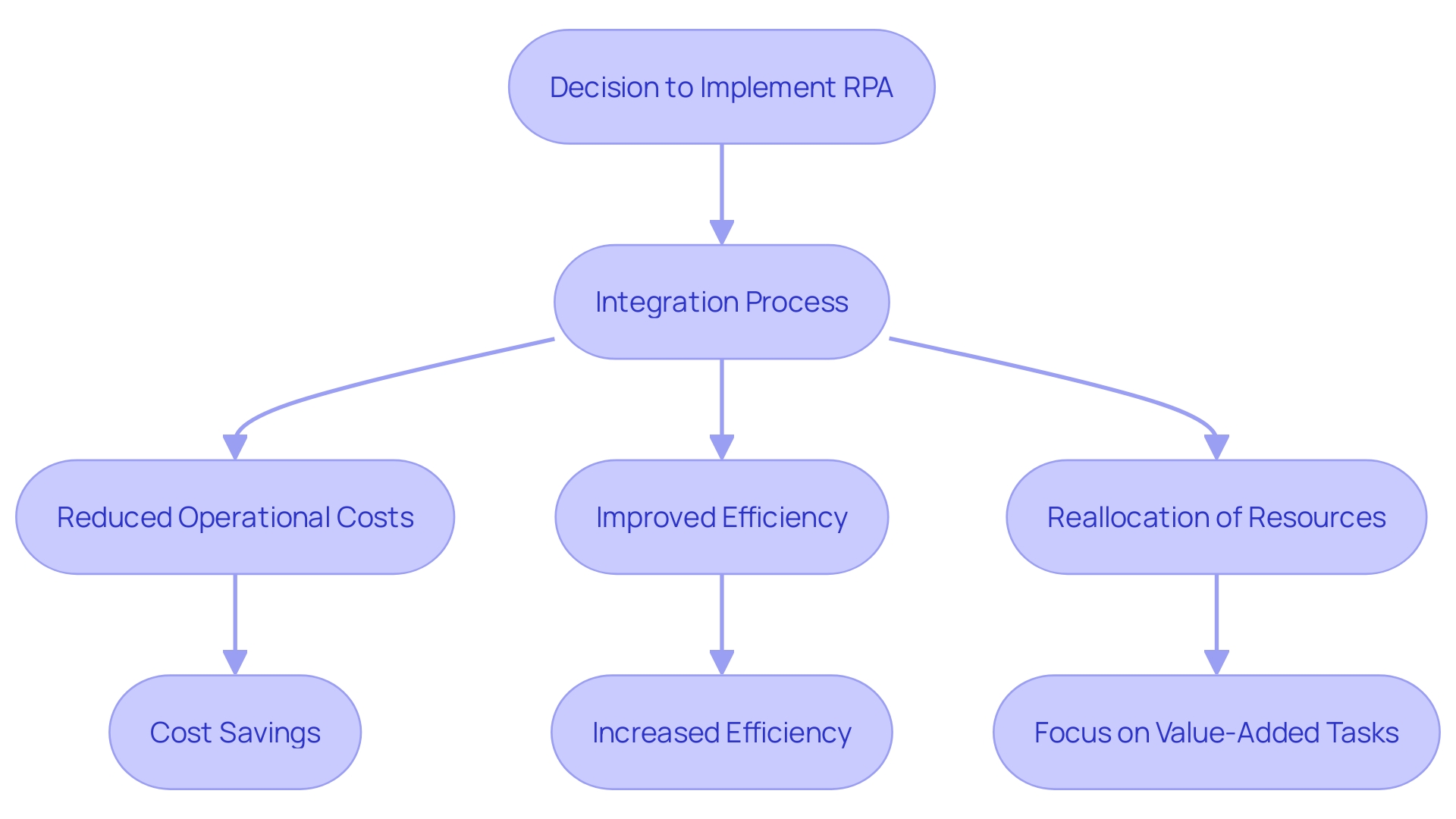
Improved Accuracy and Reduced Errors
RPA reduces human mistakes by carrying out activities with unmatched accuracy and reliability. This improvement in accuracy not only enhances the quality of work but also significantly reduces the risk of costly mistakes, ensuring a higher standard of output. For instance, a study at California State University revealed that utilizing tools like Postman has streamlined their processes, reducing API testing times from two weeks to just one day. This leap in efficiency underscores how RPA can eliminate repetitive steps and adjust variables seamlessly, a benefit that translates into higher productivity and collaboration within large organizations. Additionally, RPA’s ability to operate 24/7 without error drastically cuts labor costs and eliminates the need for overtime pay, as highlighted in various industry reports. By utilizing such technology, companies can concentrate on more value-enhancing activities, promoting overall business growth and efficiency.
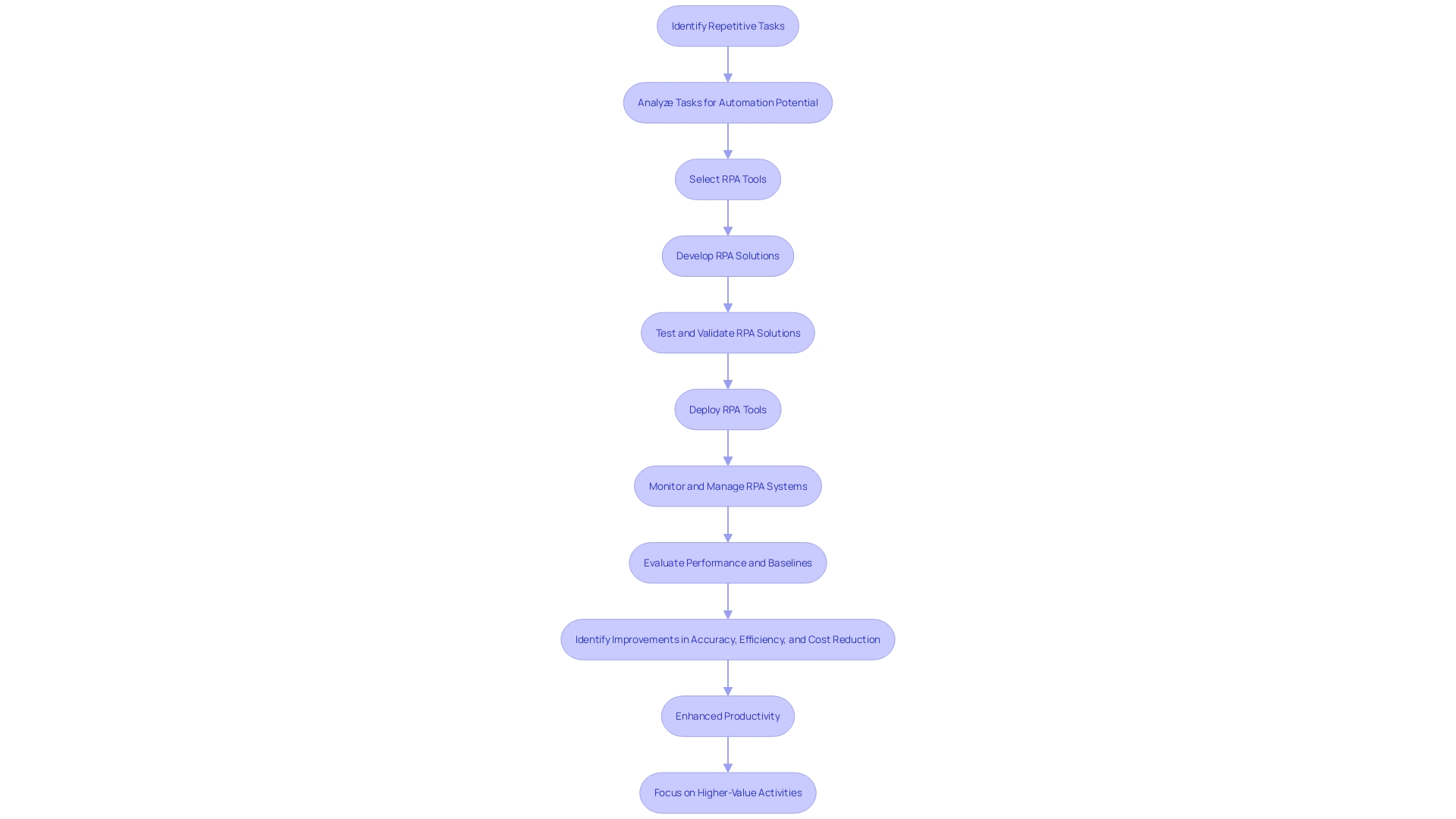
Scalability and Flexibility
RPA solutions offer exceptional scalability, enabling businesses to adjust operations swiftly in response to fluctuating market conditions or operational demands. This adaptability is invaluable, as it allows organizations to handle increased workloads or scale down during quieter periods without substantial financial outlay. For instance, St. James Winery, faced with rapid growth and labor shortages, introduced mechanization to enhance production speeds and profit margins. Similarly, Amazon’s integration of over 750,000 robots has revolutionized its operations, improving efficiency and creating new job categories despite reducing the overall workforce. This trend underscores how RPA can seamlessly integrate with existing systems, automate routine tasks, and maintain high accuracy, all while providing businesses the agility needed to stay competitive in dynamic environments.
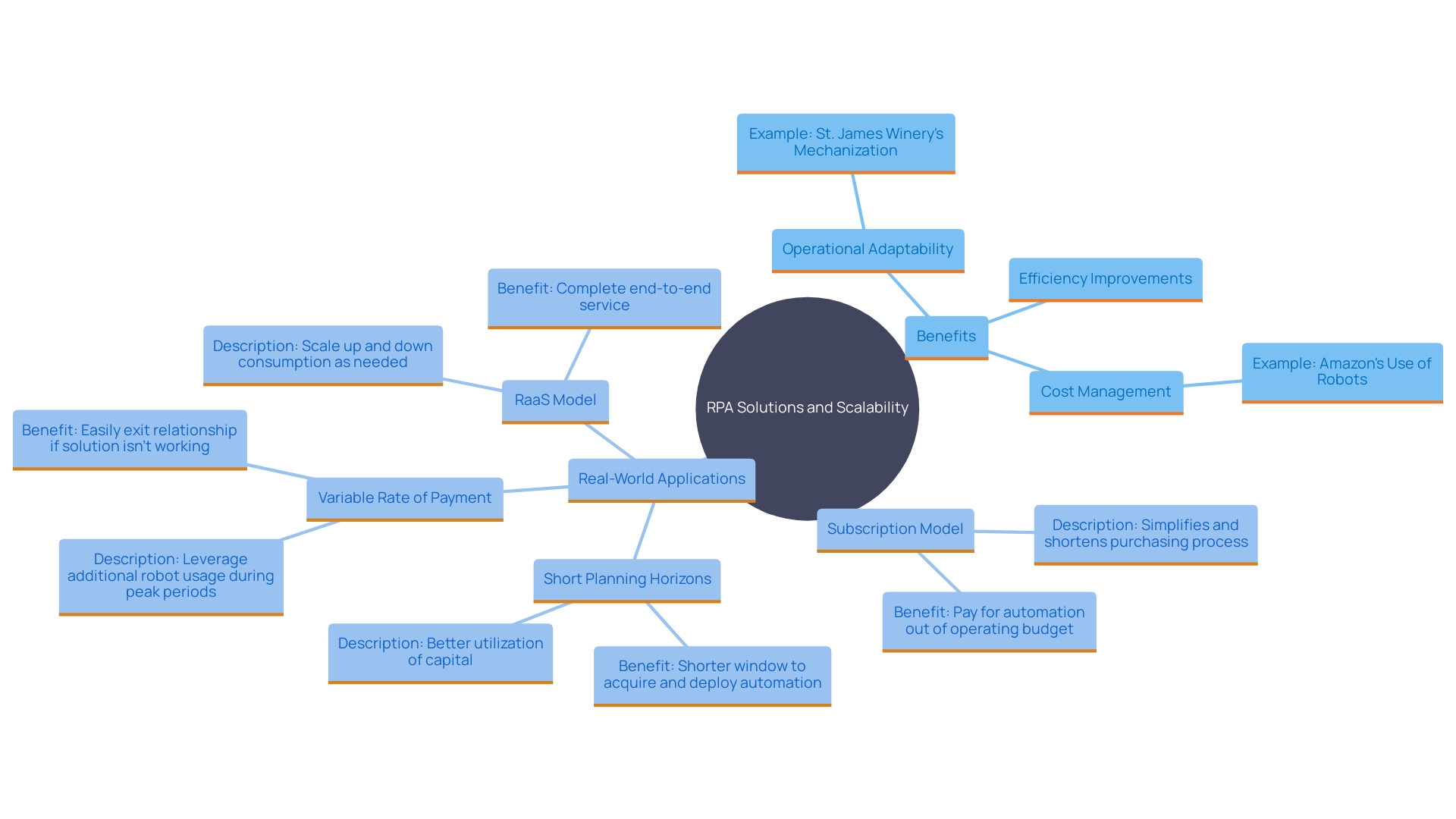
Better Customer Experience
By automating customer service processes such as inquiries and order processing, RPA dramatically improves the overall customer experience. For instance, St. James Winery, a prominent wine maker in the U.S., has experienced substantial advantages from mechanization, including higher margins and increased production speeds. Similarly, companies that implement RPA experience faster response times, which directly contribute to higher customer satisfaction and loyalty. Statistics reveal that 80% of customers believe that a company’s experience is as important as its products or services, and 45% of consumers expect their issues to be resolved in the first interaction. Additionally, modern customers demand quick responses, with 46% wanting companies to reply to their queries within four hours. By adopting mechanization, businesses can meet these expectations, ensuring consistent and exceptional service that keeps customers returning.
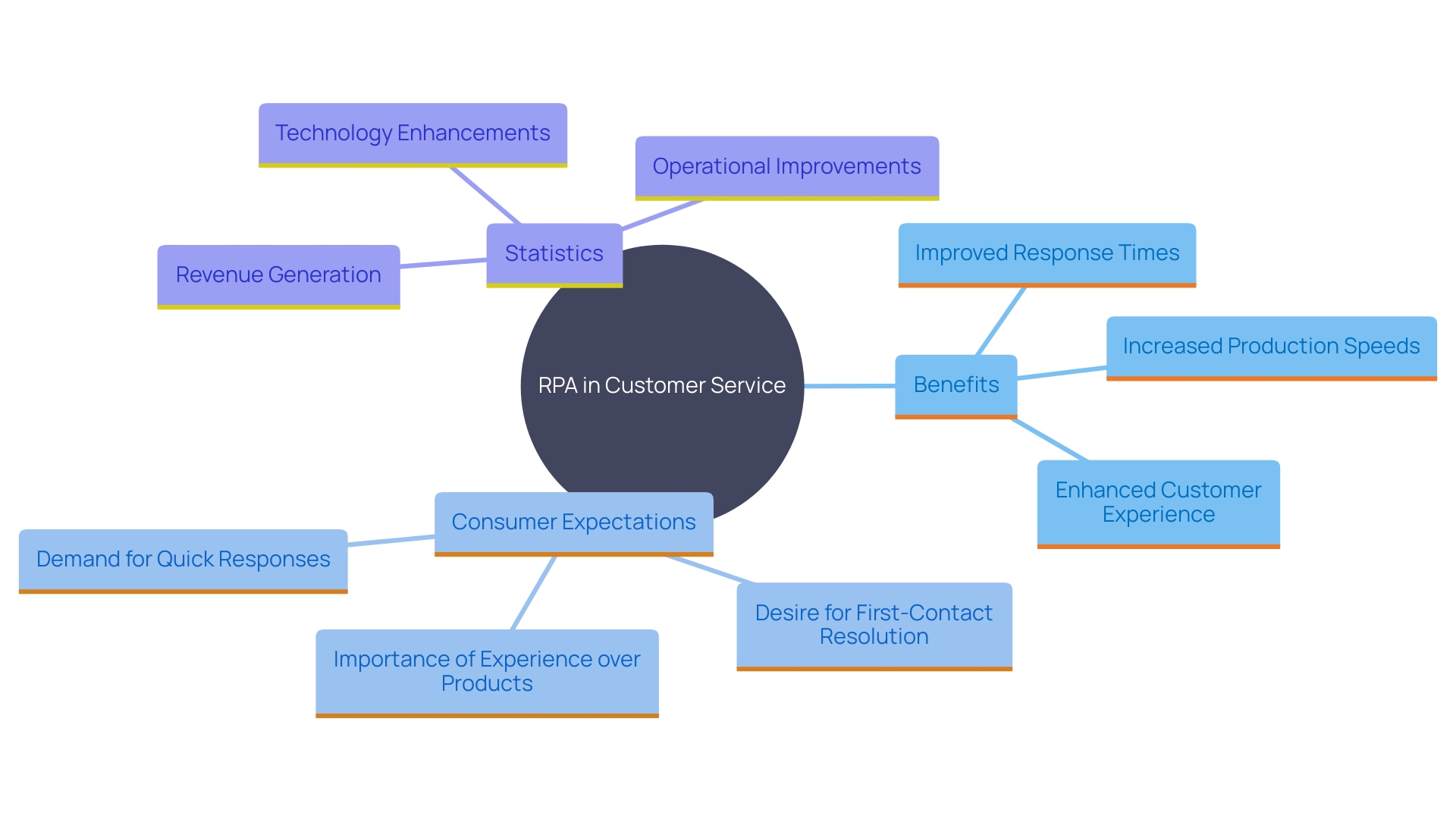
Improved Decision-Making with Enhanced Data Insights
RPA tools excel in gathering and analyzing data, transforming it into actionable insights that drive strategic planning and decision-making. These capabilities significantly enhance overall business performance by enabling organizations to maximize resource utilization and improve system operations. For instance, in the healthcare industry, 93% of hospitals have adopted process automation, highlighting its critical role in workflow optimization. By automating routine activities such as data entry and transaction processing, RPA not only frees up valuable human resources for more strategic endeavors but also enhances efficiency and effectiveness. As Eric Jang, VP of AI at 1X Technologies, explains, ‘RPA can predict how the world changes in response to a robot’s actions,’ underscoring the importance of advanced data analysis in bridging gaps between simulated and real-world environments. This robust data capability empowers organizations to make informed decisions, ultimately driving their productivity and growth.
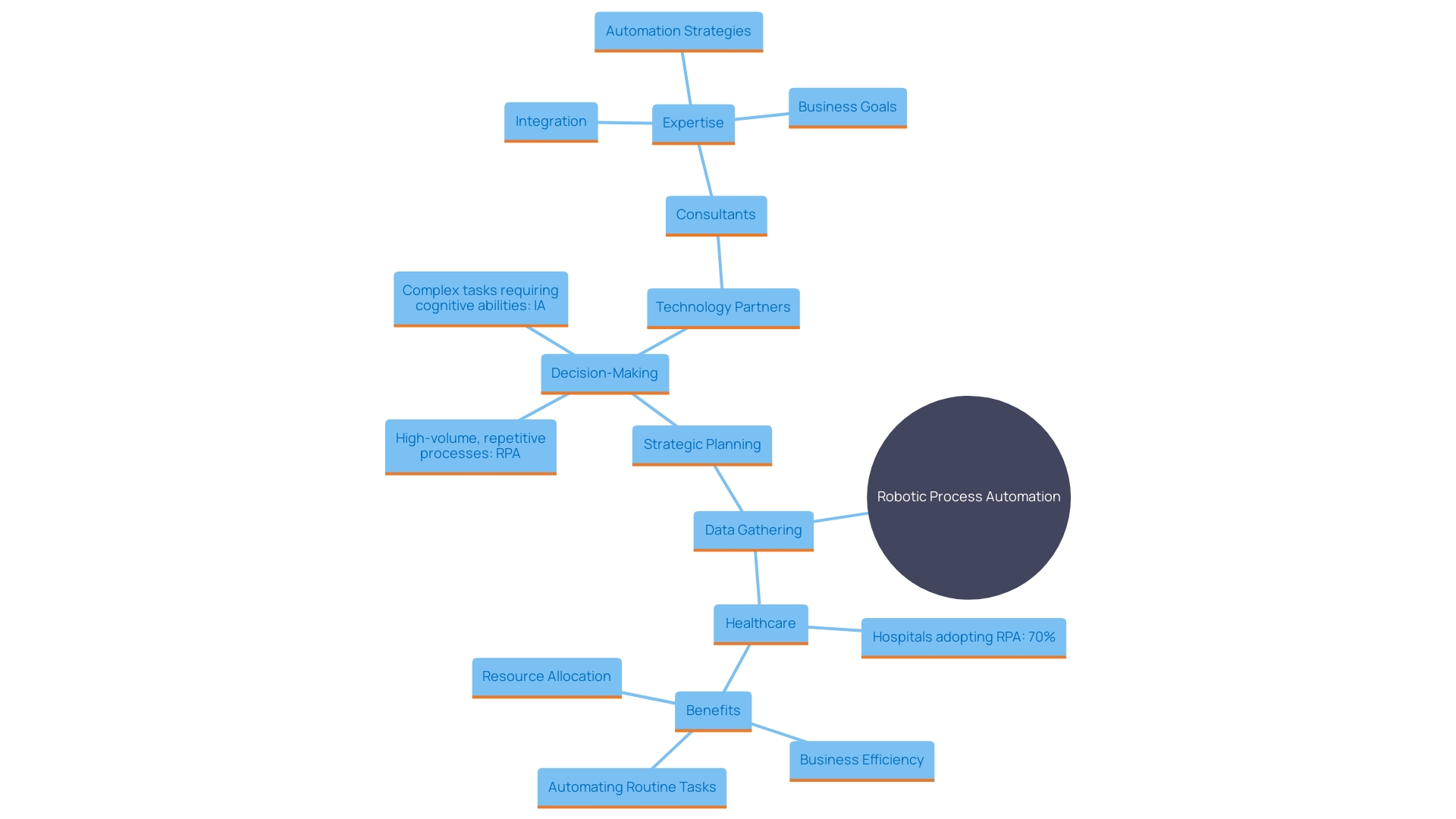
Strategic Resource Optimization
Robotic Process Automation (RPA) enables organizations to optimize their resources by reallocating human talent to more critical areas. This strategic resource allocation significantly enhances workforce engagement and drives innovation within the organization. For example, Delivery Hero, operating in over 70 countries with more than 53,000 staff members, faced the challenge of frequent account lockouts, which required substantial IT involvement to resolve. By implementing RPA, the company streamlined the recovery process, reducing the time personnel spent locked out of their accounts and allowing IT staff to focus on more impactful tasks. This not only enhanced operational efficiency but also raised staff morale and productivity. Similarly, Atlas Healthcare Partners experienced considerable improvements in financial performance and staff capacity by adopting automation, leading to enhanced team coordination and reduced role redundancies. These real-world examples underscore how RPA can effectively free up valuable human resources, fostering a more engaged and innovative workforce.
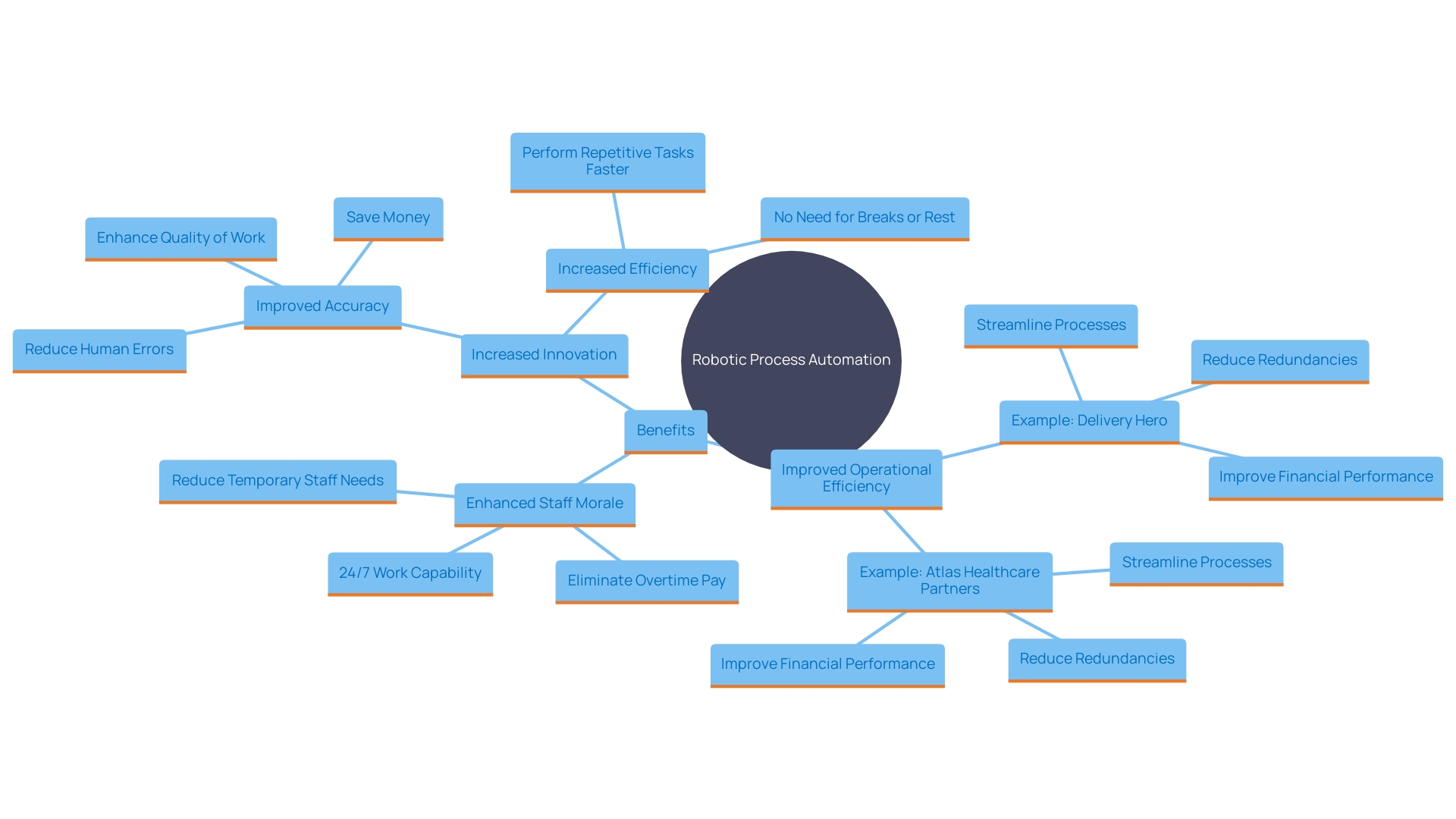
Enhanced IT Support and Integration
RPA can seamlessly integrate with existing IT systems, enhancing the support for various applications and ensuring that technology investments are fully leveraged. For instance, Delivery Hero, operating in over 70 countries with more than 53,000 staff members, faced a significant challenge with individuals being frequently locked out of their accounts. The IT service delivery team, led by Dennis Zahrt, implemented an RPA solution to automate the account recovery process. This reduced the average recovery time from 35 minutes to mere seconds, allowing employees to return to work promptly. Similarly, a partnership with Redox enabled Ambience to navigate the complexities of healthcare data integration, propelling product adoption rates and allowing the company to focus on innovation. These examples illustrate how RPA can improve system performance, streamline operations, and free up resources for more strategic activities. According to a report by Allied Market Research, the global Robot Operating Systems market is projected to reach $1.8 billion by 2032, reflecting a CAGR of 12.9% from 2023 to 2032. This growth underscores the increasing reliance on automation to drive efficiency and productivity in various industries.
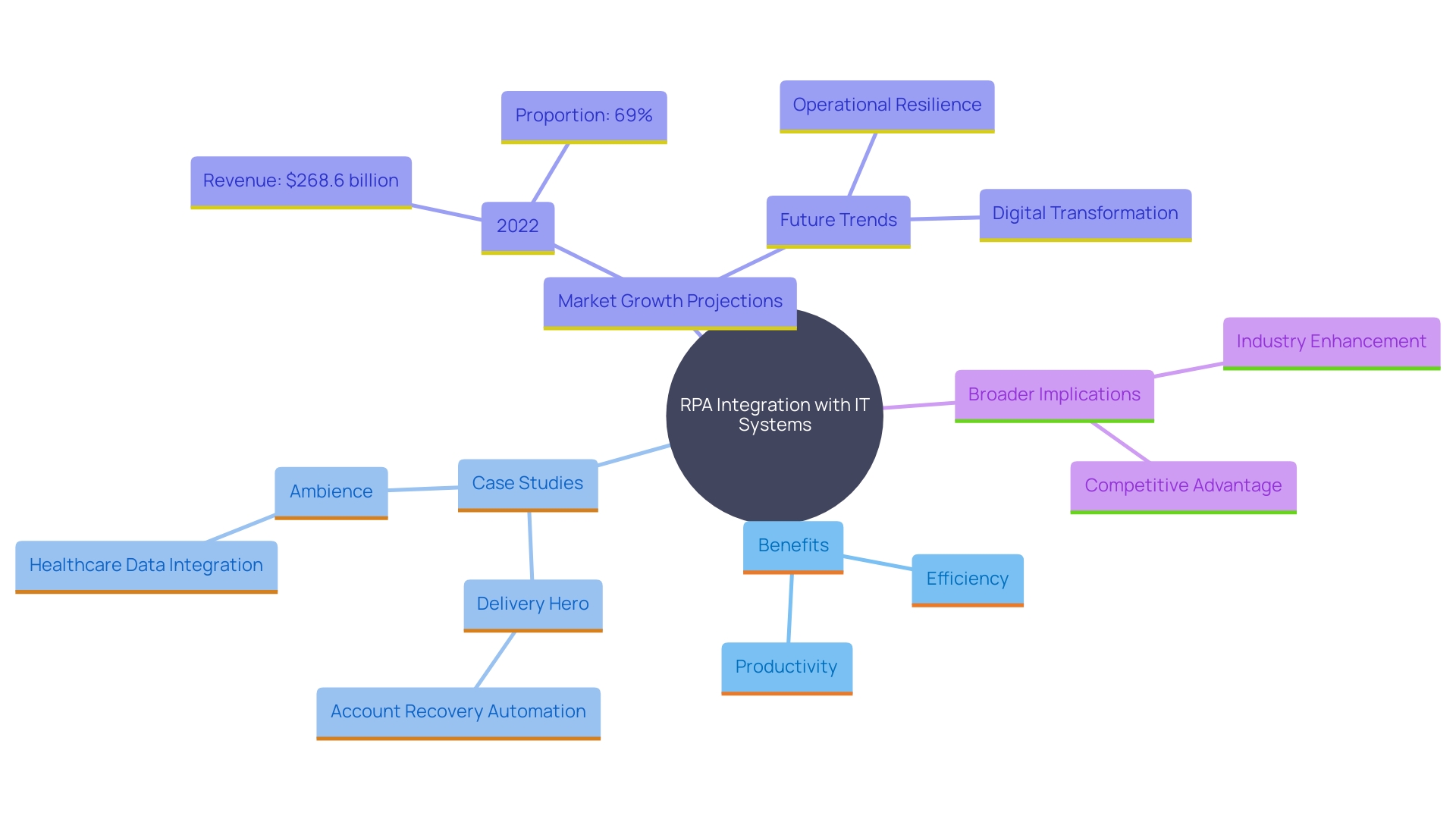
Conclusion
Robotic Process Automation (RPA) is essential for businesses aiming to boost productivity and streamline operations. By automating repetitive tasks, organizations can reallocate human resources to more strategic activities. Success stories from companies like St. James Winery and Delivery Hero demonstrate RPA’s effectiveness in enhancing operational efficiency, increasing margins, and addressing labor shortages.
Additionally, RPA minimizes human error and contributes to a healthier work environment, resulting in improved job satisfaction.
The financial advantages of RPA are significant, as it reduces operational costs and enhances resource allocation. With its ability to operate continuously, RPA decreases the reliance on overtime and temporary staff, allowing businesses to adapt quickly to market fluctuations. The increasing adoption of automation technologies is reflected in the projected growth of the Robot Operating Systems market.
Moreover, RPA improves decision-making by transforming data into actionable insights, optimizing resource utilization, and enhancing overall performance. By automating routine tasks, organizations can foster innovation and elevate employee engagement. As businesses integrate RPA, they position themselves to meet evolving demands, ensuring exceptional customer experiences and maintaining a competitive edge.
In conclusion, RPA offers transformative potential for organizations. By embracing this technology, businesses can achieve greater efficiency, accuracy, and strategic resource optimization. Implementing RPA is not merely a trend but a strategic imperative for sustainable growth and success in today’s dynamic business landscape.
Introduction
Artificial Intelligence (AI) has emerged as a game-changer in the business world, significantly transforming operations across various industries. By leveraging AI technologies, companies are achieving unprecedented levels of efficiency and productivity. For instance, a major retail chain successfully utilized AI-driven tools to optimize inventory management, drastically reducing excess stock and improving cash flow.
As businesses strive to remain competitive, the integration of AI not only enhances decision-making processes but also fortifies supply chains, elevating customer satisfaction. In today’s dynamic market, where exceptional customer service is paramount, AI’s role in streamlining business processes is more crucial than ever. This article delves into the benefits of AI, showcases its impact through real-world examples, and provides strategic insights on seamless AI integration to drive operational efficiency and future-proof businesses.
Benefits of AI in Streamlining Business Processes
AI technologies have revolutionized business operations across multiple sectors, driving significant enhancements in efficiency and productivity. Companies that embrace AI for streamlining processes report notable improvements. For instance, a prominent retail chain implemented AI-driven tools to optimize inventory management. By analyzing buyer purchasing patterns and predicting demand, the company reduced excess stock by 30%, significantly lowering holding costs and improving cash flow. This integration of AI not only accelerated decision-making but also enabled a more responsive supply chain, ultimately enhancing client satisfaction.
A recent survey revealed that 76% of decision-makers in e-commerce achieved revenue increases of 11% or more through AI utilization. Businesses across various industries are now leveraging AI for practical applications beyond consumer-focused tools. For example, real-time anomaly detection at the edge using EmbeddedAI and IoT showcases how AI can address operational challenges effectively.
The existing market circumstances require that retailers lower expenses while preserving outstanding client support quality. According to Salesforce’s fifth State of the Connected Customer report, 88% of customers value excellent service as much or more than the products themselves. As businesses continue to adopt AI-driven innovations, they not only stay competitive but also redefine the future of retail in the digital age. Investment in AI is rising, with 86% of e-commerce decision-makers planning to increase their AI investments despite economic headwinds.
AI’s potential to produce innovative information cost-effectively provides a competitive advantage to businesses that seize this trend. Integrating AI is not just a technological upgrade; it’s a strategic move to stay relevant and thrive in today’s dynamic business landscape.
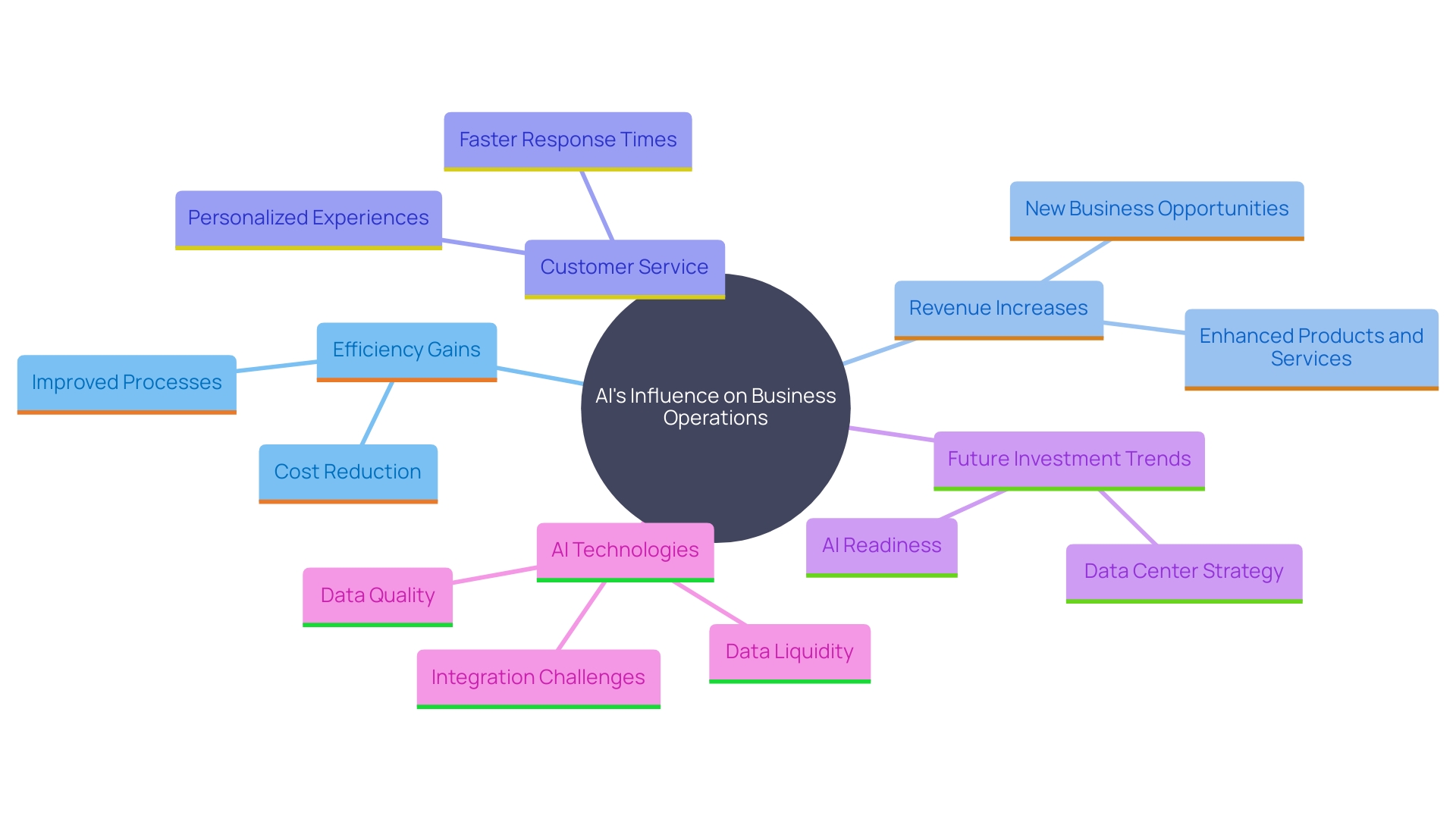
AI-Driven Automation for Efficiency
The integration of AI-driven automation tools has revolutionized operational workflows. For example, Renault’s supply chain transformation started in 2017 with the establishment of an extensive information lake. This strategic move provided a solid foundation for the development of digital applications, enabling precise control over factory supplies. By dedicating 10% of their IT budget to information structuring, Renault developed a control tower connected to partners like Shippeo, significantly enhancing supply chain management.
A leading manufacturing company implemented robotic automation (RPA) combined with AI to handle repetitive tasks in their production line. This led to a substantial 40% reduction in labor costs and a 25% increase in production speed. The AI system constantly learns from the data it analyzes, enabling continual enhancements in efficiency and error reduction.
The Korea Institute of Machinery and Materials (KIMM) recently created an AI technology for robotic tasks that can be easily utilized in various manufacturing activities, including the production of electronic components. This technology, based on the Large Language Model (LLM) and virtual environment, enables automated task sequences and movements, further showcasing AI’s potential to revolutionize manufacturing.
As Professor Dr.-Ing. habil. Sascha Stowasser highlights, AI’s integration into manufacturing not only enhances production efficiency but also transforms the entire value chain from supply chain management to quality control. This case demonstrates the transformative power of AI in making traditional manufacturing methods more agile and cost-effective, heralding a new era of Industry 4.0.
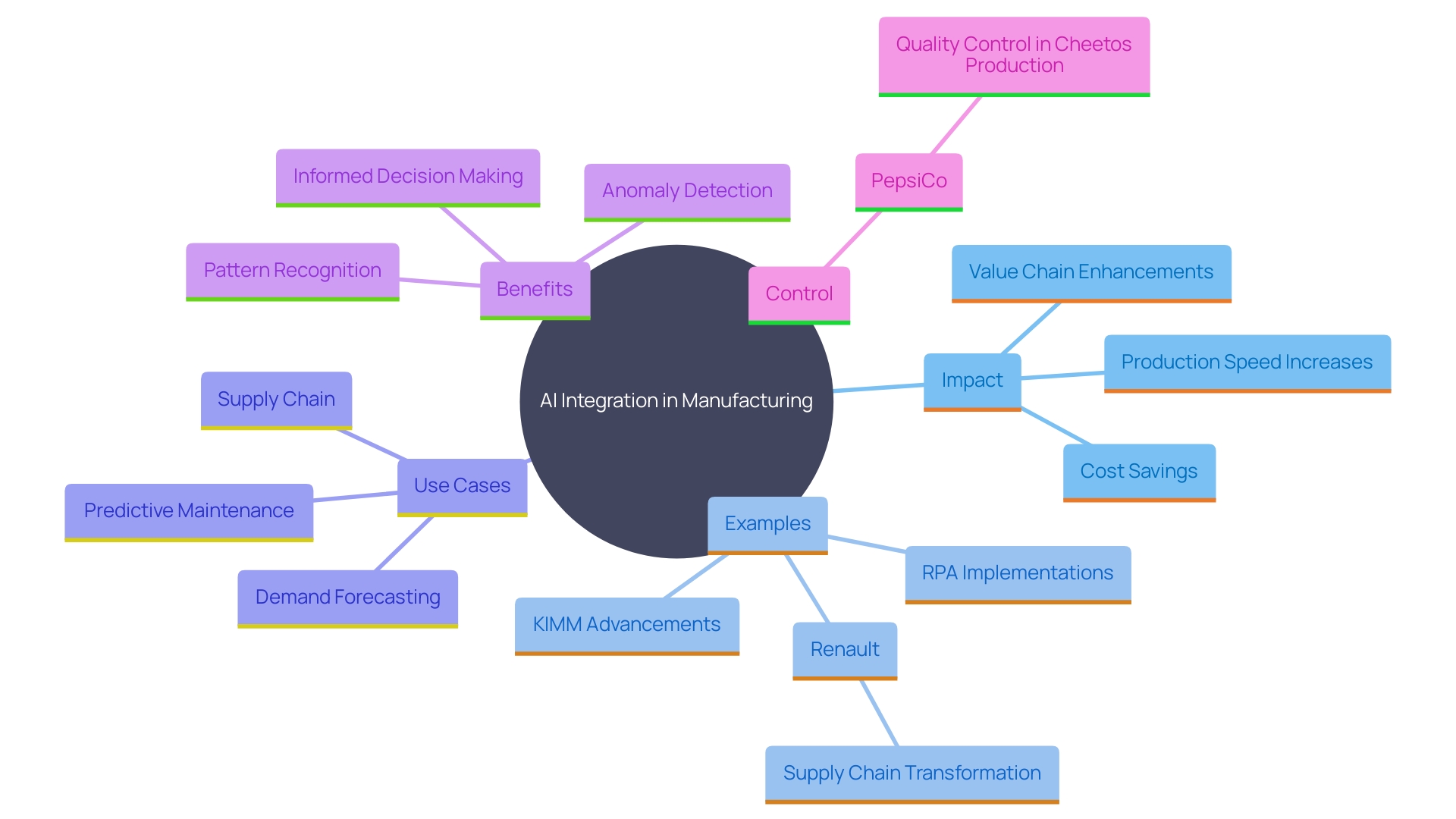
AI Integration Strategies for Seamless Implementation
The successful integration of AI hinges on a robust strategy that aligns technology with business objectives. One financial solutions company embarked on this journey by pinpointing vital areas where AI could enhance value, such as fraud detection and client support. By conducting pilot programs and gradually scaling up successful initiatives, they ensured a smooth transition. Furthermore, they emphasized training employees to work alongside AI systems, leveraging human expertise to complement machine learning capabilities. This approach resulted in a seamless implementation process and higher acceptance rates among staff.
A report by EXL highlights that around 89% of insurance and banking firms in the UK have introduced AI solutions over the past year. This trend highlights the increasing significance of AI in financial sectors. Additionally, Accenture’s analysis reveals that 73% of the time spent by US bank employees has a high potential to be impacted by generative AI, with 39% by automation and 34% by augmentation. This potential encompasses almost every area of a bank, from the C-suite to the front lines of support.
Moreover, the convergence of AI and embedded finance presents transformative opportunities for the financial sector. However, the black box nature of certain AI models and the potential for algorithmic bias necessitate a commitment to transparency. Financial solutions providers and fintechs must invest in Explainable AI (XAI) to ensure that every decision made by an AI model is understandable, justified, and trusted by end users.
In terms of implementation, organizations face significant challenges in scaling AI projects. Data quality remains a major obstacle, with many enterprises struggling to move AI projects into production due to weak data foundations. In spite of these challenges, leaders in AI adoption are producing 62% of the value in core business processes, attaining success across various functions, from customer support to operations and procurement.
The strategic deployment of AI in financial services is not just about technology but also about fostering a learning culture that embraces new approaches. By managing the disruptive impact of technology and organizing information effectively, organizations can achieve meaningful improvements in productivity and efficiency. For instance, early adopters in the financial sector are projected to see substantial productivity improvements over the next three years, highlighting the significant potential of AI when integrated thoughtfully.
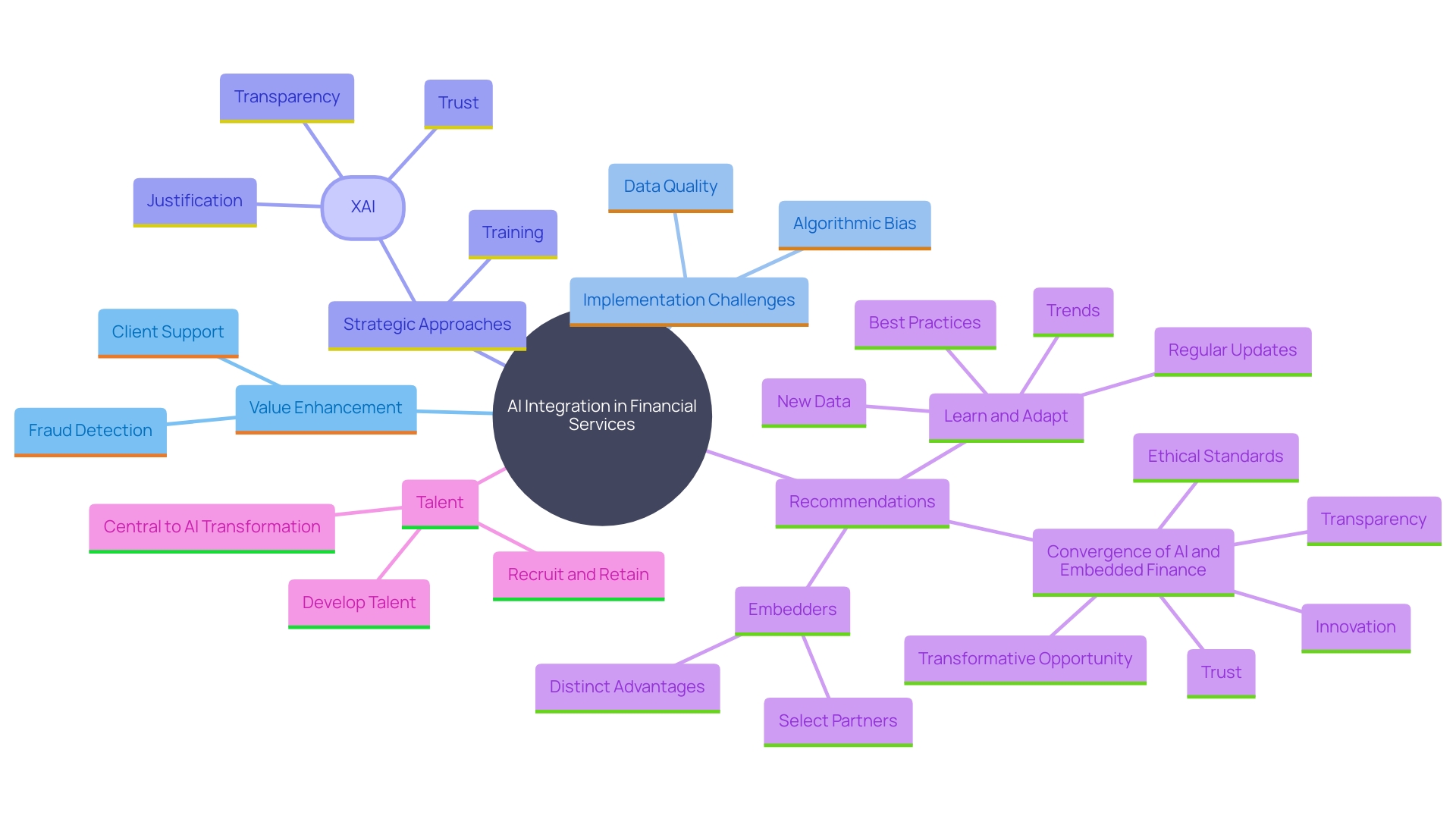
Challenges and Best Practices for AI Implementation
Implementing AI solutions presents various challenges, such as quality issues, resistance to change, and the need for skilled personnel. A healthcare provider faced considerable challenges when implementing an AI system for patient information management. To tackle these issues, the organization prioritized governance of information, ensuring the information utilized by the AI system was accurate and reliable. Early stakeholder engagement was crucial for fostering buy-in and reducing resistance. By adopting best practices like continuous training and iterative development, they successfully implemented the AI solution, leading to improved patient outcomes and operational efficiency. This approach mirrors the experiences of other organizations, such as a pharmaceutical company that achieved a 75% increase in operational efficiency through AI. Furthermore, AI tools have shown substantial benefits across various sectors, including a 20% improvement in customer satisfaction at a leading bank and over $15M in cost reductions for a major international airline. These examples highlight the transformative potential of AI when implemented strategically and with a focus on data quality and stakeholder engagement.
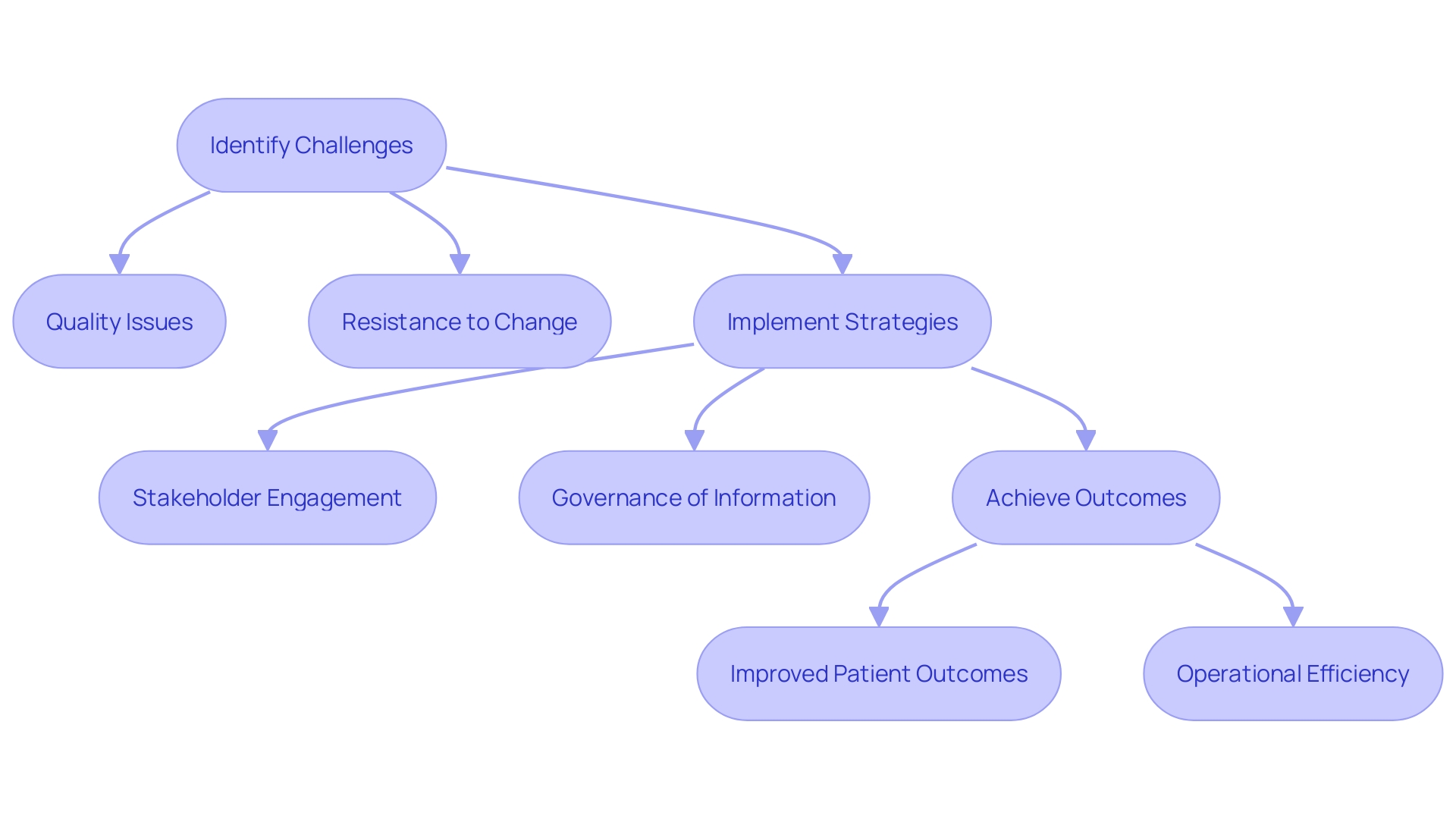
Conclusion
The integration of Artificial Intelligence into business operations is not just a trend; it has become a crucial strategy for driving efficiency and enhancing productivity across various industries. The evidence presented demonstrates that companies leveraging AI technologies are experiencing remarkable benefits, such as significant reductions in operational costs and improved customer satisfaction. For instance, retail chains optimizing inventory management with AI have seen reductions in excess stock and increased cash flow, showcasing how data-driven decision-making can lead to tangible financial results.
Moreover, AI-driven automation exemplifies the potential for operational transformation. Organizations like Renault have successfully utilized AI to enhance supply chain management, while robotic process automation has led to substantial gains in production speed and cost reductions in manufacturing. These examples illustrate that AI is not merely a technological enhancement but a powerful catalyst for reshaping workflows and improving overall efficiency.
However, the successful implementation of AI requires a strategic approach that aligns technology with business objectives. Companies must prioritize data quality, foster a culture of acceptance among employees, and address challenges such as algorithmic bias and the complexities of scaling AI projects. By investing in training and ensuring transparency in AI operations, organizations can maximize the benefits of AI while minimizing resistance to change.
In conclusion, the transformative impact of AI on business processes is clear. Embracing AI is essential for organizations aiming to remain competitive and responsive in today’s fast-paced market. By adopting best practices and focusing on strategic integration, businesses can unlock the full potential of AI, driving operational excellence and paving the way for future growth and innovation.
Introduction
Navigating the complexities of filing an insurance claim can be a daunting task, especially when dealing with intricate policy details and stringent documentation requirements. This article demystifies the process of submitting claims with Old Mutual, providing a comprehensive guide that spans from understanding your policy to troubleshooting common issues. By leveraging advanced technologies such as artificial intelligence and intelligent document processing, the insurance industry is transforming the claims experience, offering quicker resolutions and enhanced customer satisfaction.
Dive into the practical steps and insights outlined below to ensure a seamless and efficient claims process, empowering you to handle your insurance claims with confidence and clarity.
Understanding Your Policy Details
Before starting a request procedure, it’s crucial to carefully examine your insurance agreement. Comprehending the coverage limits, exclusions, and specific conditions related to requests can prevent disappointments and delays. For instance, a case involving Travel Insured International highlighted how misinterpretation of contract terms, such as financial default and cancellation clauses, can lead to claim denials. The individual holding the insurance faced significant legal battles and was ultimately denied coverage, underscoring the importance of understanding your plan inside out.
It’s also crucial to wait for approval from your insurance company before undertaking any actions or repairs, as these may not be included in your coverage. Numerous regulations have stringent rules regarding the time frame for submitting a request, and failing to meet this deadline can lead to automatic rejection. Multiple submissions for the same request can also result in rejections, causing unnecessary delays.
Considering these difficulties, understanding your coverage specifics enables you to manage the requests efficiently and establishes practical expectations. Always consult with insurance experts and leverage available resources to clarify any uncertainties in your coverage.
Gathering Required Documents for Claims
To ensure a smooth and efficient claims procedure, it’s essential to gather and organize all necessary documentation beforehand. This typically includes your policy number, detailed accounts of the incident, photographs, receipts, and any other pertinent records. By having these documents readily available, you can significantly streamline the filing procedure and minimize potential delays. Intelligent document processing (IDP) technology, which utilizes machine learning algorithms and artificial intelligence, can further improve this workflow by automating the organization and analysis of these documents. According to Forrester’s research, the right solutions in intelligent document processing provide a competitive edge in the insurance industry. This technology decreases manual labor, lessens human error, and enables quicker resolution of requests, ultimately enhancing operational efficiency and customer satisfaction. As Munish Arora from Sun Life notes, businesses aim for end-to-end process automation to enhance client experience, which is achievable by addressing the challenges of unstructured data. By utilizing IDP, you ensure that your documentation is not only organized but also efficiently processed, paving the way for quicker and more precise management of requests.
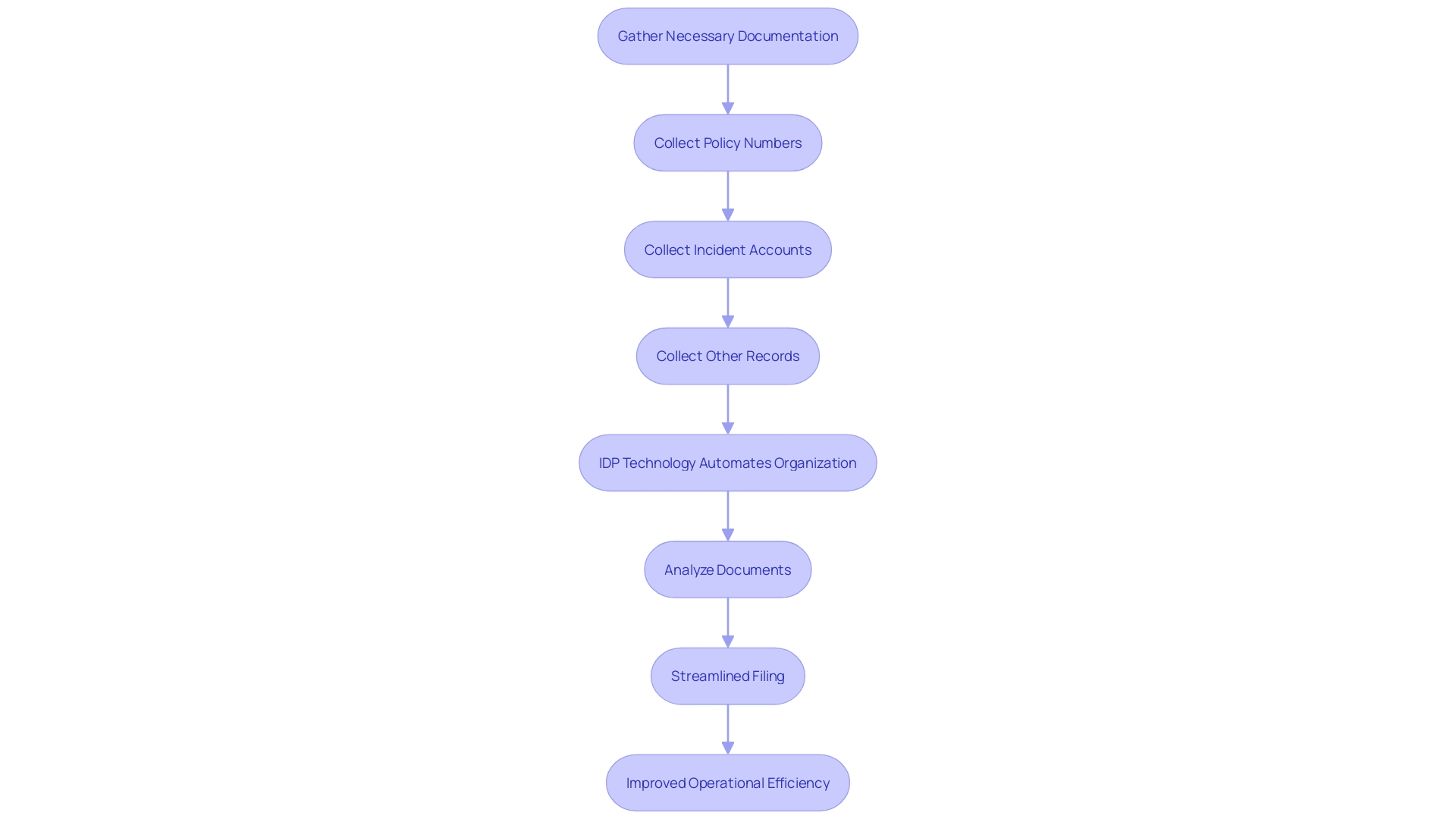
Step-by-Step Guide to Filing a Claim with Old Mutual
- Navigate to the Old Mutual website or contact their department directly. 2. Select the particular kind of request you need to submit. 3. Precisely complete the required application form, ensuring all essential details are included. 4. Submit your completed application form along with the required documentation either online or by mail, as specified. Embracing advanced technologies like artificial intelligence, Old Mutual is streamlining the process to enhance customer satisfaction and efficiency. According to Aleksander Czarnowski, a Senior Consultant at Sollers, insurers are increasingly investing in technology for managing cases to reduce handling costs and provide swift resolutions. This trend is evident in countries like the UK, Poland, and Germany, where digital and automated management of requests is becoming standard.
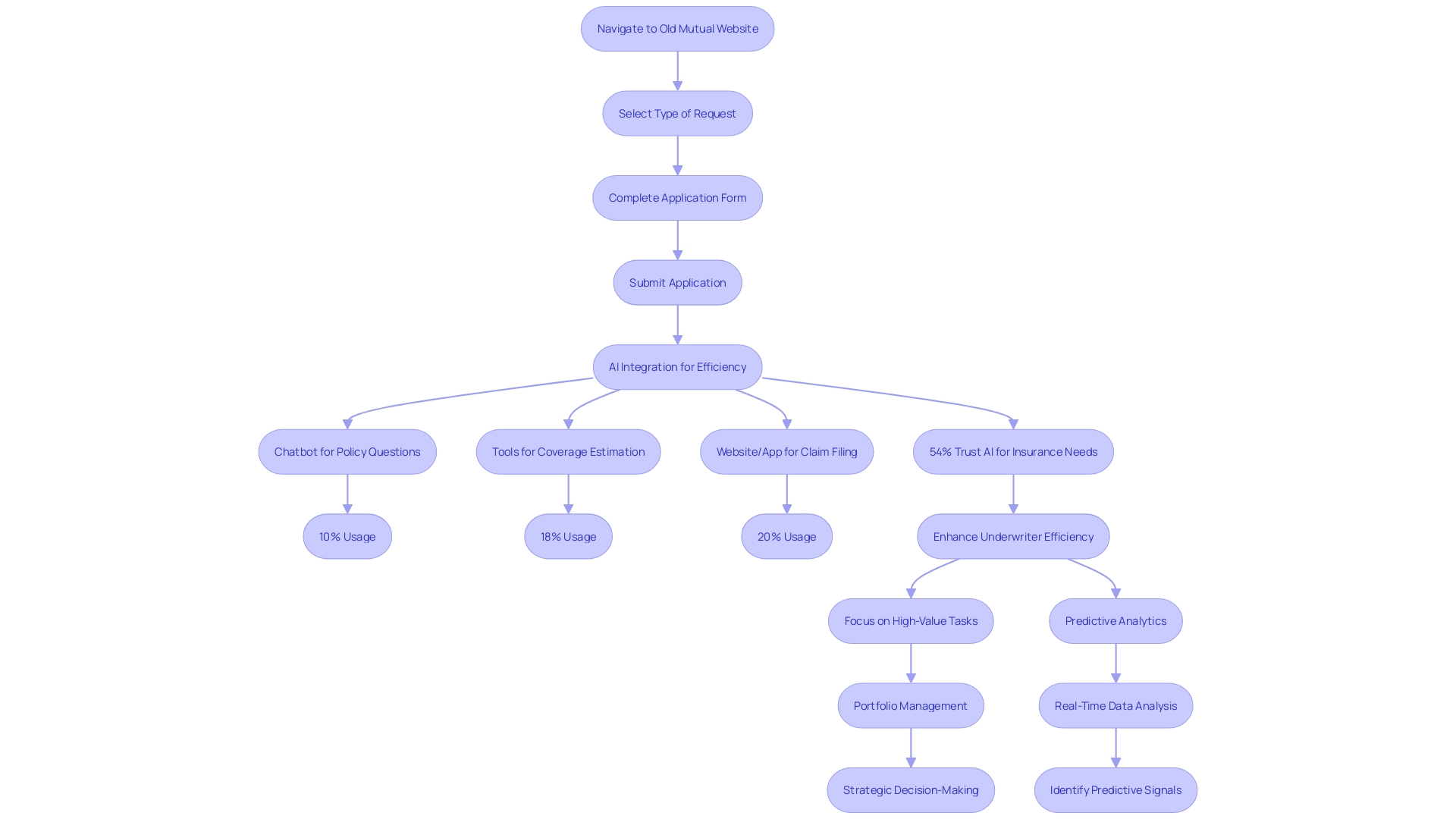
Submission and Processing of Claims
Once your request is submitted, Old Mutual will utilize advanced AI tools to review the documentation provided, significantly accelerating the process. Maintaining a record of your submission and any correspondence with the department is essential. This guarantees you can follow up if needed and monitor the advancement of your request. The application of AI has revolutionized the processing of requests, shortening what used to take months into just weeks or even days. This efficiency is evident in the insurance industry, where straight-through processing (STP) rates have surged from 37% to an impressive 60%, thanks to AI/ML integrations. Moreover, a survey discovered that 63% of clients prioritize rapid processing of requests, emphasizing the significance of prompt resolution of issues. By maintaining accurate records, you ensure a smoother experience and can address any issues promptly.
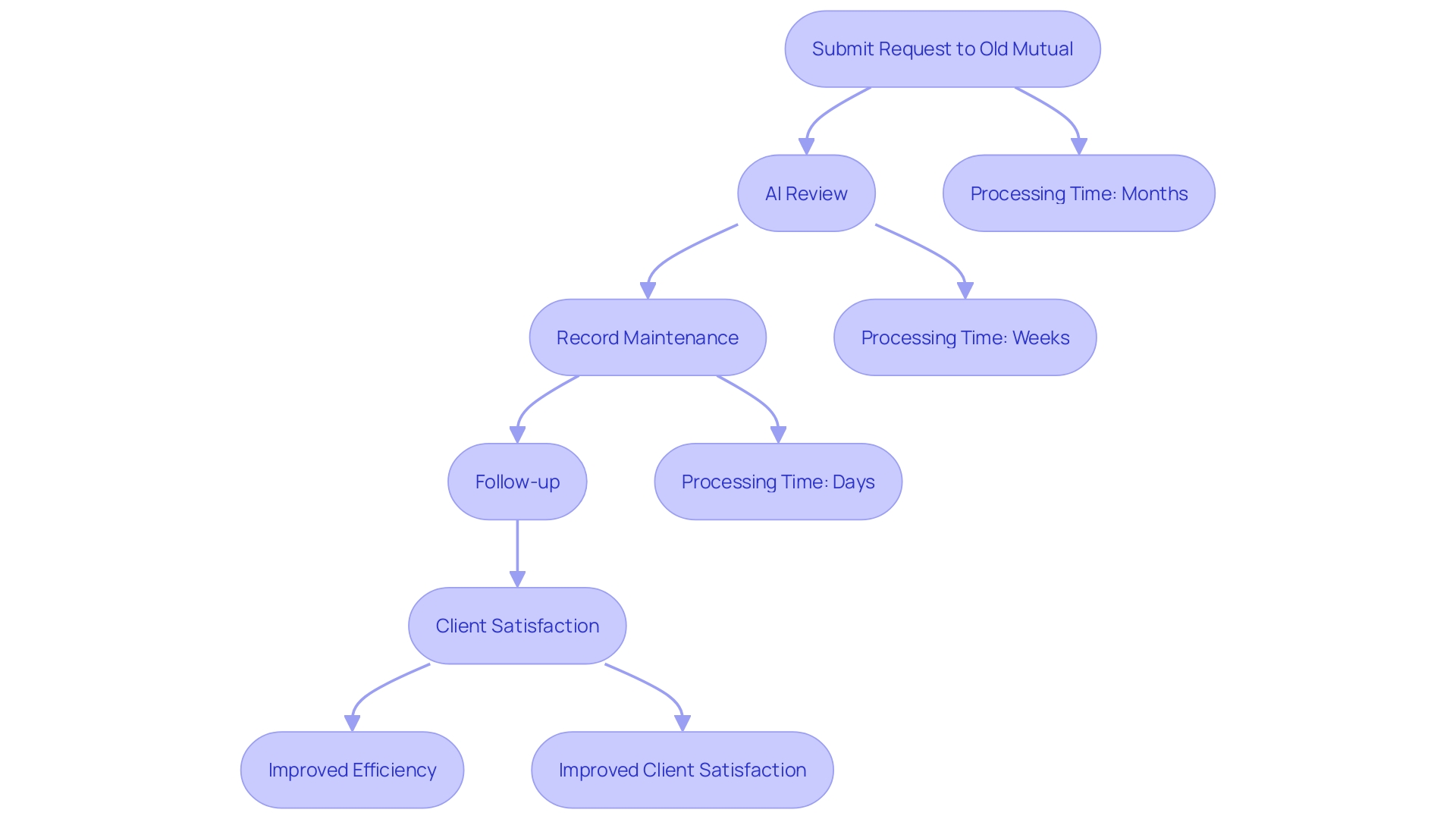
Timeline for Claims Processing and Payment
Claims processing times can vary greatly depending on the complexity of the case. However, with the ongoing advancements in automation and artificial intelligence, the insurance industry is making significant strides in reducing these times. Based on a recent study by Sollers Consulting and Ipsos, clients prioritize fast processing of requests, with 52% to 63% of participants in nations such as the UK, Germany, Poland, and France identifying it as one of their top three expectations. In the UK, this demand is particularly strong at 63%.
Artificial intelligence is becoming a common technology used to simplify management processes, especially in countries like the UK and Poland. This technology not only boosts the effectiveness of processing requests but also increases client satisfaction by delivering quicker replies and lowering management expenses.
Aleksander Czarnołęski, a Senior Consultant at Sollers, emphasizes that for clients, the solution to the problem is more important than the monetary compensation. This viewpoint emphasizes the importance for insurers to invest in technology for handling requests to satisfy client expectations efficiently. The survey emphasizes that insurers are acknowledging the significance of prompt request handling and are increasing their efforts to automate the system. This shift is crucial as it aligns with the industry’s need to evolve rapidly in response to changing customer demands and the competitive landscape.
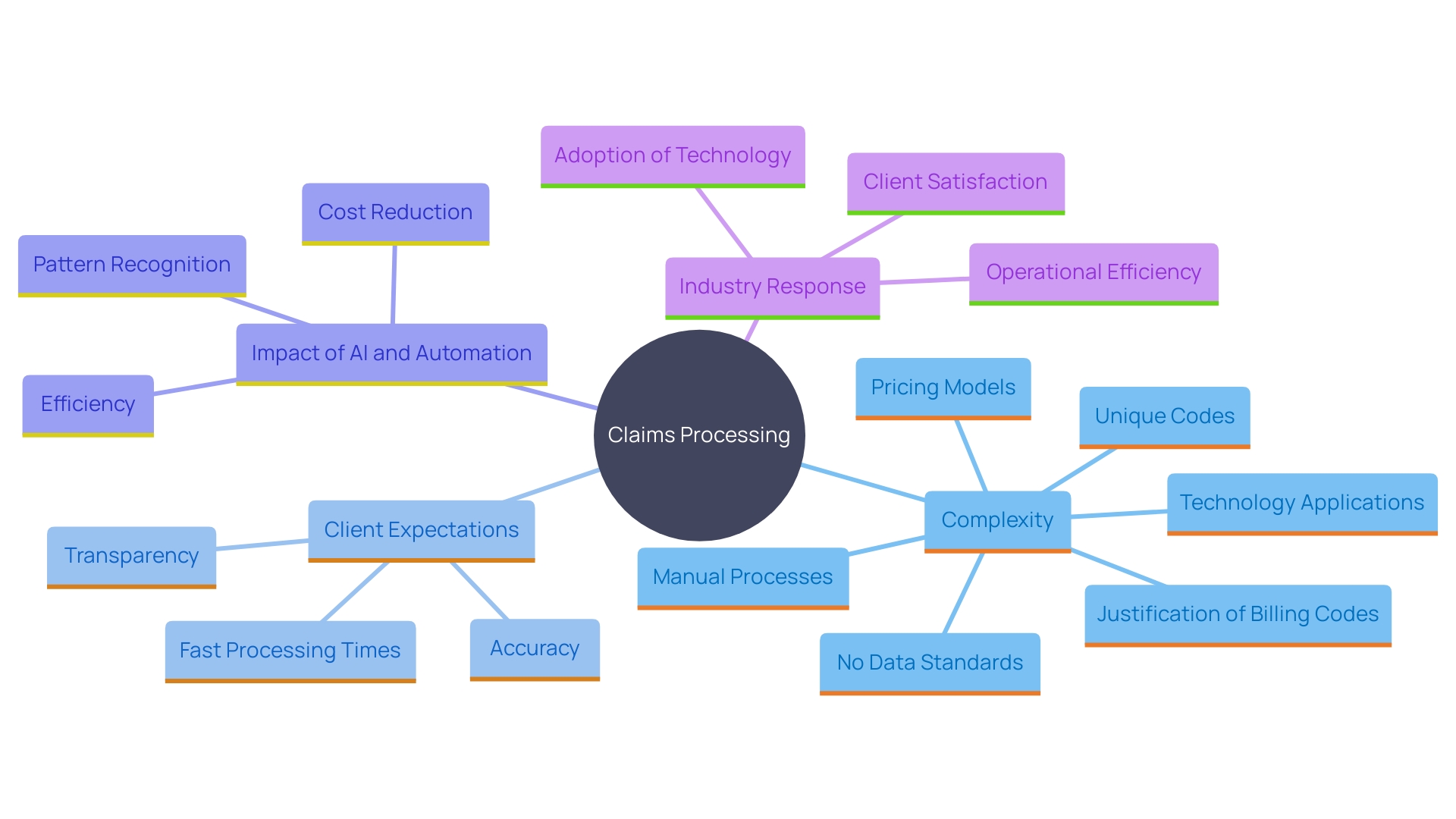
Troubleshooting Common Issues with Claims
If you encounter issues during the claims process, such as delays or lack of communication, consider the following steps to streamline resolution:
- Review Your Submitted Documents: Ensure all submitted documents are accurate and complete. Errors or missing information can cause unnecessary delays.
- Contact Support for Requests: Reach out to Old Mutual’s support for clarification. Updating the request handling with technology can greatly enhance response times and precision.
- Keep Detailed Records: Maintain thorough records of all communications. This helps track progress and facilitates quicker resolution in case disputes arise.
As the insurance sector develops, incorporating AI and automation can boost the effectiveness of the processing system, minimizing the duration spent on administrative duties and enhancing client satisfaction.
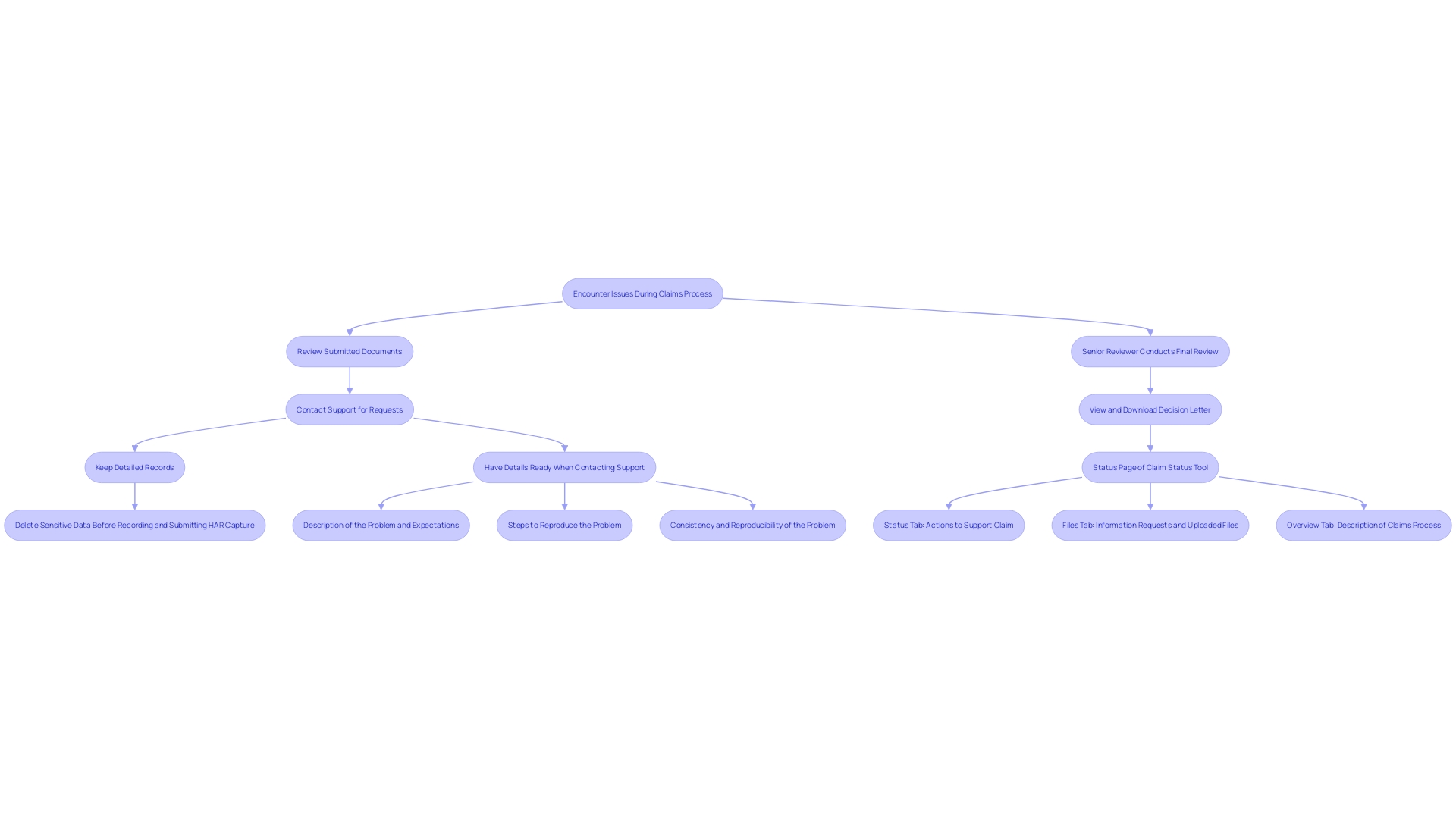
Contact Information for Old Mutual Claims Support
For smooth help with your insurance requests, Old Mutual’s support team is easily reachable via their service hotline or their official website. With the increasing demand for faster processing of requests, as highlighted by a recent survey showing that 63% of customers in the UK prioritize quick responses, it’s crucial to have your policy number on hand for expedited service. This approach ensures a smoother experience, meeting the high expectations for prompt and efficient claims handling.
Conclusion
Understanding the intricacies of the insurance claims process is vital for achieving successful outcomes. A thorough review of policy details lays the foundation for effective navigation, ensuring that all coverage aspects are understood and adhered to. This knowledge empowers individuals to avoid common pitfalls that can lead to claim denials and delays, reinforcing the importance of consulting with experts when uncertainties arise.
Organizing and submitting the required documentation is another crucial step in the claims process. The integration of intelligent document processing technologies enhances efficiency, allowing for accurate and timely claims management. By preparing all necessary documents in advance, individuals can significantly streamline their claims submissions and improve the likelihood of prompt resolutions.
The use of advanced technologies, such as artificial intelligence, is revolutionizing how claims are processed. These innovations not only reduce the time needed for claims handling but also enhance customer satisfaction. Maintaining clear communication and detailed records throughout the process ensures that any issues can be swiftly addressed, further contributing to a smoother experience.
In conclusion, navigating the claims process with Old Mutual—or any insurer—requires a proactive and informed approach. By understanding policy details, gathering necessary documentation, and leveraging technology, individuals can empower themselves to manage their claims effectively, ultimately leading to quicker resolutions and improved satisfaction.
Introduction
In the ever-evolving landscape of infrastructure development, the role of installation engineers is paramount. This article delves into the intricacies of installation engineering, highlighting its critical importance in ensuring seamless integration and operational efficiency of infrastructure projects. By exploring the key responsibilities and challenges faced by installation engineers, the discussion underscores their vital contribution to project success.
Additionally, practical solutions and innovative technologies that enhance the efficiency and effectiveness of installation processes are examined, providing valuable insights for overcoming common hurdles. With a forward-looking perspective, the article also addresses the future of installation engineering, emphasizing the need for continual adaptation and the adoption of advanced technologies to stay ahead in the industry.
Definition of Installation Engineering
‘Installation engineering involves the careful planning, design, and execution of setup processes for various construction undertakings.’. This discipline is crucial in ensuring that systems and components are seamlessly integrated, adhering to stringent technical specifications and industry standards. For example, in the Troll B Flowline Replacement initiative, the incorporation of new facilities is anticipated to enhance output by as much as 55 billion standard cubic meters of gas, illustrating the substantial effect of proficient engineering practices. Furthermore, rigorous testing and validation are essential, as highlighted by the need to validate models against real-world data to ensure practical applicability and to address inherent challenges. This role also involves comprehensive documentation and knowledge dissemination, providing valuable insights for both industry and academic advancements. By upholding elevated criteria and working together with specialists, engineering not only enhances technological abilities but also guarantees the operational effectiveness and safety of construction endeavors.

Key Responsibilities of Installation Engineers
Installation specialists play an essential role in the smooth incorporation of equipment and systems within infrastructure undertakings. Their responsibilities extend beyond site assessments and safety compliance. They are tasked with conducting detailed evaluations of mechanical equipment, ensuring all components are correctly adjusted, tested, and maintained. They also provide expert consultation and advice, helping to translate complex technical information into actionable insights for management. Successful interaction and collaboration with program supervisors are crucial, as assembly technicians arrange and supervise multiple tasks, making certain that the initiatives remain on schedule and within financial limits. Troubleshooting is another essential element of their job, as they promptly identify and address any issues that occur during the installation process, maintaining the integrity and safety of the work.

Importance of Installation Engineers in Infrastructure Projects
Installation engineers are essential to development initiatives, ensuring smooth execution and significantly minimizing delays and expenses. Their expertise not only facilitates the seamless integration of various systems but also enhances the overall quality and reliability of the framework. By ensuring that all systems operate as intended, they help reduce common issues such as high unit costs and extended delivery timelines, which are prevalent in many infrastructure endeavors.
Furthermore, thorough safety management practices, as emphasized in various case studies, highlight the significance of safeguarding workers and enhancing efficiency. Effective safety protocols not only safeguard workers from hazards like heavy machinery and falls but also help avoid costly delays and accidents. This is particularly crucial in road construction, where the accident rates are notably high. Furthermore, the collective and inventive methods arising in the sector, as observed in recent developments and the Infrastructure Investment and Jobs Act, indicate an increasing openness to transformation and a shift towards more comprehensive management practices.
By addressing gaps and continuously enhancing safety and efficiency standards, installation professionals play a crucial role in the successful execution of infrastructure initiatives. Their contributions are crucial in navigating the complexities of modern delivery systems, ensuring that endeavors are completed on time, within budget, and to the highest standards of quality and safety.
Challenges and Solutions in Installation Engineering
Installation engineers often navigate tight deadlines, complex requirements, and the critical need for effective communication among various stakeholders. To tackle these challenges, they utilize strategic planning, leverage advanced management tools, and encourage collaboration among team members to ensure successful delivery. For instance, in the massive Hovinbyen endeavor in Oslo, Norway, cloud-based design and collaboration tools have been pivotal in balancing diverse interests among multiple landlords, contractors, and clients. This technology facilitates a shared vision and clear communication, underscoring the importance of cooperation from the outset. Additionally, companies like Rivian have demonstrated how cutting-edge tools like virtual reality and Autodesk software can expedite design processes and reduce costs, emissions, and waste. Revizto has also been crucial in enhancing communication and teamwork, as noted by Sam Revel of Pitt Meadows, who stressed its importance in addressing constructability and design challenges effortlessly across various endeavors. These examples demonstrate how technology and strategic planning can greatly improve the productivity and effectiveness of technicians in overseeing intricate tasks.
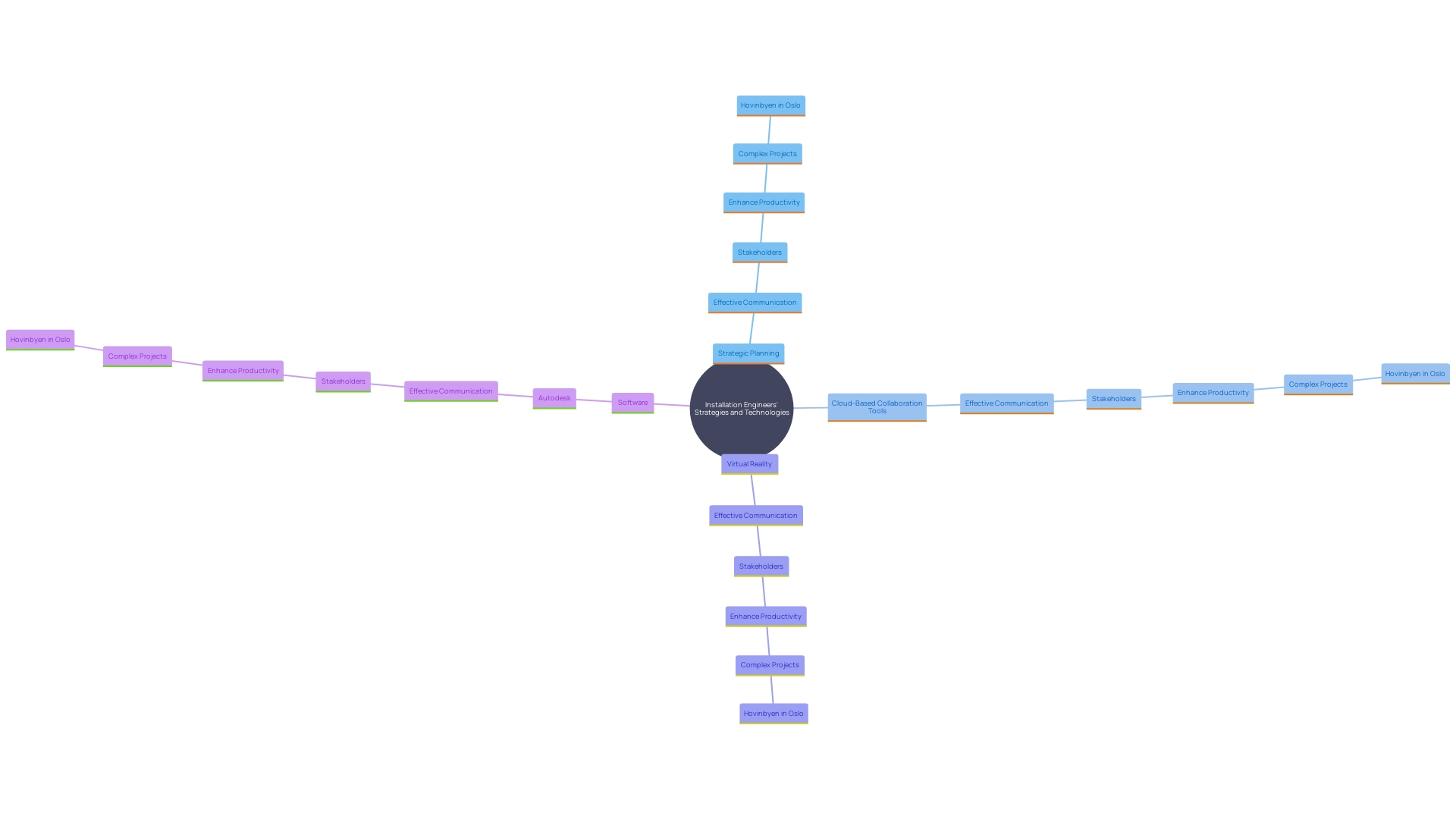
The Future of Installation Engineering in Infrastructure Development
As technology progresses, the role of installation specialists is experiencing a significant change. The incorporation of intelligent technologies and automation in development initiatives requires a change in their skill sets and knowledge base. For instance, the implementation of intelligent systems at Tianjin Port has reduced the need for manual labor by 60%, highlighting the importance of adopting new technologies. This shift not only improves efficiency but also enhances safety, as remote operation of trucks mitigates hazardous working conditions for drivers.
The use of AI in infrastructure initiatives, like those carried out with the Pennsylvania Department of Transportation, highlights the capability of machines to carry out tasks typically managed by professionals, thus speeding up project completion and enhancing accuracy. Ai’s capacity to examine extensive datasets and deliver practical insights can transform how professionals tackle intricate problems, resulting in better-informed decision-making and creative solutions.
Moreover, industry-wide initiatives like Tomorrow’s Engineers Week inspire the next generation by showcasing diverse engineering careers and the exciting possibilities within the field. This week-long event aims to engage over 50,000 students, emphasizing the alignment of their skills and passions with the evolving demands of engineering roles.
In conclusion, embracing innovation and continuous learning will be essential for installation professionals to remain relevant and effective. Investing in education and training programs, as emphasized by industry experts, will ensure that current and future engineers are equipped to handle the technological advancements shaping the industry’s future.
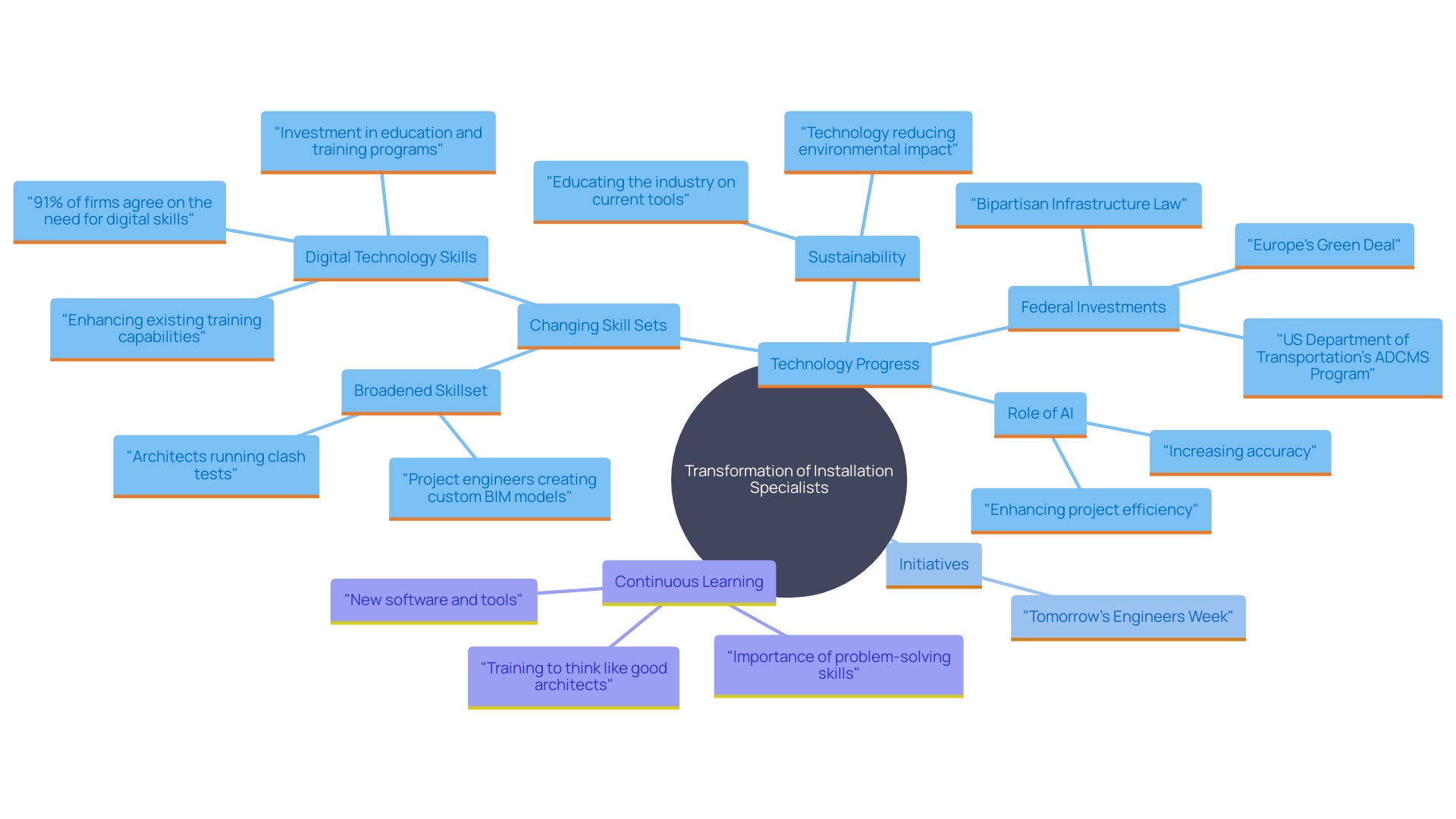
Conclusion
The role of installation engineers is undeniably critical in the realm of infrastructure development. Their meticulous planning and execution ensure that systems are seamlessly integrated, adhering to strict technical specifications and industry standards. The impact of effective installation engineering is evident in projects like the Troll B Flowline Replacement, where enhanced infrastructure can significantly boost production.
Furthermore, rigorous testing and comprehensive documentation not only advance technological capabilities but also bolster operational efficiency and safety.
Installation engineers shoulder a diverse array of responsibilities, from conducting detailed mechanical evaluations to providing expert consultation and ensuring safety compliance. Their ability to communicate effectively with project managers ensures that timelines are met and budgets are adhered to, while their troubleshooting skills maintain project integrity. By addressing common challenges and implementing strategic solutions, installation engineers play a vital role in mitigating delays and reducing costs, ultimately enhancing project quality and reliability.
Looking ahead, the integration of advanced technologies and smart systems will continue to shape the role of installation engineers. The adoption of tools such as virtual reality and AI is revolutionizing project management, allowing for improved efficiency and safety. As the industry evolves, fostering a culture of continuous learning and innovation will be crucial for installation engineers.
By investing in education and embracing new technologies, they will be well-equipped to navigate the complexities of future infrastructure projects, ensuring their contributions remain indispensable to the success of the industry.
Introduction
The rapid evolution of technology in law enforcement is reshaping the landscape of modern policing, driven by the imperative for enhanced operational efficiency, data management, and public safety. From predictive analytics and body-worn cameras to advanced communication systems, these innovations are becoming integral to contemporary policing practices worldwide. Notable examples, such as the AI-based Crime Nabi system in Belo Horizonte and the widespread adoption of body-worn cameras in the United States, demonstrate the transformative impact of technology on surveillance, crime prevention, and accountability.
This article delves into the multifaceted implications of technology adoption in law enforcement. It explores rigorous research methodologies used to evaluate the effectiveness of these technologies, the profound impact on policing strategies, and the challenges faced during implementation. Ethical considerations are also examined, emphasizing the need for robust guidelines and community engagement to ensure that technological advancements do not compromise individual rights.
By assessing the effectiveness of PD counter technologies through comprehensive data analysis and real-world case studies, the article provides valuable insights into balancing innovation with ethical responsibility, ultimately enhancing public safety and trust in law enforcement.
Background on Law Enforcement Technology Adoption
The swift incorporation of innovations in law practices is changing the environment of policing, motivated by the demand for improved operational efficiency, data handling, and public safety. Technologies such as predictive analytics, body-worn cameras, and advanced communication systems are now central to modern policing practices. For instance, the municipal police force in belo Horizonte, Brazil, has implemented Crime Nabi, an AI-based system that predicts likely crimes, significantly enhancing their surveillance and crime prevention measures.
Body-worn cameras have become ubiquitous, with thousands of police departments across the United States adopting them to increase accountability and transparency. ‘As stated by Michael D. White from Arizona State University, much of the footage captured by these cameras is rarely examined, but the emergence of tools that automatically assess this footage is starting to alter that, with the goal of enhancing public trust in law officials.’.
Moreover, companies like Polis Solutions are leveraging AI to evaluate the behavior of both officers and citizens during encounters, using body camera footage to provide insights into emotional intensity and other factors. Jonathan Wender, CEO of Polis Solutions, emphasizes the importance of mining this vast data source to enhance police-community interactions.
Virtual reality training systems, such as Wrap Reality™, offer immersive training scenarios that help officers de-escalate conflicts and apply appropriate use-of-force measures, leading to better performance in the field. These innovations, combined with meticulous evidence management solutions like Wrap Intrensic, ensure transparency and build trust in law agencies and the justice system.
As the acceptance of these cutting-edge innovations progresses, they pledge to transform law enforcement by offering instruments for enhanced decision-making, optimized resource distribution, and ultimately, safer neighborhoods.
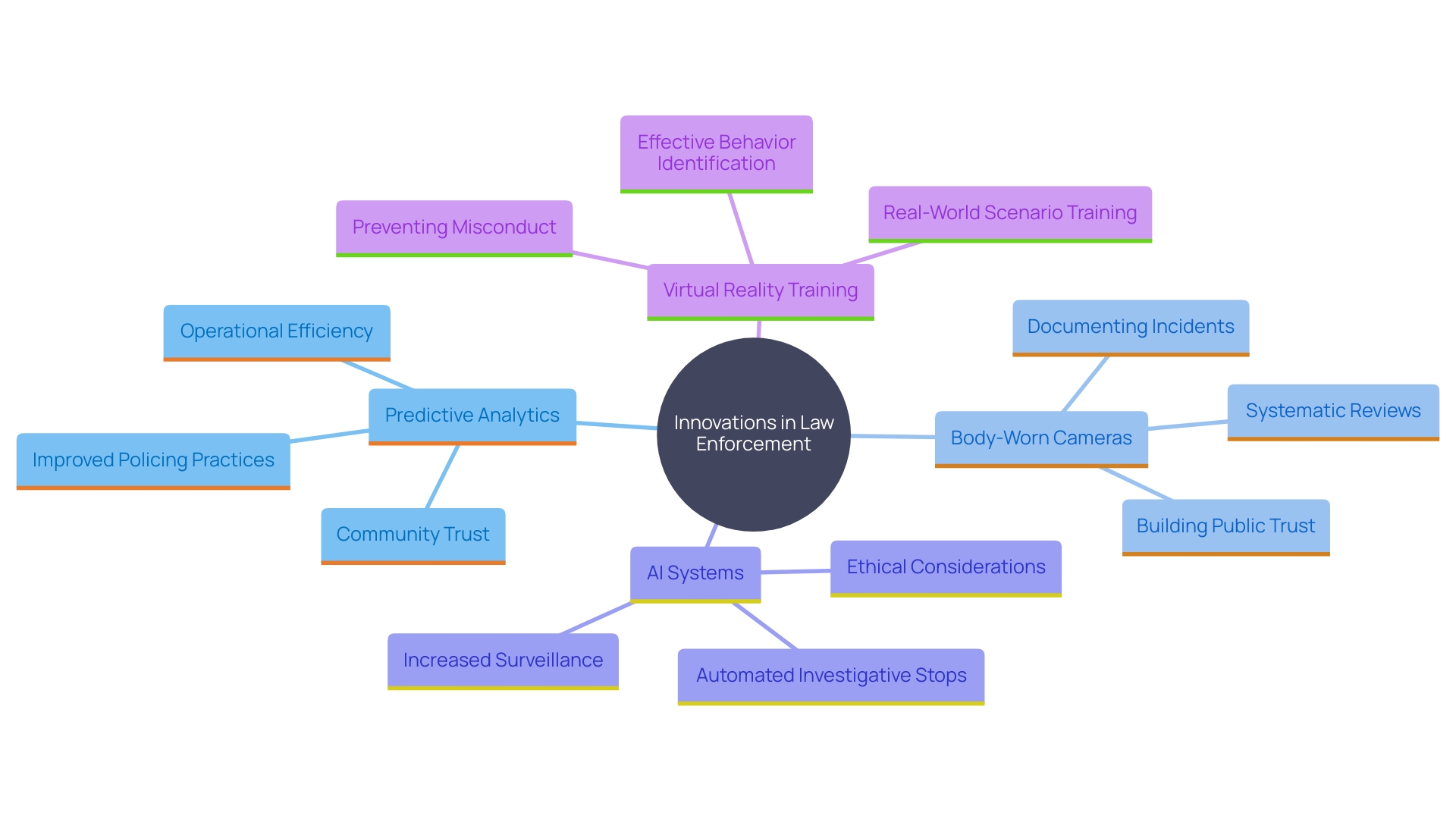
Case Study Methodology
This case study uses a rigorous research methodology, incorporating randomized controlled trials (RCTs), in-depth interviews, direct observation, and comprehensive data analysis. The study involves three police departments: the Casa Grande Police Department, the Apache Junction Police Department, and the Arizona Department of Public Safety. By collaborating with law enforcement personnel, service providers, and community stakeholders, the research aims to assess the viability and effectiveness of PD counter solutions.
The RCTs carried out at the smaller agencies have been in progress for several months, concentrating on whether the innovation is accepted by officers and supervisors and its potential to affect their behavior in the field. Interviews and surveys with officers, supervisors, and leadership offer understanding into the system’s operational impact and user experience. Furthermore, a key informant approach involving professionals from Texas and New Jersey offers additional perspectives on the efficacy and implementation challenges of similar protective measures.
The information gathered will offer an extensive perspective on the operational impact, user experience, and public perceptions concerning these innovations. The ultimate goal is to enhance community trust through increased accountability and transparency, as evidenced by the mixed results of body-worn cameras and their impact on police-community relations. The study will inform decision-makers on whether to sustain, modify, or scale up such initiatives, contributing to the broader effort to improve public safety and police practices.
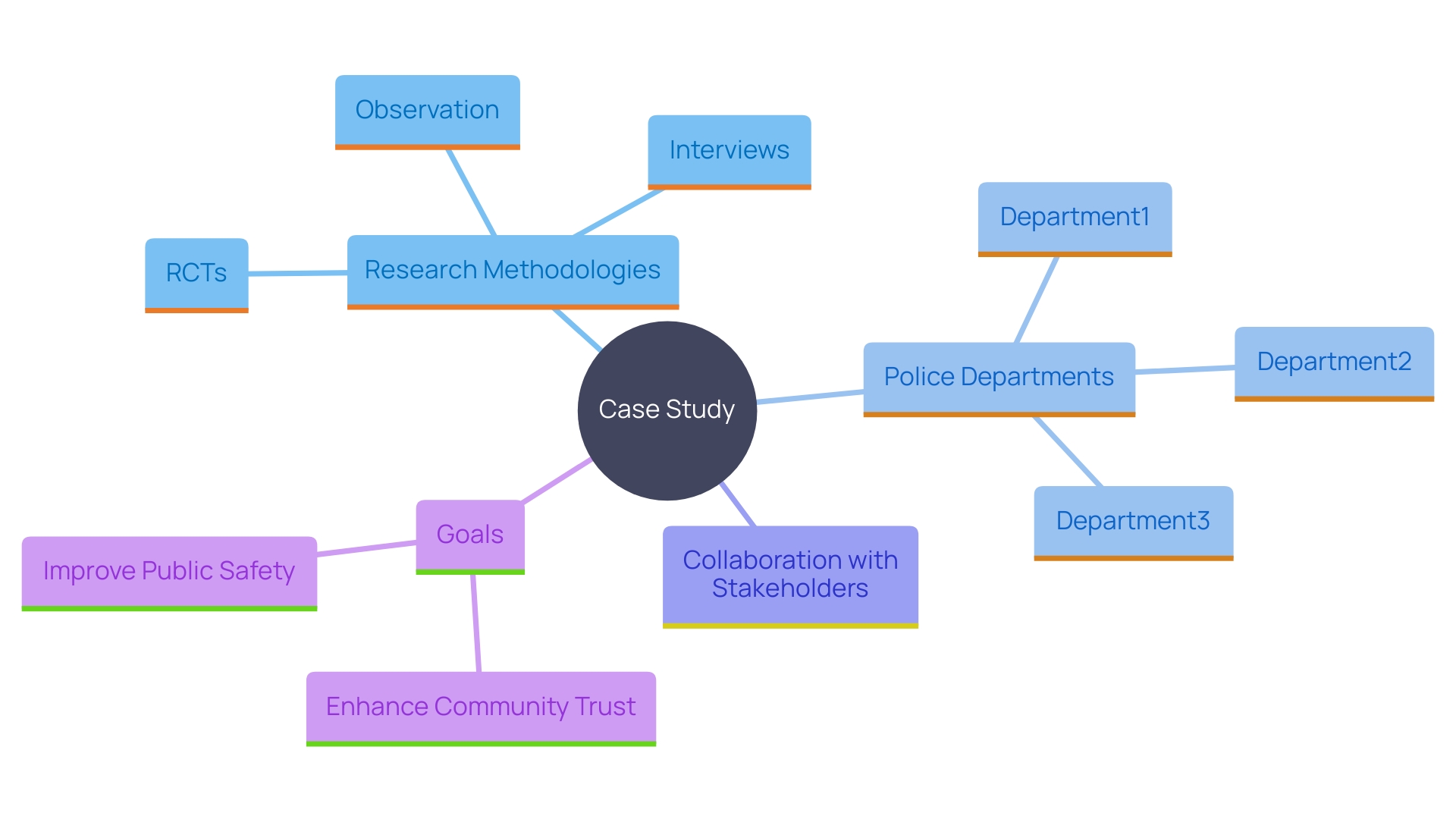
Impact of Technology on Policing Strategies
The incorporation of PD counter methods has transformed conventional policing approaches. Real-time crime mapping and data analytics empower officers to pinpoint crime hotspots and allocate resources with precision. This proactive method significantly enhances situational awareness, allowing law agencies to swiftly tackle emerging threats. The New York Police Department’s Real-Time Crime Center, established in 2005, stands as a pioneering example. With a network of several thousand integrated public and private cameras, it serves 77 precincts and supports 36,000 officers. This initiative, motivated by the 9/11 attacks, highlights the transformative impact of innovation in policing. Case studies from different regions, including New York’s fusion centers, illustrate how these innovations have resulted in significant decreases in crime rates and encouraged better relations among residents. As NYPD’s efforts demonstrate, incorporating the appropriate tools and expertise can transform policing, ensuring enhanced safety and cooperation between law enforcement and the community.

Challenges in Implementing PD Counter Technologies
Implementing PD counter methods encounters several challenges that necessitate strategic planning and stakeholder involvement for successful deployment. Budget constraints often limit the capacity to adopt new advancements, while resistance to change among personnel can slow down integration efforts. Adequate training is crucial to guarantee the efficient application of these tools, but it can be expensive and require a significant amount of time.
Data privacy and ethical considerations also play a significant role in shaping public trust. For instance, the controversy surrounding the ShotSpotter system in Chicago highlights how concerns over accuracy, expense, and potential biases can lead to public skepticism and operational challenges. Regardless of these challenges, supporters contend that such innovations can assist law enforcement in addressing gun violence more efficiently, as demonstrated by the Manchester incident where ShotSpotter notifications resulted in the capture of a person with several firearms.
To address these challenges, it’s crucial to establish robust governance frameworks and best practices. This includes establishing technical, procedural, and disclosure standards for systems like facial recognition, which should be guided by rigorous testing and evaluation to enhance accuracy and reduce demographic differentials. Furthermore, federal privacy regulations related to these advancements can help reduce risks and safeguard civil liberties.
Ultimately, balancing innovation with ethical responsibility and transparency is essential to maintaining public trust and ensuring the effective use of PD counter tools in law policing.
Ethical Considerations in Using Advanced Technologies
The incorporation of sophisticated innovations in policing presents considerable ethical dilemmas. Issues surrounding surveillance, data ownership, and biases in algorithmic decision-making are at the forefront. Law enforcement agencies must establish robust ethical guidelines and accountability measures to ensure that advancements enhance public safety without compromising individual rights.
A prime example is the widespread adoption of body-worn cameras by police departments across the U.S., initially aimed at building public trust. Nevertheless, these innovations, including algorithmic monitoring tools, frequently function as inadequately structured trials on human participants, especially in low-income populations of color. It’s crucial to view these tools as experiments to develop prospective controls and evaluations that balance innovation with ethical responsibility.
Community engagement is essential in shaping these policies. As emphasized in the recent RAND Corporation report, long-term relationship building between police and communities is essential for enhancing relations and ensuring ethical use of tools. Groups most impacted by these advancements should have a voice in their implementation and hold authorities responsible.
As noted by experts, “Communities, particularly those most affected by the misuse of these tools, should have a say in how they are deployed and hold law enforcement agencies accountable for their actions. In the quest for public safety, we cannot afford to sacrifice the very principles that underpin a just and equitable society.”
Incorporating community input and ensuring transparency and accountability will help maintain the delicate balance between public safety and individual rights, making advanced technologies a force for good rather than a threat to fundamental rights.
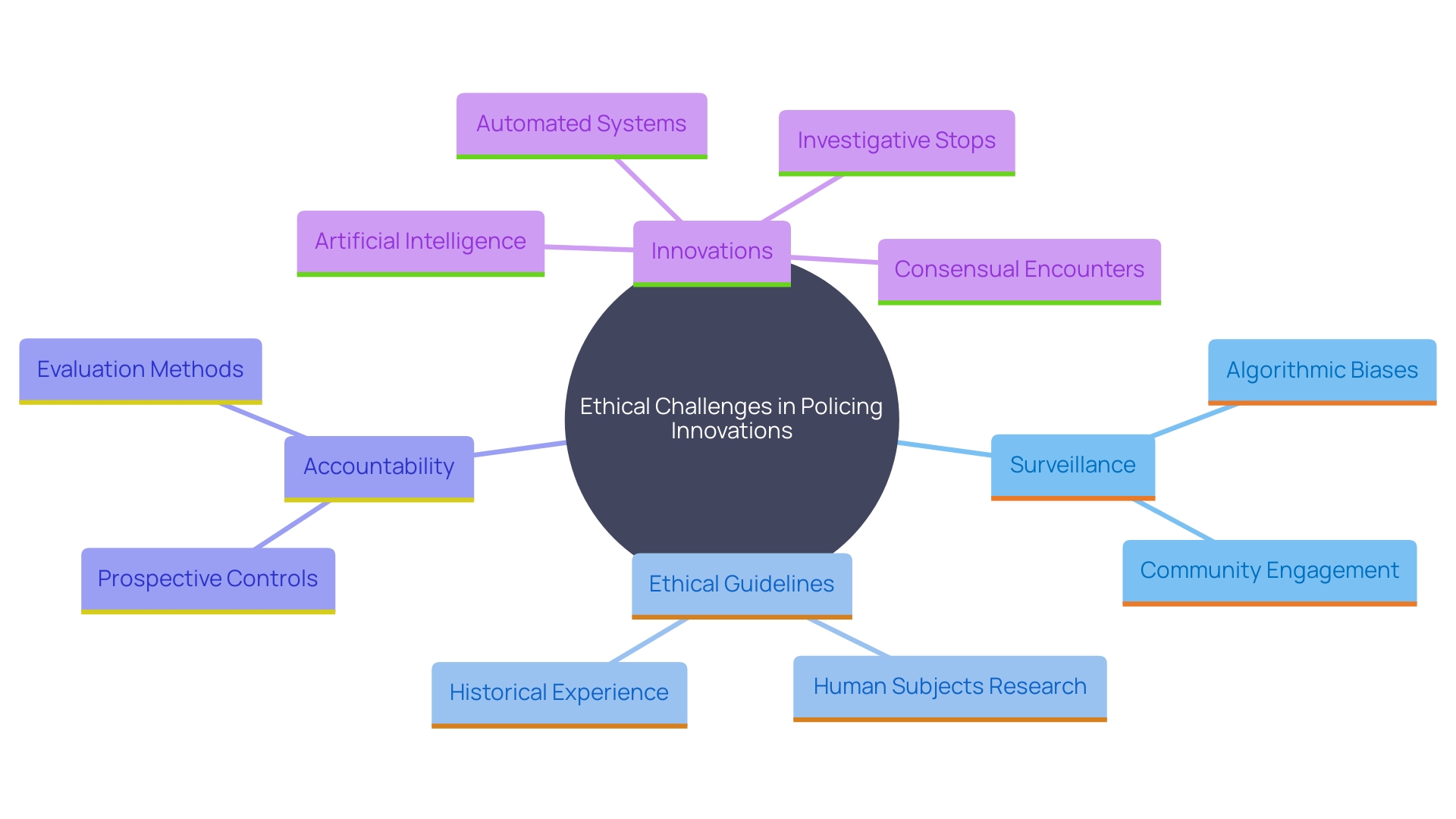
Evaluating the Effectiveness of PD Counter Technologies
Evaluating the effectiveness of PD counter measures involves analyzing various performance metrics, including crime statistics, response times, and community satisfaction. For example, a thorough study including more than 15 years of crime, calls for assistance, and police enforcement information assessed the ShotSpotter system in Chicago and Kansas City. This research, the most extensive of its type, employed a matched quasi-experiment to compare ShotSpotter-covered regions to similar control regions lacking the system. Results showed significant improvements; for example, in a 12-month pilot project in Durham, ShotSpotter more than doubled gunshot notifications and reduced median police response times by 1.2 minutes. Ongoing assessment and feedback cycles are essential for adjusting and improving the application of tools in policing, making certain it corresponds with the changing requirements of the community. As Brandon del Pozo of Brown University notes, the integration of evidence-based innovations into routine practice is crucial for the sustainable adoption of new technologies in police settings.
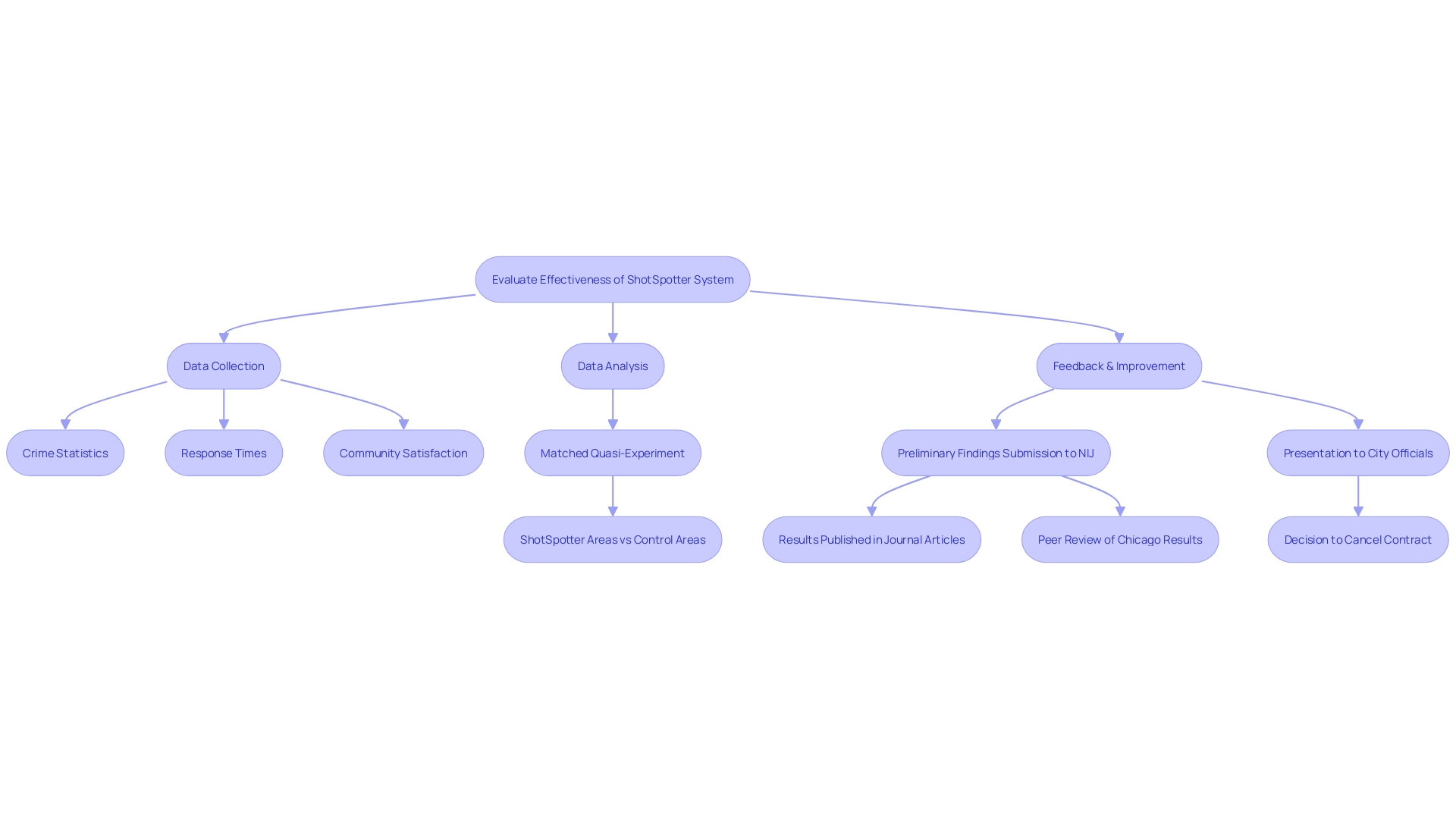
Conclusion
The integration of technology in law enforcement represents a pivotal shift in how policing is conducted, emphasizing the need for enhanced operational efficiency, data management, and public safety. Innovations such as predictive analytics, body-worn cameras, and advanced communication systems have not only transformed traditional policing strategies but also significantly improved accountability and transparency. By utilizing comprehensive methodologies to evaluate these technologies, law enforcement agencies can better understand their impact on community relations and operational effectiveness.
However, the adoption of these advanced technologies is not without its challenges. Budget constraints, personnel resistance, and ethical considerations surrounding data privacy and algorithmic biases must be addressed to foster public trust. Establishing robust governance frameworks and engaging communities in the conversation about technology deployment can mitigate potential risks and enhance the overall effectiveness of law enforcement initiatives.
Ultimately, the successful integration of technology in policing hinges on a commitment to ethical responsibility and transparency. By prioritizing community engagement and accountability, law enforcement agencies can navigate the complexities of modern policing while ensuring that public safety measures do not compromise individual rights. Embracing these principles will not only strengthen the relationship between law enforcement and the communities they serve but also pave the way for a more just and equitable society.
